

25 Road Trip Hacks when Traveling with Dogs in Cars
Road trips are one of the easiest and funnest ways to travel. Plus, they’re a great option for dog owners, since dogs of all shapes and sizes can ride in a car. Whether your trip is hours long or days long, there are things you can do to make life on the road a little bit easier for both you and your dog. Check out these 25 road trip hacks for when you’re riding with your dog.
Article Contents
1. Get Astroturf

If you’re traveling with dogs, and you want to protect your car from hair and dirt, consider Astroturf.
Astroturf is a synthetic material that looks like fake grass. It’s usually found on sports fields or walkways.
But it works great for dogs and cars too! Purchase a cheap roll of Astroturf at your local hardware store, measure your space, and cut it to fit.
The Astroturf provides your dogs with something to grip on, so they won’t slide around in the back. It’s great for traction, and it’s easy to put on and remove.
It’ll also catch all the debris – like dirt, fur or gravel – that your dog will inevitably track in. It’s just a matter of shaking it off to clean it, or giving it a quick spray of water. And remember, it’s a synthetic material, so it’ll dry super quick.
Get Astroturf here .
Bonus: if you’re into messy outdoor activities – hiking, camping, going to the beach, etc. – it’ll be great for you and your gear too!
2. Use a spill-proof bowl

You have to stay hydrated while on the road.
Ideally, you’ll want to stop for water breaks, and drink al fresco. But if you’re staying in the car, either due to time constraints, bad weather, or because it’s dark out, you’ll want to serve up that fresh H2O in a spill proof bowl.
Spill proof bowls ensure your dog won’t get water everywhere or drench your car in dog drool.
Keep one on hand for mess free feedings, so your dog stays hydrated while your car stays clean.
Get the no spill bowl here .
3. Keep all your dog’s important documents in a waterproof, sealable Ziploc bag
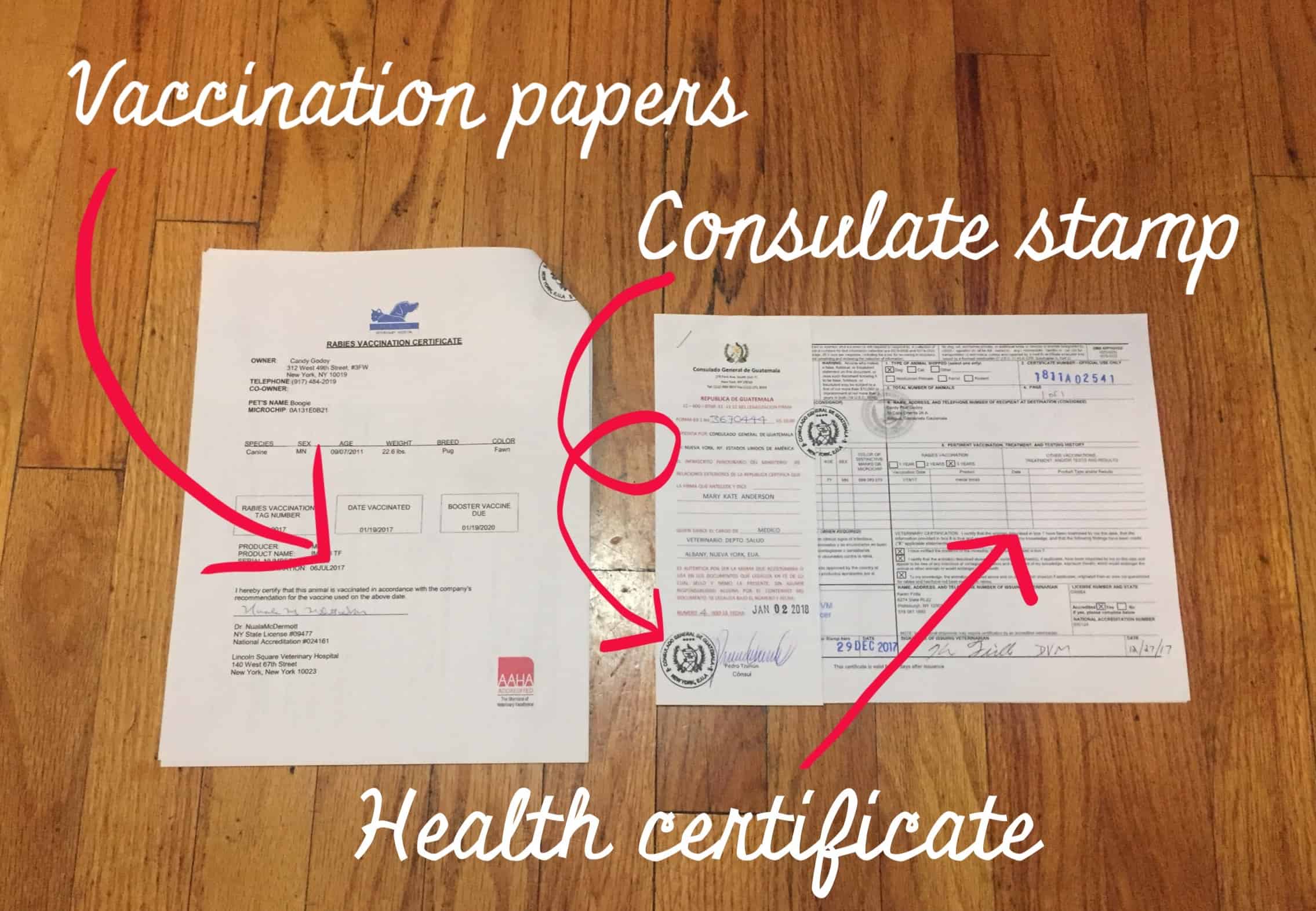
When you’re traveling with your dog, it’s important to keep vital documents, like medical records, extra copies, and ID information, on hand, especially if you’re crossing state lines.
And when there are muddy paws, dirty shoes, and the potential for spills, you’ll want to be sure these documents stay clean and dry.
Keep them safe in a waterproof and sealable ziplock bag. This is easy to throw it in a backpack or the glove compartment, and means you won’t have to worry about keeping them readable.
4. Use seat covers or a blanket
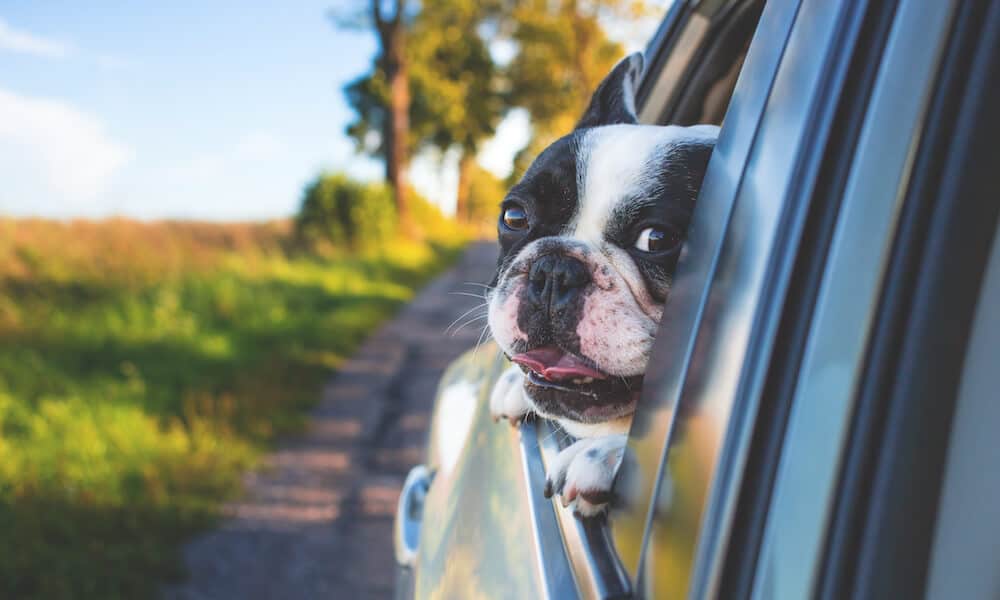
Dog hair and seat scratches are easily preventable by keeping seat covers or a blanket on hand. They both protect your car and make it easy to shake off loose fur and debris.
They’re especially useful if you’re renting a car. Who doesn’t love an easy clean up?
Bonus: get waterproof seat covers to make your ride even smoother – there’ll be no need to worry about wet dogs!
Get seat covers here .
5. A crate, car seat, and/or seatbelt are necessary
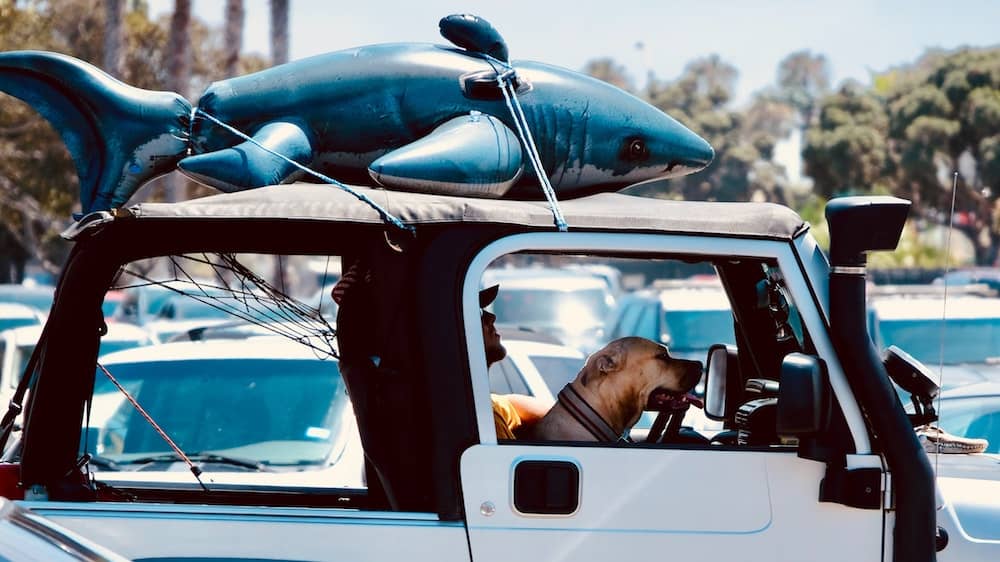
Safety is important when you’re on the road. If you stop short, slam on the brakes, or get into an accident, your dog can get seriously hurt.
To protect your dog, make sure to secure them while in the vehicle.
For medium to large dogs, try a crate or dog seatbelt. For smaller dogs, check out car seats.
Consider collapsible travel crates , no matter your dog’s size, which double as in-car restraint systems and a dog suite in your hotel room or campsite.
6. Use a pet ramp for easy access
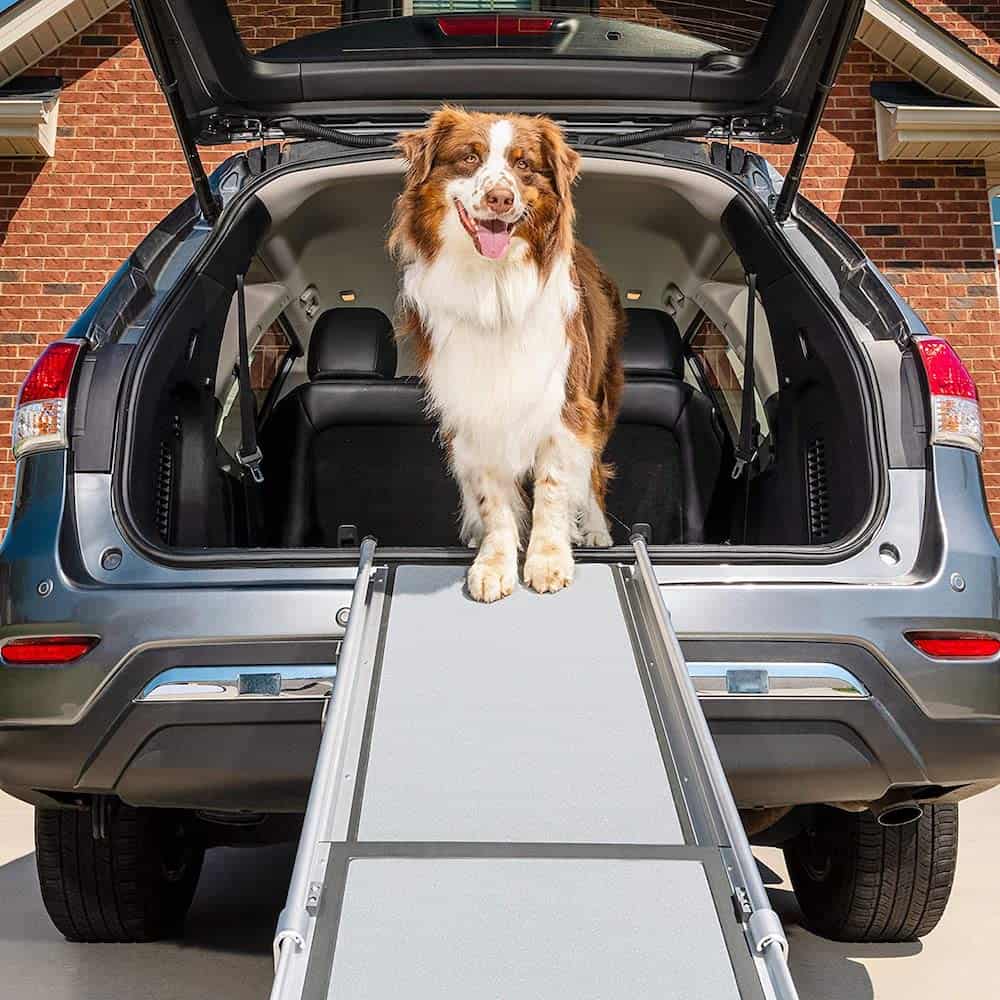
Some dogs, like older pets or dogs with mobility issues, might have trouble getting in and out of the car. Carrying them isn’t really an option if they’re big, or if your hands are full.
A pet ramp is a great option to help with easy load ins and outs.
This one is adjustable, works with all sizes of vehicle, and can withstand up to 400 pounds. Its high traction surface prevents slips and falls. Plus, the ramp is easy to carry – it’s only 13 pounds – and easy to store.
7. Use up to date dog tags

Up to date dog tags are important in your dog’s daily life, and especially while traveling.
They signify to others that your pet has a home. They’ll protect your pet from being mistaken as a stray, and make it easy for people to contact you should anything happen.
My dog’s tags have their name, my email address, and my phone number. Some might choose to include their home address as well.
Be sure your pet is microchipped too!
8. Use a travel pet food container
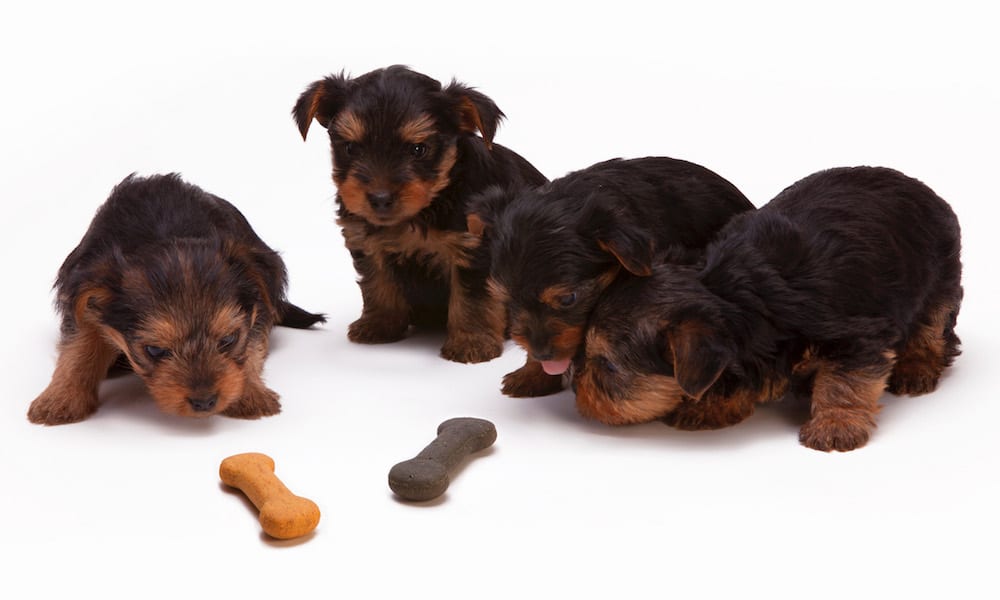
Throwing some kibble in a Ziploc bag sounds easy, but if you turn your back for a few minutes, your dog will sniff it out and rip right through it.
This kibble carrier keeps meals fresh and can hold up to five pounds of food. I love that it rolls down and clips securely, making it malleable so it changes size depending on how much food I pack.
This travel container is also great, especially on camping trips and long car rides. It includes two detachable bowls to serve food and water, and features an easy to carry handle.
9. Pack the right clean up tools
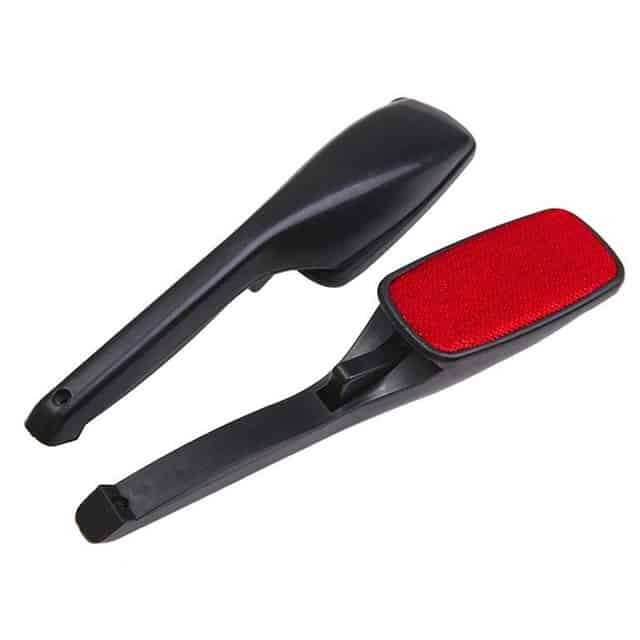
A road trip converts your car into a make shift home; you’ll be using it to eat, sleep and hang out. With all of that extra time in your vehicle, it won’t be smelling too fresh by the end of the day. Add one or two dogs, dirt and mud from outdoor excursions, and plenty of spills, and you’ve got yourself a locker room on wheels.
But who wants to travel in a dirty car? Not me! Especially if it’s a rental, and fees are involved. Keep your car clean and pack the right tools to help you.
This hair-removing silicone brush is great at loosening pet fur lodged in your car’s carpets and seats. It’s also small enough to keep in your glove compartment or to throw in a bag.
For a more thorough clean up, consider a vacuum. This handheld cordless vacuum will suck up all of the fur, sand and dirt tracked in from your dog, plus it comes in an easy to store bag.
It’s lightweight and portable, so perfect for road trips.
10. Stay shady
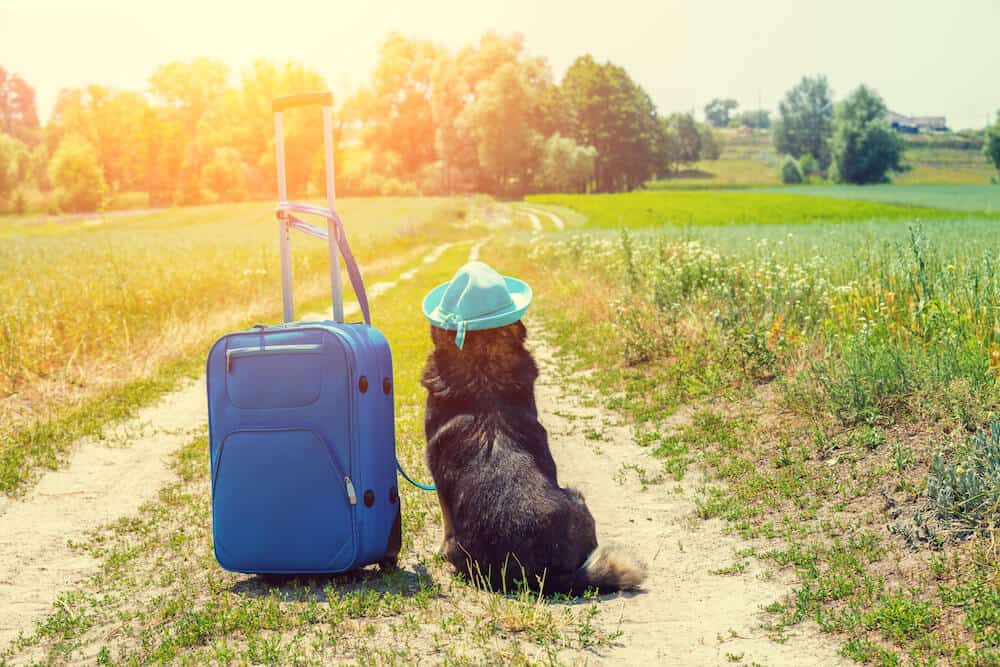
Driving on a hot day? Sunlight will heat up the interior of your car and turn your vehicle into an oven. It’ll dehydrate you and your dog, and make car rides uncomfortable.
Keep your car, whether on the road or parked, cool and stay shady.
This car window sun shade blocks over 97% of harmful UV Rays. It fits most car windows.
If your dog sits in the back (they should!), try these rear seat air fans . They plug into your cars’ cigarette lighter and help keep your pet cool on even the hottest of days.
11. Stay hydrated

Long hours on the road, especially on a hot day, can lead to dehydration.
While you’ll want to take frequent water breaks, sometimes, due to weather or time of day, you won’t be able to stop the car.
This dog water bottle fits right in the car cupholder, and dispenses water with a squeeze. It’ll make grabbing a quick lick easy while on the road.
12. Pet First Aid kits are a must
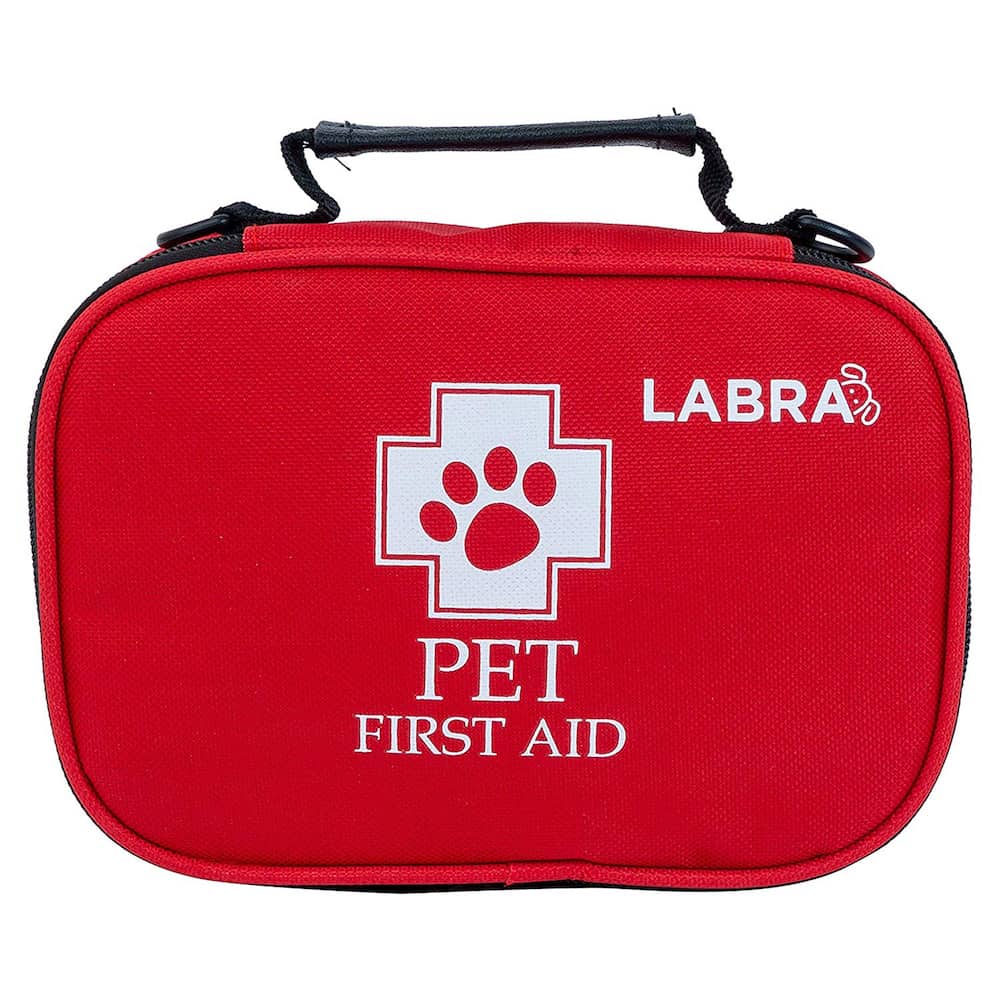
Every car needs a dog first aid kit to use in case of emergency.
You’ll be prepared for injuries and be able to treat cuts, scrapes, sprains and strains, no matter where you are. It’s always better to be safe than sorry.
This useful K9 First aid Kit is compact, sells for a reasonable price, and has all of the essentials. It includes scissors, tweezers, a pet brush, a pair of rubber gloves, antiseptic cleaning wipes, and more.
Or, save money and make your own with a few items from around the house.
Grab a container – a ziplock, drawstring bag or Tupperware works – and throw in the following:
- Hydrogen peroxide
- Antibiotic ointment
- Rubber Gloves
- Wet or Grooming Wipes
13. Be organized
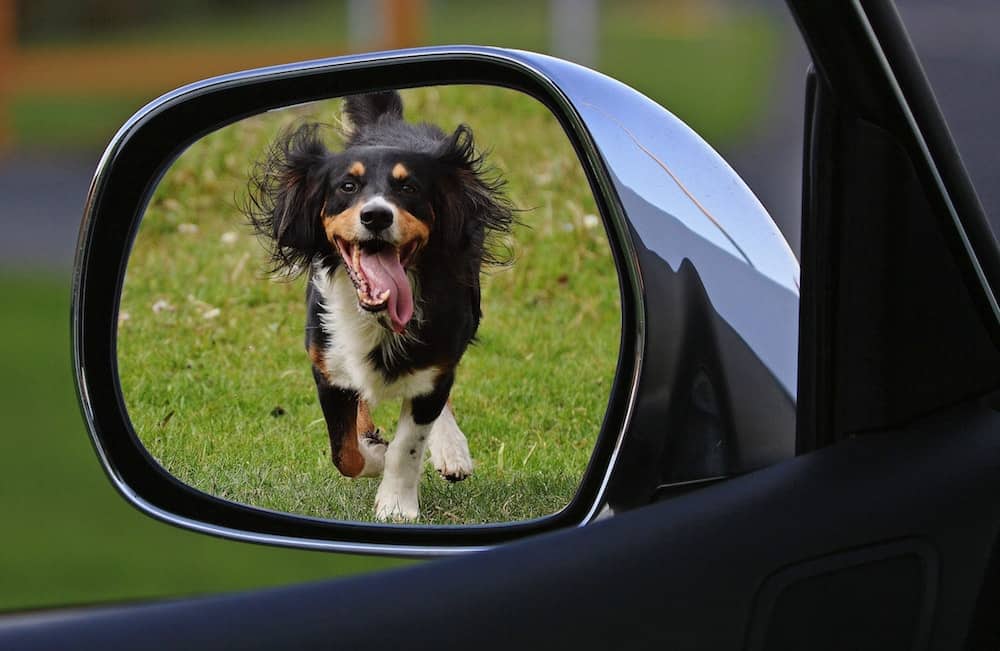
Throwing things in your car feels great until you’ve created a mountain of mess and can’t find something. Avoid this problem entirely by getting organized from the get go.
This strap in collapsible trunk organizer helps you neatly store all of your gear into sturdy, yet flexible compartments. Use it in half mode or open mode, depending on how much stuff you have.
I’m also digging this trunk divider that attaches with velcro and fits into even the most weirdly-shaped nooks of your car. It’s an easy way to secure loose clutter in the back.
14. Keep a packing list

Planning a road trip can be daunting, but you won’t have to worry about leaving things behind if you’ve got a good packing list to refer to.
This packing list works at the beginning of a trip, when you’re packing your bag, and throughout, to make sure you don’t leave anything behind.
Check out our dog travel checklist , and print out a copy for yourself.
15. Map out dog-friendly places to stop along the way

What’s a road trip without fun stops along the way? But with a dog in tow, not every location will be welcoming.
Before heading out, map out dog-friendly stops along your route, so you’re not totally clueless when it comes to breaks. It’ll make potty breaks or activities along the way easier and better.
Plus, doing a bit of research before the trip will help you discover dog-friendly places you never even knew existed.
Here are some helpful places where you and your dog will be welcome:
- The Best Dog-Friendly Places to Stay on a U.S. Road Trip
- Guide to the Ultimate Road Trip with your Dog
16. Soothe nervous dogs
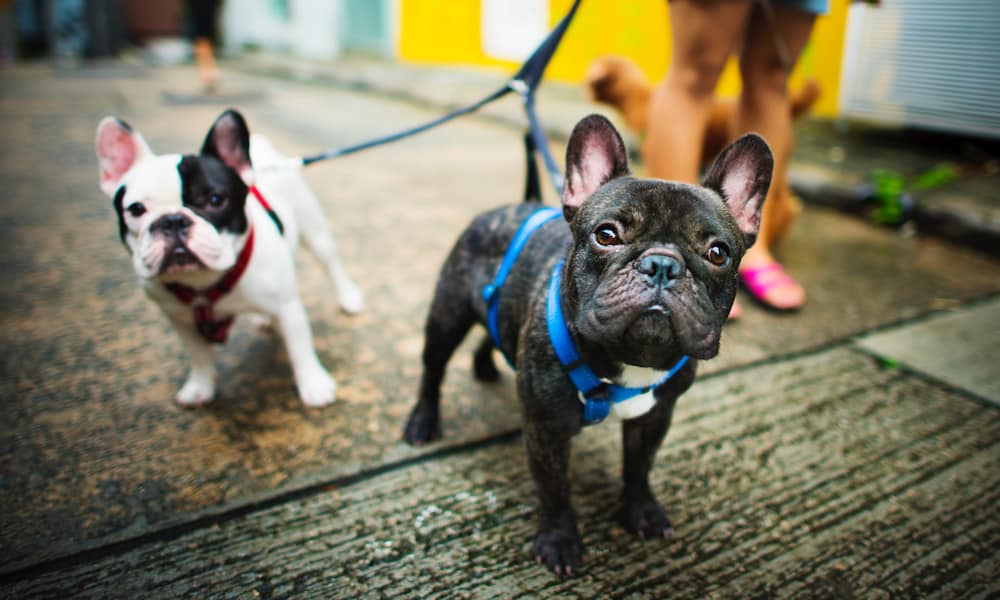
If your dog is nervous in the car, help soothe them so that they can rest and get comfortable.
Here are some tips for road tripping with a nervous dog:
- Bring along your dog’s favorite items, so they have familiar objects around from home. A favorite toy, dog bed or blanket with your scent.
- Put your dog in a thunder jacket; they apply constant pressure on a dog’s torso, similar to a parent swaddling a child.
- Experiment with CBD oil or CBD treats to help your dog remain calm.
- Make sure the car is comfortable and cool – crank the air conditioning and make their crate or the backseat nice and comfy.
- Do shorter rides with a great reward at the end before embarking on a longer trip.
17. Get rid of that wet dog smell

If you’re planning outdoor adventures like hiking or swimming, your dog is guaranteed to get wet and muddy. While that wet dog must is ok around the campfire, it’s not great once it infiltrates your car.
This bamboo charcoal car air freshener naturally absorbs odor like a stink sponge. It’s long lasting and fragrance free, and totally safe for your pets.
18. Keep supplies on hand for dirty paws
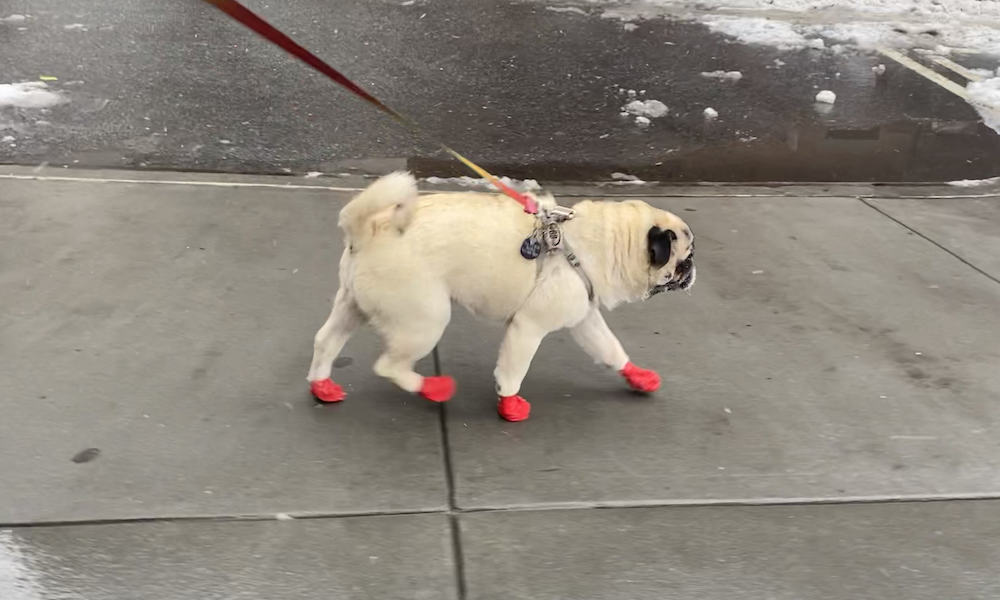
Just as you should wipe off or remove your dirty hiking boots after a trek, do the same for your dog. Dog paws can track in dirt, sand, mud and water that’ll get all over your car.
Keep some supplies on hand to prevent too much mess. A quick dry towel or grooming wipes should do the trick.
Or, make your dog wear dog boots ! They’ll keep your dog’s paws clean and you can take them off before getting in the car.
19. Download helpful apps

There are plenty of apps that can help when on the road with your dog. It’s gotten a lot easier than when I used to travel the world sans iPhone.
- BringFido: This app (and website!) helps you locate pet-friendly hotels, restaurants, parks and activities.
- DogTrekker: DogTrekkers lists dog-friendly places to stay, eat, hike, swim and have fun throughout the state of California.
- USA Rest Stops: This app helps you find the nearest rest stop. It’s great for water and potty breaks.
- Roadtrippers: Roadtrippers offers planning, maps and travel guides for road trips. It’s especially great if you’re camping – you can book campgrounds directly in the app.
- Sniffspot: Sniffspot showcases safe and private dog parks and off leash areas hosted by locals. It was made for reactive dogs, but any dog can use it. Find locations that work for you and book for some play time.
If you’re looking for more, check out this list of the best dog apps available for iOs and Android! We’ve also got a list of our favorite dog podcasts .
20. Plan ahead

Jumping in a car and driving wherever the wind takes you sounds romantic, but it’s not really very practical. You don’t want to be stuck with no place to stay.
Plan ahead! It’s an especially good idea if you prefer the comforts of a hotel or motel, rather than a campsite. Some places don’t allow dogs, while others have weight limits, breed restrictions or big fat pet fees.
Here’s a list of questions to ask dog-friendly hotels, and here’s another with the best dog-friendly places to stay on a road trip .
21. Keep fleas away

If you’re planning to hike or spend time in the woods, you’ll want to be certain your dog has flea, tick and heart worm medication. It would be terrible to pick up fleas, and get them in your car! Plus, they can be dangerous and cause health issues like lime disease.
We tend to pick up organic flea collars before going on a trip. They’re great to have in handy and safer than alternatives. Earth Animal also sells a flea and tick internal powder that comes highly recommended.
22. Reward your dog with a treat along the way!
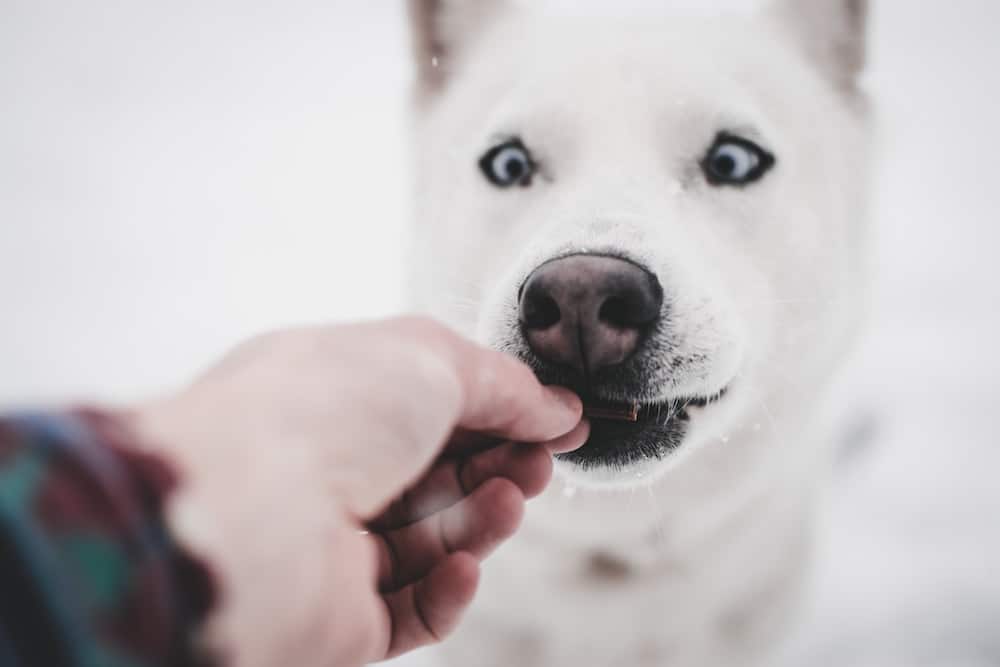
Road trips are fun, and your dog should be in on it. The car is a happy place! It’s taking you to new places, and on new adventures.
Remind your dog of this with positive reinforcement and treats.
When you’re on the road, stop at chains like Dairy Queen and Starbucks; both offer dog treats that you can pick up at the drive through. Dairy Queen has pup cups, and Starbucks has puppucinos .
23. Tired dogs are the best travelers

This is my number one piece of travel advice, whether you’re flying, road tripping or on a train.
Zoomies and a case of the wiggles are best left for wide open spaces. Confined spaces, like a car, mean your dog won’t be able to stretch their legs.
Make sure your dog gets a lot of exercise before doing a long stretch in the car, or stop along the way so they can run around. It’ll make your dog feel better, and make for a much more comfortable trip, for both you and your pup.
24. Use bottled water if you’re crossing state lines
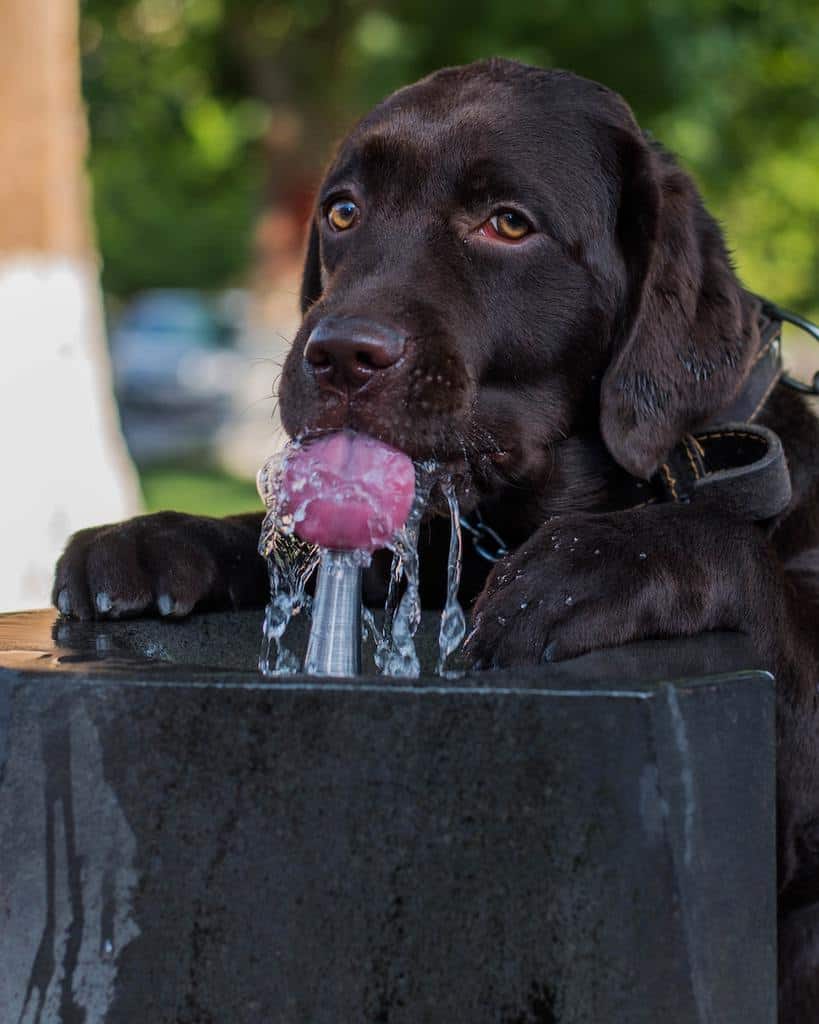
This is a trick I learned from show dogs who have to travel to compete.
Tap water is different in every place, especially when you cross state lines. The change in levels of things like chlorine can upset your dog’s digestion and cause diarrhea.
Take your own water from home, or buy bottled water.
If you bring your own water, gradually add some of the new water to the water from home, or just stick to bottled water the entire time to be safe.
We bought jugs of water at Costco and Walmart and just always kept extras in our trunk. Problem solved!
25. Bring a headlamp to pick up poop in the dark

Let’s be real, picking up dog poop in the dark is a drag.
Sure, you can use your cell phone as a flashlight, but that means you’ll have to do the one handed poop pick up, while you also hold a dog leash and bend over. What a mess!
The chances of falling, tripping or dropping your phone into some fresh poop are high.
And if you’re in a wooded area with grass? Even worse. Camouflaged poop is extra hard to find.
Free up your hands and be prepared with a headlamp! That way you can easily spot the fresh turds all while using both hands. Plus, you can use it for other stuff while in the dark. Stuff that hopefully doesn’t involve poo.
Here are some rechargeable headlamps that come highly rated.
Related:
- Rental Car Company Pet Policies
- This Is The Only Insurance Company That Will Cover Your Pet While Traveling
What other tips do you have for dog-friendly road trips? Let us know in the comments.
Pin for later!

Similar Posts

Dog Halloween Costumes for Every Type of Dog Owner
Halloween is a pups time to shine! It’s a holiday meant for dogs. Here are dog Halloween costume ideas to match every type of dog owner.

DIY Meatloaf Dog Birthday Cake Recipe
This homemade dog birthday cake will make your dogs mouth water! It’s easy to make and healthy, so you won’t feel guilty about serving them cake for dinner.

How I Learned Portuguese: Tips for Learning a New Language
Here are tips on how to learn Portuguese – or any language – so you too can enjoy being multi-lingual and build deeper connections.
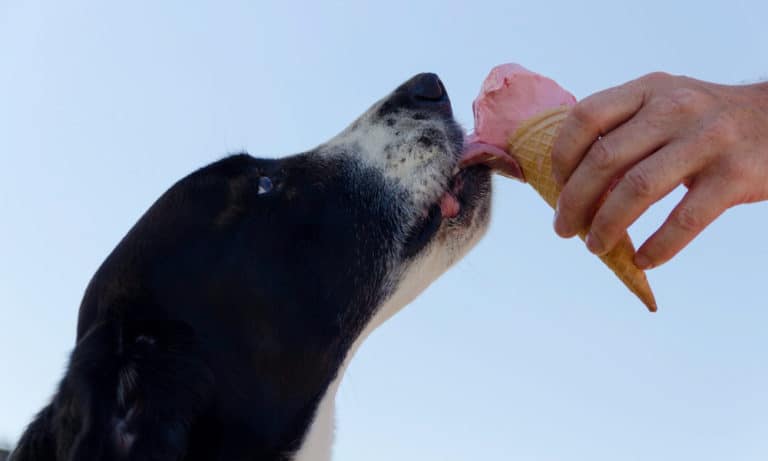
The Easiest Dog Ice Cream You’ll Ever Make
The is the best dog ice cream recipe you’ll find on the web. It’s easy, tasty, and human friendly! Make it for both you and your pup to enjoy.

The Ultimate NYC Fall Bucket List for Dog Lovers
There’s nothing like Autumn in New York! Here are the best dog-friendly things to do in New York City this fall.

The 11 Best Things to Do in Paraty, Brazil
Paraty is the quintessential sleepy Brazilian town that will charm your socks off. Here are the 11 best things to do in Paraty.
GREAT article. thanks
Leave a Reply Cancel reply
Your email address will not be published. Required fields are marked *
Where Have We Been

Dog-Friendly New York City Dog-Friendly Brazil Dog-Friendly Boston Dog-Friendly Philadelphia Dog-Friendly Baltimore
Check It Out
About Privacy Policy Disclosure & Disclaimer Contact
Looking For Something?
Affiliates disclosure.
boogiethepug.com is a participant in the Amazon Services LLC Associates Program, an affiliate advertising program designed to provide a means for website owners to earn advertising fees by advertising and linking to amazon.com, audible.com, and any other website that may be affiliated with Amazon Service LLC Associates Program. As an Amazon Associate, the owner of this site earns a commission from qualifying purchases.
Travel Tips
Get Inspired How To Save For A Trip How To Plan A Dog-Friendly Trip Flying With Your Pet Get The Right Dog Gear Pet Friendly Accommodations Pet Friendly Destinations Roadtrips With Your Pet
Get the Latest Woof in Pet Travel

How to Travel With a Dog in a Car: An Expert Guide
Heading out on the road with your dog soon? Read this guide first to make sure the car ride is an enjoyable, safe experience.
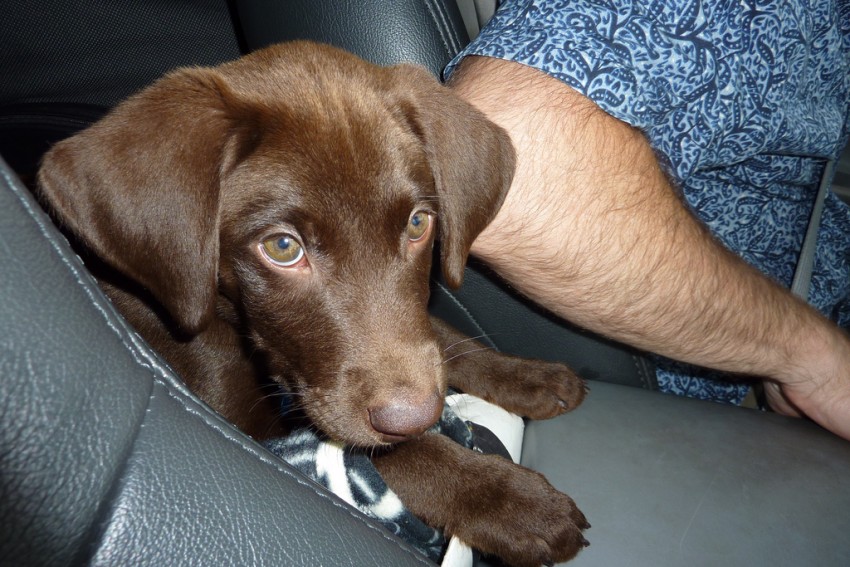
Planning on taking your dog on the road with you?
If so, you may be wondering how to travel with a dog in car — safely and smoothly.
Before you start your trip, read the tips below.
In this expert guide to traveling with a dog in a car, we’ll cover:
- How to keep your dog safe
- Which harnesses or carriers are best for dogs in cars
- Tips for taking a dog on longer trips in a car
- What about letting a dog ride in the back of a pickup truck?
- How you can prevent motion sickness in your dog before a car ride
- And much more!
So buckle up, and let’s begin…
Part 1: How to Keep Your Dog Safe in the Car
Prevent a tragedy — vow right now to make sure your dog is properly restrained whenever you take them with you in the car.
The expense and slight inconvenience of using the appropriate vehicle safety items is well worth the risk.
Plus, restraining the dog also keeps them from moving around the car and distracting you while you’re driving.
Safely Restraining Your Dog in a Car
Dog harness.
First, get a harness for your dog.
If you restrain your dog using only a collar, your pet may get strangled if you get into a wreck, especially if you rear-end someone. A harness may protect the dog’s neck and spine.
We prefer fabric harnesses that wrap around the dog’s neck and torso. Many also have a loop on the top through which you can thread the seat belt.
The PoyPet No-Pull Dog Harness has a reflective vest, a leash connection on both the front and back, and (last we checked) was less than $20. Worth every penny.
Dog seat belts attach to harnesses, keeping your dog immobilized in the back seat.
There are 2 basic models:
- Those that attach to your car’s seat belt
- Those that clip into the “female” end of the seat belt lock
Either kind will work. Choose the one that works best for your car.
This strap from PetSafe is adjustable and easy to use.
Remember: Don’t attach the seat belt to your dog’s collar — attach it to the dog’s harness instead, to avoid strangulation.
Booster Seat
A small dog who loves to look out the car window will enjoy having a booster seat.
Was YOUR Pet Food Recalled?
Check Now: Blue Buffalo • Science Diet • Purina • Wellness • 4health • Canine Carry Outs • Friskies • Taste of the Wild • See 200+ more brands…
CHECK RECALLS NOW!

Designed to fit in your back seat, booster seats are secured with your automobile’s seat belt, around which you clip a dog seat belt that you attach to the harness.
These specialized seats not only provide a safe place for travel but they also act as a comfortable dog bed. Most are made out of sturdy foam core topped with fabric and fleece. Add a blanket, and you’re good to go.
Booster seats provide maximum comfort and a view for your pup. They last a long time.
Here’s a highly rated car booster seat for small dogs sold by a company called Kurgo.
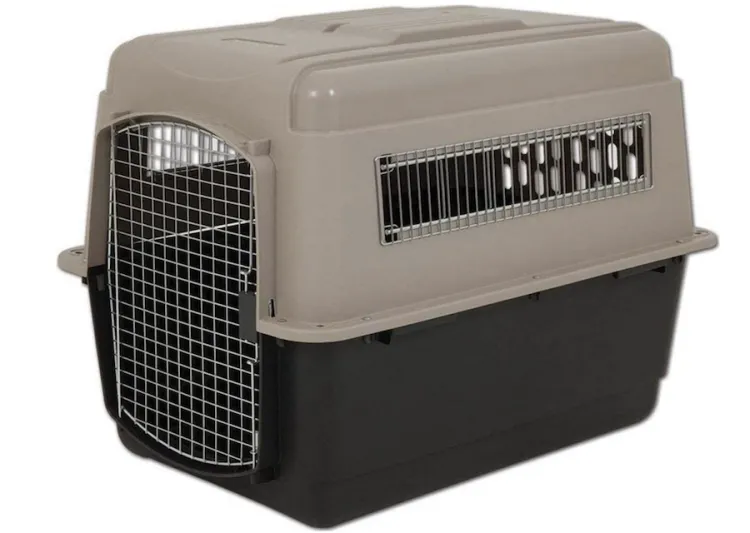
Dog Carrier
The safest way to transport your dog? In the back seat, confined to a hard-sided dog carrier (also called a travel kennel or crate) that you’ve secured with a seat belt.
In the event of a car accident, your dog should be well protected in a carrier.
The Petmate Ultra Vari Kennel is billed as being heavy-duty and secure for a safe and comfortable travel experience.
But according to the Center for Pet Safety (CPS), this exact crate was “far and away the most impressive crate” that this safety organization tested. It “was able to withstand the most significant forces generated in testing,” the CPS reported.
A few dog carrier tips for car travel:
- Make sure that whatever carrier or crate you get is large enough for your dog to stand, sit, lie down and turn around in.
- Place the carrier in the back seat, and then thread the seat belt through the handle. (Unsecured carriers can slide around on the seat.)
- Avoid putting too many items in the carrier that take up space or could cause injury to your dog.
Don’t Take a Chance on Safety
Pets aren’t children, but with respect to car travel, you should treat dogs as you would young kids.
Your dog should always sit in the back seat, secured with a safety restraint. Don’t let them ride in the front seat.
Yes, small dogs are cute and may fit in your lap perfectly, but you should not drive this way or allow your small dog to lie on a dashboard or other areas in the vehicle. This causes a distraction for you and increases your dog’s chances of being injured.
Getting a Dog Used to the Carrier
If your dog is not familiar with a carrier, try using it in the home before your trip to get your dog accustomed to it:
- Leave the door open.
- Place some of your dog’s favorite things inside to spark curiosity.
More Dog Carrier Tips for Car Trips
- Make sure that the carrier has enough ventilation to allow air to pass through freely, either through gated areas or holes.
- If your dog makes a mess inside the carrier during the trip, carry the carrier to a confined area such as a bathroom before letting your dog out. This lets you clean the carrier without the risk of your dog running away.
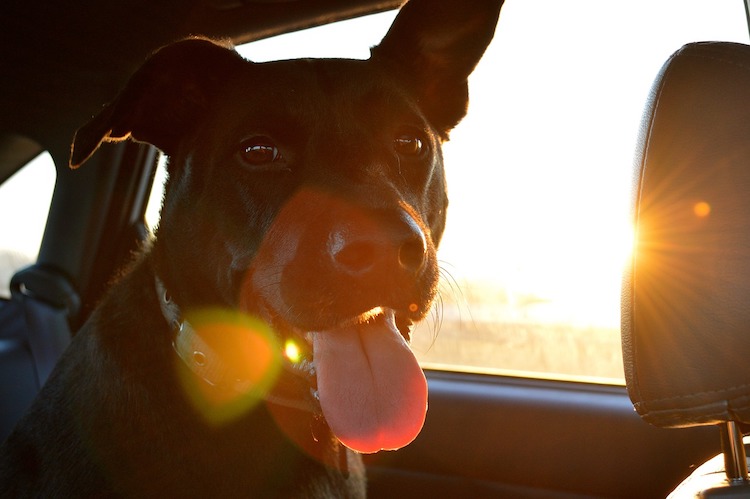
Part 2: Advice for Traveling With a Dog on Longer Car Trips
Be aware of the temperature.
This is an important topic for any pet when it comes to car travel.
Be aware of what the temperature will be at your destination and along the way, and never leave your dog in the car.
It takes only a few minutes for the temperature to rise to dangerous levels inside a vehicle, even in mild temperatures such as 75 degrees Fahrenheit. Lowering the car windows is not an effective way to ventilate the car — and may even allow your dog to escape.
The same can be said for the cold: Dogs can get hypothermia or die from dangerously low temperatures. Keep extra blankets with you, and again — don’t leave your dog in the car.
Hotels, Motels and Camps
If your trip includes staying overnight, check with the place you will be staying to learn about the pet policies, costs and other concerns.
If you plan to find a place to sleep as you go, make a list of dog-friendly places along the way so you know which ones to head to first.
See the Vet Before Long Car Trips With Your Dog
A vet visit is a good idea before a trip, especially for longer trips.
The dog’s veterinarian can check their health and make sure travel will be fine. Discuss sedation with your vet if you feel your dog will be stressed, anxious or have significant issues during travel. (See the next section on ways to prevent motion sickness.)
Do not self-medicate your dog or give your medications created for humans or other animals — these could be deadly.
- Consider getting your dog microchipped before the trip.
- Traveling across states, you may be asked to produce your dog’s rabies vaccination information. Take a copy of your dog’s records, as well as a current photograph in case your dog gets lost.
- Keep a copy of the paperwork and a picture of your pet in 3 places: your car, taped to the carrier and with you at all times. Add your contact information so someone finding your dog can contact you.
- Make sure your dog has a current tag on their collar — and bring an extra one in case it needs to be replaced while you are on the road.
Food and Water
- Limit your dog’s food intake before traveling to reduce the possibility of sickness or nausea.
- Take extra pet food and snacks with you for stops or for when you reach your destination. Stores may not have your dog’s usual brand of food, and changing food during a stressful situation such as travel might be a combination that causes stomach upset, diarrhea or other unpleasantness for your dog.
- Finally, take bottled water — and lots of it — with you on your trip.
- Try to plan stops every 3–4 hours to ensure your dog has ample opportunities to stretch, potty, drink water and get a break from the car.
- Don’t forget to bring along poop bags and/or a scooper to clean up after your dog.
- Keep your dog leashed on walks.
Talk to the Kids
If you are traveling with children, talk to them about allowing the dog to enjoy personal space without distraction.
Discuss behaviors they shouldn’t do, such as:
- Hitting or shaking the carrier
- Feeding the dog their food or snacks
- Teasing, hitting, pulling, or opening the crate — or releasing the harness
Any of these behaviors can add stress to your dog, and the goal is to keep your dog as comfortable and happy as possible while the dog is traveling in the car.

Part 3: How to Prevent Motion Sickness in Your Dog
Did you know 1 in 6 dogs suffers from motion sickness?
If you have a motion-sick dog, then you have our sympathy. Knowing your dog will arrive shivering and salivating (at best!) takes the fun out of a car trip.
Some dogs even learn to anticipate the feelings of nausea, and this makes them reluctant to even get in a car.
If you avoid car travel with your dog or always travel with a full cleanup kit, help is at hand. But don’t expect a quick fix — the answer takes time and dedication.
Positive Associations
Some dogs only have to see a car to start drooling because they link road travel to feeling sick.
This makes them unwilling to get into the car, which means you end up forcing the dog in — which only adds to the dog’s anxiety and feelings of unease.
Put an end to this vicious circle by teaching your dog to associate the car with good things.
- Play with your dog’s favorite toy in the back seat of your parked car.
- End each session on a high by giving them a treat.
- Hop out to go for a walk before they get anxious.
- Reward them for being calm while inside the car with another tasty food treat, and praise their bold behavior.
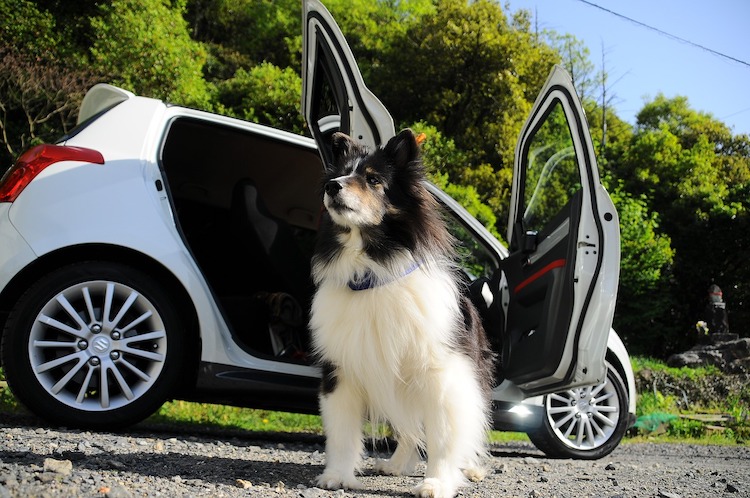
Another option includes spending at least a couple of weeks engaging the dog in a game inside the car but with the doors open so your pet doesn’t feel trapped.
Also try other strategies, such as feeding meals inside the car (perhaps invest in a waterproof seat cover) so your dog sees the car as an extension of the home.
Once the dog is willingly jumping into the vehicle, you’re ready to progress. Take things slow, though — move on to the next stage only when your dog’s tail is in the air rather than between their legs.
Introduce one new change at a time, giving them plenty of time to accept each step.
A retraining journey includes:
- Shutting the car doors
- Starting the engine but keeping the car in park
- Reversing a few feet, then driving back to the parked position
- A short, straight drive up the road
- A short drive around the block, then back into the drive
- A short drive in the neighborhood
All the while, remember the 3 golden rules:
- Praise their calmness.
- Stop before they become distressed.
- End on a positive note.

Car Climate
There’s nothing worse than a hot, stuffy car for making me feel sick when traveling, and the same is true for dogs.
- Make sure the vehicle is cool with fresh air circulating. It also helps some dogs if they can see out of a window — for smaller dogs, consider a booster seat or dog pod.
- Most dogs travel best with a handful of dry biscuits in their stomach, given 1–2 hours beforehand, rather than traveling with a totally empty stomach.
- Stop frequently to let your dog stretch his legs and drink water.
Travel Medications
If you have an urgent journey to make, you may not have the time to desensitize your dog to car travel.
Medication may be your best way forward. At least then the dog will be spared the nausea associated with car travel.
Some people swear by traditional remedies, such as ginger or peppermint. There are also herbal options, such as skullcap and valerian, or quick fixes such as Rescue Remedy.
That said, these are not scientifically proven to be effective, and it’s best not to rely on them, especially for a long trip.
There are also these medications:
- Acepromazine (ACP): This is a sedative with an anti-motion sickness action. ACP isn’t suitable for short journeys, as the dog is groggy for around 8 hours. Also, some dogs have an adverse reaction where they become “hyper” rather than sedated, so test it out before committing to a long journey.
- Maropitant (Cerenia): This drug acts on the nausea center in the brain and turns it off. This makes it the ideal motion sickness tablet — it works for 24 hours without sedating the dog. The only drawback is the price.
Here are a few more great tips from Pet Health Network:

In short, reintroduce the car as a fun place to be, and use medication to stop your dog from feeling sick.
By preventing nausea and building new associations, you’ll find that along this path lies the promise of stress-free car travel with your dog.
Part 4: Why Are Dogs Still Riding in the Back of Trucks?
You’re driving down the road, windows open, hair blowing in the wind and music blaring.
It’s a gorgeous, sunny day that’s absolutely perfect for a road trip.
Until you spot something that puts a knot in your stomach — someone’s dog is freely riding in the bed of their pickup truck.
Not only that, but also you see the driver look down to switch the radio station, only to swerve away from the curb after looking back up. The dog, of course, bumps hard into the side of the truck bed, almost losing balance. The sight makes you cringe.
What do you do? There must be a law against something like this, right?
The straight answer is yes, there are laws against driving with dogs in the back of pickup trucks.
Unfortunately, those laws are sparse and certainly not all-encompassing.
According to the Animal Legal and Historical Center, as of 2017, only 5 U.S. states had laws in place to keep dogs out of truck beds:
- Connecticut
- Massachusetts
- New Hampshire
- Rhode Island
Even in those states, there are exceptions to the law.

How Dangerous Is it to Let a Dog Ride in the Back of a Truck?
DMV.org reports that thousands of dogs are killed each year riding in the back of pickup trucks.
That number doesn’t even account for all the injuries that don’t lead to deaths.
You know how gravel and dirt sometimes spray onto your windshield, resulting in tiny cracks in the glass? A dog riding in a truck bed is susceptible to that same gravel and dirt spray. If it’s forceful enough to crack a windshield, there’s no doubt it can harm a dog’s eyes, nose or even lungs if it’s breathed in.
Of course, there are also more obvious consequences, like a dog being thrown from the truck (or being slammed against the back of the cab) if the driver slams on the brakes or swerves.
How Dogs Can Ride Safely in a Truck
Drivers of pickup trucks should always ride with their dogs in the cab and strap them to the seat with a dog-friendly car restraint.
Yes, there are ways to secure crates to a truck bed, but even then, gravel and dirt could potentially damage a dog’s ears, eyes and throat.
And yes, there are ways to cross-tether a dog in a truck bed to prevent them from falling or jumping, but the same dangers remain.
The only real solution when taking your dog for a ride, no matter what kind of vehicle, is to safely secure them with a dog car seat or harness (in the back seat).
Sure, taking that extra step might delay the trip by a few minutes. But isn’t potentially saving lives worth it?
- Center for Pet Safety. “Gunner Kennel G1 Intermediate.” June 2015. https://www.centerforpetsafety.org/cps-certified/gunner-kennel-g1-intermediate/ .
- Becker, Marty, DVM et al. From Fearful to Fear Free: A Positive Program to Free Your Dog From Anxiety, Fears and Phobias . Fear Free, LLC. 2018.
- Horwitz, Debra, DVM, DACVB, and Gary Landsberg, DVM, DACVB, DECAWBM. “Air and Car Travel.” VCA Hospitals. 2013. https://vcahospitals.com/know-your-pet/dog-behavior-and-training-traveling-air-and-car-travel .
- DMV.org. “Traveling With Your Pet.” https://www.dmv.org/how-to-guides/pet-travelling.php .

Don’t leave your pet’s food safety to chance.
Sign up for petful’s recall alerts today. (it’s 100% free.).

Stay informed. Protect your pets.
Meet Petful
- How We Help
Pet Food Safety
- Free Recall Alerts
- Pet Food Recalls
- Report Problems
- Vet-Approved Recipes
- Adopt a Pet
- Privacy Policy
- Cookie Policy
- Terms & Conditions
© 2024 Petful® / P51 Capital All rights reserved. Petful does not provide medical advice, diagnosis or treatment. More information.
- PRO Courses Guides New Tech Help Pro Expert Videos About wikiHow Pro Upgrade Sign In
- EDIT Edit this Article
- EXPLORE Tech Help Pro About Us Random Article Quizzes Request a New Article Community Dashboard This Or That Game Popular Categories Arts and Entertainment Artwork Books Movies Computers and Electronics Computers Phone Skills Technology Hacks Health Men's Health Mental Health Women's Health Relationships Dating Love Relationship Issues Hobbies and Crafts Crafts Drawing Games Education & Communication Communication Skills Personal Development Studying Personal Care and Style Fashion Hair Care Personal Hygiene Youth Personal Care School Stuff Dating All Categories Arts and Entertainment Finance and Business Home and Garden Relationship Quizzes Cars & Other Vehicles Food and Entertaining Personal Care and Style Sports and Fitness Computers and Electronics Health Pets and Animals Travel Education & Communication Hobbies and Crafts Philosophy and Religion Work World Family Life Holidays and Traditions Relationships Youth
- Browse Articles
- Learn Something New
- Quizzes Hot
- This Or That Game New
- Train Your Brain
- Explore More
- Support wikiHow
- About wikiHow
- Log in / Sign up
- Pets and Animals
- Transporting Dogs
How to Travel by Car with Your Dog
Last Updated: December 28, 2020 Approved
This article was co-authored by Elisabeth Weiss . Elisabeth Weiss is a Professional Dog Trainer and owner of Dog Relations NYC, a dog training service in New York, New York. Elisabeth relies on science-based, force-free, and reward-based techniques. Elisabeth offers behavior training, puppy manners, body awareness and injury prevention, diet, exercise and dog nutrition services. Her work has been featured in New York Magazine and on the Dog Save the People podcast. She also trained all the dogs in the movie "Heart of a Dog" by Laurie Anderson that features Elisabeth's journey with Laurie Anderson's and Lou Reed's dog Lolabelle and how her passion for playing the keyboards played a significant role in improving her quality of life after being diagnosed with pancreatic cancer. wikiHow marks an article as reader-approved once it receives enough positive feedback. In this case, 100% of readers who voted found the article helpful, earning it our reader-approved status. This article has been viewed 846,792 times.
Some dogs love to ride in cars and it's fun to take them along with you wherever you go. However, this is not the case for all dogs. Here are some safety tips you should think about before traveling by car with your favorite pet, whether they enjoy the journey or not.
Preparing to Travel with Your Dog

- If you don't want to cage your dog, at least find a way to make sure your dog is secure. For instance if you have an estate car, consider confining your dog to the rear of the car. If you do have a large window boot, put up a wire grid to stop your dog jumping over the back of the seats. Line the dog's area with dog blankets or place it's bed in the corner so it can nap comfortably on the journey. Make sure you don't have any heavy loose items, such as bowls or bottles, as those can become dangerous projectiles in an accident. Most dogs find sleeping an easy way to cope with motion sickness.
- You could also purchase a dog safety seat. While it is not as secure as a cage, it will be safer and more comfortable than a car seat for your dog if you turn or stop the car suddenly. The most popular among these are bucket seats. They attach at the back of the front seats, and the top of the back seats, creating a soft well in which your dog, and any liquids (or solids!) they may create, are contained. These can be made with a blanket or purchased cheaply.
- Car seatbelts for dogs are a great tool if you don't want your dogs confined, or if you only have a two-seater car. Make sure to attach them to a harness, and not a collar. They clip into the female buckle of a car seatbelt on one end, and have a standard lead clip on the other. By attaching them to a harness, you ensure the dog is secured by the body, and their neck won't be damaged in an emergency.
- If you use a cage, make sure it is secured. Make sure it is very secure to prevent it from moving if you stop suddenly or get hit. An unsecured cage can be just as, or even more dangerous than an unsecured dog.

- Squeaky toys are also undesirable as they will drive you crazy.

Going on a Long Drive with Your Dog

- This is especially important if your going on a long journey. Four hours is your average dog's absolute limit for driving without a longer break, but as a driver it's recommended you take a break after every two hours of driving. Make sure you stop somewhere grassy and relatively quiet (not right beside the road), lock your car, feed your dog some food and water, and take him for a walk so he can let off some of his excess energy.
- If you stop by the highway your dog MUST be on a lead for his own safety.

- If you stop for a meal, park your car in the shade, and let the windows down about an inch each to let cool air in. Put a bowl of cool water in the car for your dog and unbuckle him or her if in a dog seat. Lock your car doors, and order your food to go.
- Try to spend no more than five minutes away from the car if it is a warm day, as you don't want your dog to overheat. If your stop will take a bit longer, for instance you are waiting in a long queue for food, tie your dog to a post either just inside the front door or just outside in a place where you can see it. At least he or she will be out of the heat while you wait. Make sure to tie the dog with secure knots so it doesn't escape. Tight knots will also mean it will be less likely for someone to steal your dog.

Expert Q&A

- If your dog has a favorite towel or blanket be sure to bring it in order to comfort your pet. Thanks Helpful 6 Not Helpful 0
- Try to have your (non-toy*) puppy's first car rides be "on an empty stomach" by withholding food for 2-4 hours before the ride. Several rides without nausea will help tremendously to prevent the puppy from developing car sickness. Thanks Helpful 4 Not Helpful 0
- If you are traveling more than 24 hours, look beforehand for a pet-friendly hotel for you to unwind and for your dog too. Thanks Helpful 3 Not Helpful 0

- Some dogs can get very queasy. Keep a close eye on it and line the back seat with old blankets or newspaper if you want to be on the safe side. Thanks Helpful 42 Not Helpful 2
You Might Also Like

- ↑ https://www.cesarsway.com/dog-care/travel/dog-is-my-co-pilot
- ↑ https://www.cesarsway.com/dog-care/travel/cesars-travel-tips
- ↑ Elisabeth Weiss. Professional Dog Trainer. Expert Interview. 3 September 2020.
About This Article

To travel by car with your dog, you should restrain it with either a cage, a safety seat, or a seat belt designed for dogs, which will keep it safe and prevent distractions while you’re driving. Before your go for your drive, exercise your dog so that it will be tired and less anxious or hyperactive in the car. Additionally, pack supplies such as water, treats, and a few chew toys to help keep your dog occupied. You should also avoid feeding your dog right before a car trip to prevent it from getting carsick or relieving itself in the car. For more advice from our Veterinary co-author, like how to prepare a hyperactive dog for a car trip, keep reading. Did this summary help you? Yes No
- Send fan mail to authors
Reader Success Stories
Ana Carolina
Aug 10, 2016
Did this article help you?

Cheryl Davis
Apr 30, 2017
Larry Cullop
Jul 20, 2017
Feb 16, 2017
Leanne Chatterton
Aug 15, 2016

Featured Articles

Trending Articles

Watch Articles

- Terms of Use
- Privacy Policy
- Do Not Sell or Share My Info
- Not Selling Info
wikiHow Tech Help Pro:
Level up your tech skills and stay ahead of the curve

Car Travel with Dogs: Plan the Perfect Road Trip!
By Author Tara Schatz
Posted on Published: March 28, 2024
Categories Traveling with Dogs , Gear and Clothing , Planning , Travel Tips
You’re planning a monumental road trip, and you’d love nothing more than to bring along your favorite canine companion to share in your adventures.
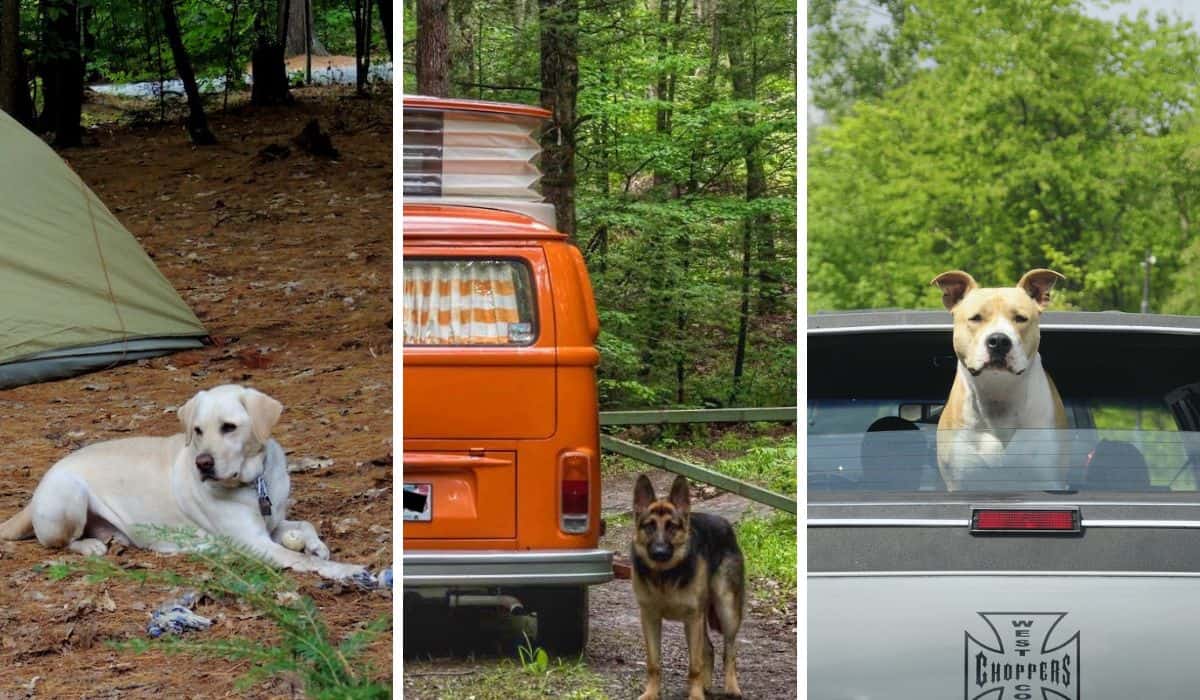
Should you do it? Will your dog cause problems, make your life miserable, and suffer from incredible boredom sitting in the car day after day?
Whether or not you should road trip with dogs depends totally on you, your dogs, and your lifestyle, but I promise that fabulous, inspiring road trips have been achieved with adventurous dogs since the invention of the automobile.
While I won’t be the one to tell you that car travel with dogs is easy, I will absolutely advocate for traveling with dogs in the right circumstances.
We have taken numerous road trips with our dogs over the years and currently travel with our two amazing black labs, Flynn and Malinda. They love riding in the car, exploring new places, and checking out the best restaurant patios.
Kind of like us!

For the most part, dogs love traveling, and there’s no doubt that your pup cherishes time with you above everything else, so let’s try to make it work.
First, let’s decide if car travel with dogs is right for you and your favorite companion.
You Should Absolutely Take a Road Trip With Your Dog if…
- You have room in your car, RV, or camper .
- Your dog enjoys traveling and doesn’t get car sick.
- Your pup is up-to-date on vaccinations.
- Your dog responds to basic commands and is socialized to people and other dogs.
- You are passionate about an active lifestyle.
- You are willing to do some research to find lodging and restaurants that will accommodate your dog.
- You are willing to skip over attractions and destinations that aren’t dog-friendly.
- You are able to make arrangements so that your dog does not have to sit in a hot car while you shop, eat, or explore.
- You’re planning on staying at campgrounds and doing a lot of hiking, swimming, and other activities that are just more fun with dogs.
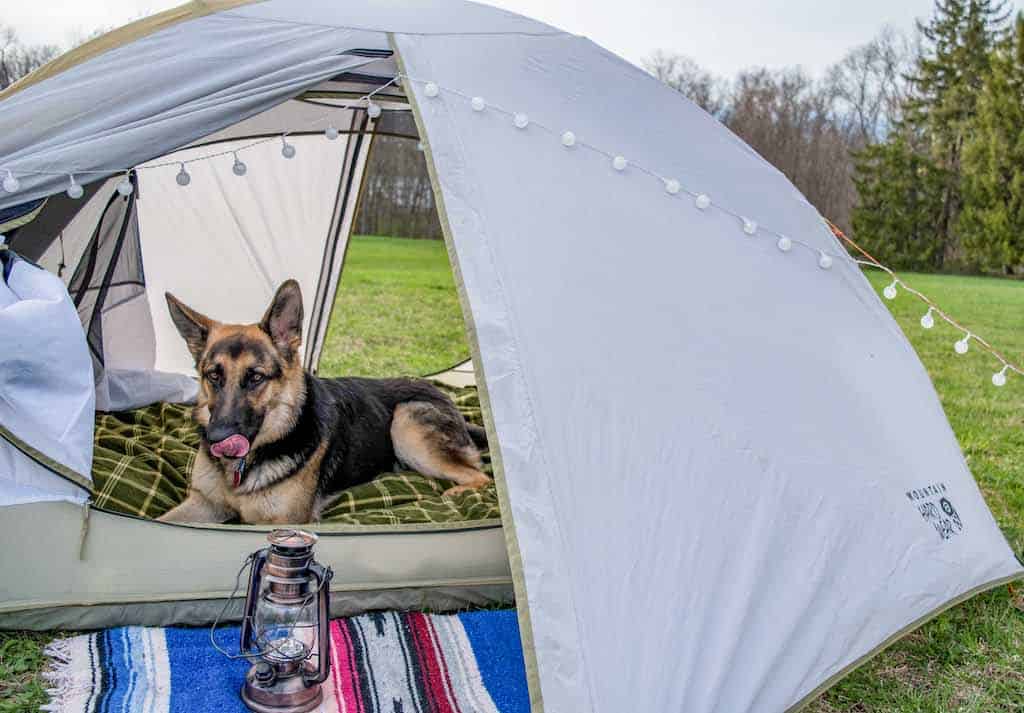
You Should Think Very Carefully About Car Travel with Dogs if…
- Your dog won’t have much room in your car, RV, or camper.
- You don’t think you’ll have time to give your dog the exercise and attention he needs.
- Your dog doesn’t respond to or follow basic commands.
- You plan to spend a lot of time in big cities, national parks, or other destinations that aren’t dog-friendly.
- Your dog gets car sick.
- Your dog loves being at home and you have someone who is willing to care for him.
You Should Definitely Not Travel with Your Dog if…
- Your dog is aggressive with people or other dogs.
- Your dog is not trained and hasn’t been socialized.
- Your dog suffers from anxiety or another illness that would make traveling painful for both of you.
Every dog is different, and it’s important to think carefully about logistics before planning a road trip with dogs. If your dog is up for the adventure, and you’re willing to plan your trip around your dog’s needs, I say go for it!
If the thought of adjusting every aspect of your trip around your dog makes you cringe, you may want to reconsider, but as far as I’m concerned, most road trips are simply better with dogs!
To plan a successful road trip with dogs, it’s important to consider your pup’s needs from the very beginning. We have had the best luck road-tripping with dogs on vacations that focus on outdoor activities, at least in part.
Outdoor vacations work for us because our whole family prefers being outside. That’s not to say that you can’t plan for other indoor-based activities while road-tripping with your dog, it will just take a little more work.
Here are some planning tips that will help you plan for a fabulous dog-friendly road trip.
Where to Stay with Your Dog on Your Road Trip
The biggest piece to the road-tripping puzzle, whether you travel with dogs or not, is deciding where to stay.
If you’re road-tripping in the USA, you will be happy to know that hotels and other accommodations are becoming more and more dog-friendly. There are even hotel chains where pets always stay free.
Where you choose to spend the night with your dog on your road trip will depend a lot on the level of comfort you want and the price you’re willing to pay, but here are some great ideas for lodging with pets while traveling.
Camp with Your Dog Inside Your RV or Camper at a Campground
If this is your situation, you’re in good shape. Your dog can have free run of the camper, can be left alone, provided that it’s not too hot, and will be able to frolic in the great outdoors with you by his side.
Taking an RV or camper on a road trip with your dog is a win-win for everyone involved, and will probably create the least hassle too.
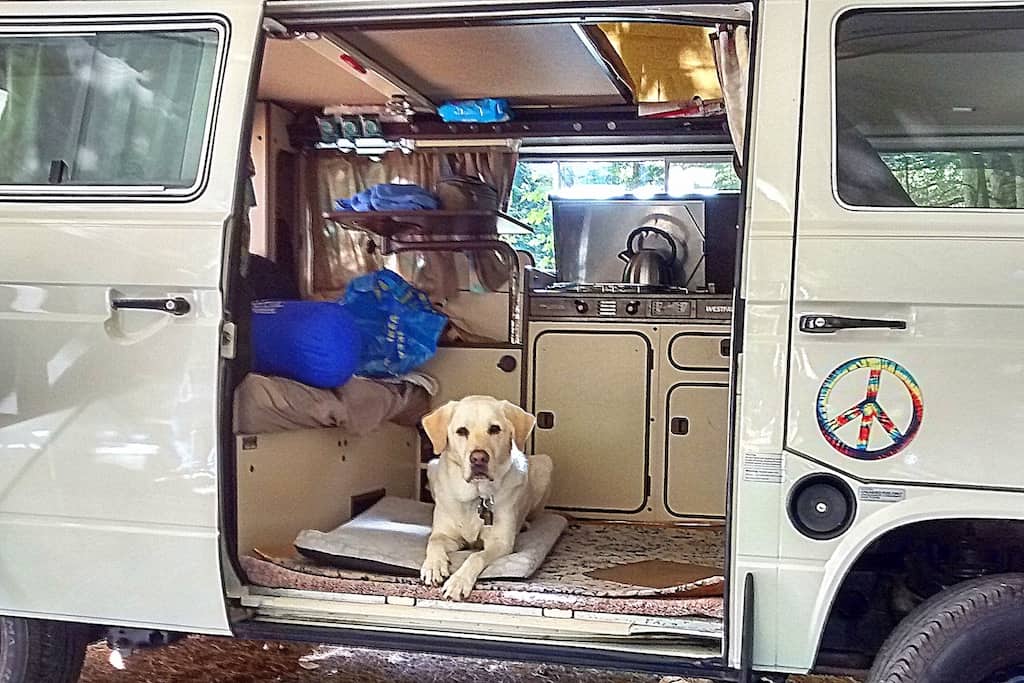
Camp with Your dog Inside a Tent at a Campground
Tent camping while on a road trip is an inexpensive way to see the country, and it’s probably our favorite way to road trip with dogs. We prefer car travel to RVs, and we often travel on a budget.
When tent camping, both dogs and people get plenty of exercise, which makes long days on the road much more tolerable. There are, however, a few downsides to tent camping with dogs.
Have you ever slept in a tent with a wet dog? I promise you, this won’t be high on your list of favorite activities !
The other thing to know is that most campgrounds don’t allow you to leave your dog unattended, which means, for better or worse, your furry friend will be by your side on every excursion you take.
Still, tent camping is our favorite way to stretch a dollar while road-tripping , whether we’re traveling with dogs or not.
Camping may not come naturally to your dog, so I recommend doing some trial runs close to home before setting out on a camping road trip with your dog.
Also Read: The Complete Guide to Camping with Dogs
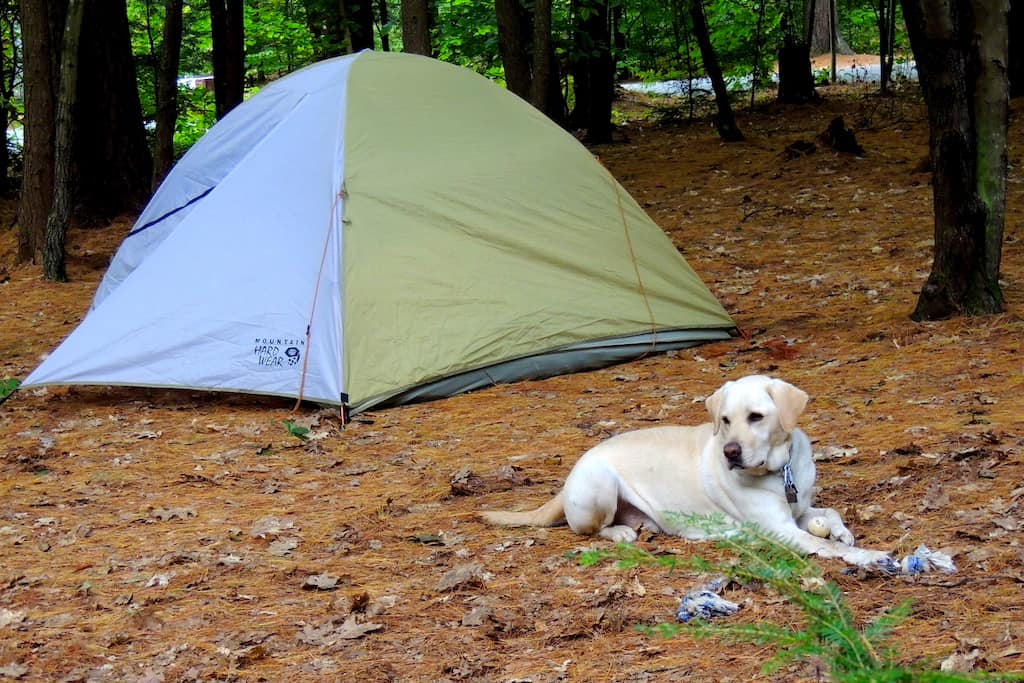
Stay with Your Dog in a Cabin at a Campground
Cabin camping with dogs is an option well worth exploring, especially if tent camping seems a bit overwhelming. Many park cabins don’t permit dogs, but over the past few years, it’s been easier to find dog-friendly spots.
Be sure to do your research ahead of time, and you may find some great options for you and your pooch.
Stay with Your Dog in a Dog-Friendly Hotel

If you’re just passing through, any hotel or motel that allows dogs will serve its purpose, but some places go above and beyond, making your dog feel like the family member that he is.
Bringfido.com helps you search for dog-friendly lodging, and it’s available as a mobile app so you can find hotels on the fly.
Our favorite dog-friendly hotel chain is Kimpton, where dogs always stay free, and there are no size or breed restrictions. Kimpton Hotels go above and beyond to make you and your dogs feel welcome. 100% worth paying a little extra!
When staying with dogs in a hotel, we always bring a crate and we always ask for a room on the ground floor so we can get in and out easily.
Stay with Your Dog in a Vacation Rental
There are some real benefits to staying in vacation rentals (like Airbnb or VRBO ) when traveling with dogs, especially if you plan to spend more than a single night in the places you visit.
We love having a kitchen to cook our meals, and being able to occasionally leave our dogs behind so that we can go to museums, shopping, etc.
Dog-friendly vacation rentals make traveling a little bit easier, but the cost is often higher than staying in a hotel.
Bonus: staying in a vacation rental with your puppy is also a great learning opportunity that can help pups grow into confident, well-mannered dogs.
What to Pack for Car Travel with Dogs
Planning and packing for your dog-friendly road trip is part of the fun (at least for me it is). Here’s everything you need to keep your dog happy and healthy on the road.
- Dog food – Ask your dog, and he’ll tell you that his food is the most important thing for you to pack. If you’re taking your dog on a long trip, you may also want to buy a special dog kibble carrier, which will keep odors down and help you save room on your road trip.
- Vaccination information – Many hotels and campgrounds require that you provide them with your dog’s most up-to-date vaccination records. Don’t leave home without them. You don’t need a hard copy, just take a photo of the records and keep them on your phone.
- Flea, tick, and heartworm prevention – No matter where you travel, there’s a good chance you’ll run into biting insects, and ticks that carry Lyme disease are now found in 49 states. Whatever method you use for prevention, be sure to pack it when you road trip with your dog.
- A travel bed – If you have room in your vehicle, your dog’s regular bed from home will be just fine. If you’re short on space, check out this awesome dog travel bed from ChuckIt! , which comes with its own stuff sack. This bed is one of our best purchases. It’s cheap, water-resistant, and washable, and your dog will feel more comfortable knowing he has is own space when you stop for the night.
- Bones and toys – Bones are great for chewing in the car, and balls and toys can be useful when you reach your destination. What you buy will depend on what your dog enjoys, but our labs never outgrow their Nylabones and Benebones.
- Food and water bowls – They don’t take up much space, but if every square inch counts, check out the Kurgo collapsible travel bowl . It’s totally packable and perfect for hiking and canoe trips too.
- Poop bags. For obvious reasons.
Tips for Car Travel with Dogs
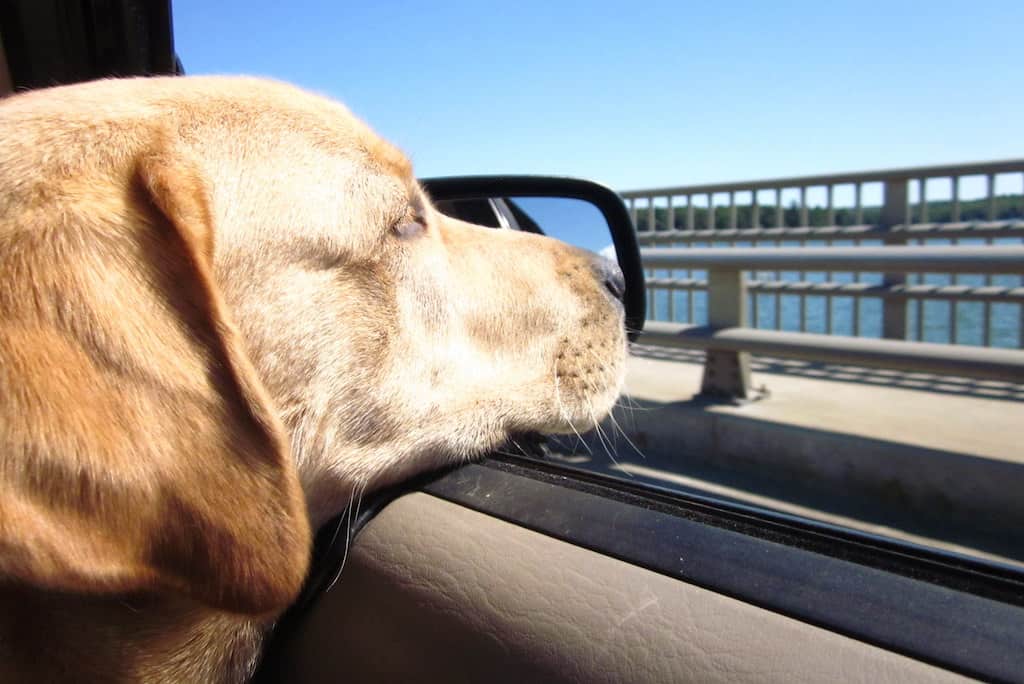
Take some of the stress out of your road trip by planning for what to do if your dog gets sick or lost while traveling. Here are a few tips for car travel with dogs.
- Make sure your dog wears his tags . The tag should include your name, address, and phone number. Don’t forget to include your cell phone number in case your dog is lost on the road.
- Keep your dog leashed or under your voice command at all times. Traveling can be a stressful experience for your dog, and even dogs that stay close to you at home may wander when traveling. That’s why it’s extremely important to keep your dog leashed at all times. Well-trained dogs that respond immediately to your voice command will earn more freedom, just use your best judgment.
- Get your pooch microchipped. According to Petfinder , only 22% of lost dogs that entered animal shelters found their way home to their families, while 58% of microchipped dogs were reunited with their loved ones. A microchip is no bigger than a grain of rice, but it could save you and your dog a lot of heartache at home and on the road.
- Prevent car sickness. Did you know that mild cases of nausea and car sickness can be prevented with ginger snaps? This was news to me, but our shepherd puppy just couldn’t deal with the long, winding roads that we love. Someone recommended ginger snaps before long car rides, and our pup has been fine ever since. I recommend one a half hour before travel, and another when you get in the car.
- Keep your dog safe while driving. According to the Whole Dog Journal , the safest way to travel with a dog in the car is by securing them in a dog travel crate. in the car for your dog is within a secure crate or a harness restraint in the back seat. If you have room for a crate in your car, this is definitely what we’d recommend. Here are some dog travel crates to choose from for your next road trip.
- Don’t have room for a crate? Use a seat belt harness – We travel in a small car, so we have never had room for a large travel crate. Instead, we use a seatbelt harness with our dogs, which keeps them restrained while we’re driving.
- Get plenty of exercise. This will make long trips bearable for you and your dog. Start each morning with a brisk walk, jog, swim, or hike together. Take shorter walks throughout the day, and another vigorous romp before bed.
- Chew toys make car rides a lot more fun. Dogs are like toddlers sometimes — they can get bored and antsy in the back seat. Protect your sanity, and perhaps your seat cushions, by investing in a stash of chew toys for the trip. Whether your dog loves real bones, Nylabones, or Kongs stuffed with peanut butter, you can keep a stash of his favorites hidden away. When things start to get dicey, break out the goods. Everyone will be happier for it .
For Those Times When You Need a Break from Your Dog

Depending on the nature of your road trip, there’s a good chance you’re going to encounter places that just aren’t dog-friendly.
National parks come to mind, although we’ve visited several of them successfully with dogs. Dogs aren’t welcome in most amusement parks, zoos, shopping centers, museums, and many other places.
Big cities can be hard to navigate with dogs too. Does this mean you have to forgo all these potentially exciting destinations or leave your dog at home? Of course not.
You can easily make use of pet sitters along the way. Rover is the Airbnb of the canine world. Their network includes more than 15,000 sitters across the United States. To make use of this incredible resource, simply create an account before you hit the road, and search by zip code when you need a sitter.
Whether you’re heading to Disneyland for a weekend or just a day in the big city, Rover will match you with the perfect dog sitter at prices that are often cheaper than traditional kennels.
Final Thoughts on Car Travel with Dogs
Embarking on a road trip with your dog is a truly rewarding experience, provided you’ve planned ahead. The important thing is to make accommodations that reflect your pup’s needs.
A trip that focuses on outdoor adventure will probably garner the most tail-wagging, but when it comes down to it, your dog just wants to be by your side.
Read more tips for adventuring with dogs:
- The Complete Guide to Canoeing and Kayaking with Dogs
- Everything You Need to Know About Camping with Dogs
- Our Best Tips for Snowshoeing and Skiing with Dogs
- Summer Adventures are Better with Dogs
Follow us on social media!
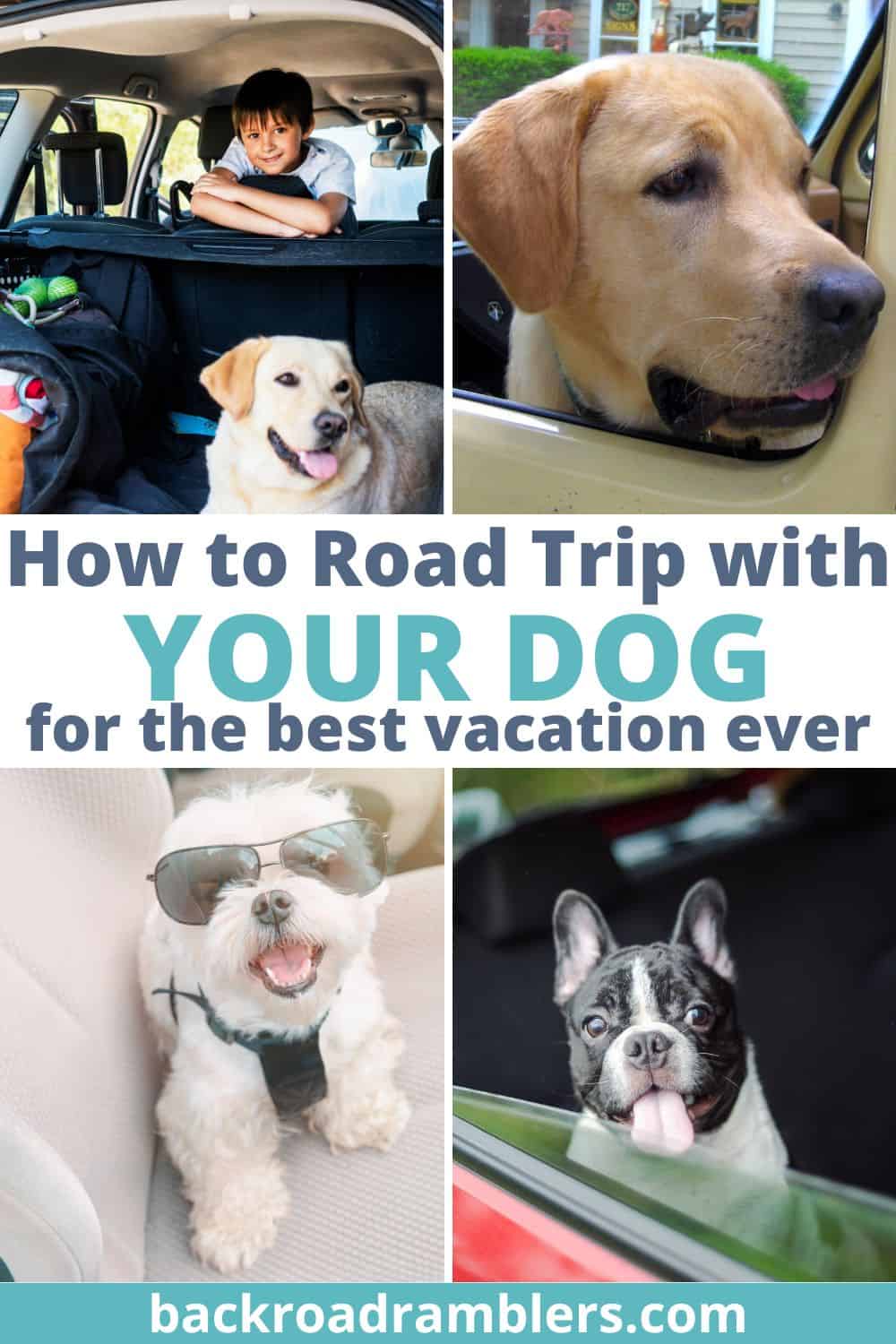
Tara is a freelance writer and travel blogger with a passion for outdoor adventures. She is the co-author of AMC’s Best Day Hikes in Vermont and currently blogs at Back Road Ramblers and Vermont Explored , where she shares travel tips, adventure destinations, and vacation ideas for the wanderer in everyone.
Monday 30th of May 2022
I'm glad you mentioned to think about of where you're going will be good for your dog. I love to take my dogs everywhere but last year went on a trip to see wild horses in Northern Colorado and left my dog at home. Having a dog while approaching wild horses wouldn't have been smart. The ground had a lot of small cacti which would have been horrible in her feet. I had no regrets leaving her home. I spent a year trying to figure out how I wanted to roadtrip with my dog.
Crate and Cage
We Love Pets! All Types / Sizes
25 Easy Tips for Car Travel with Dogs

Car travel with dogs can be an exciting adventure, but it requires plenty of preparation and planning. From packing the essentials to keeping your pet calm during the journey, there are a few things you need to consider before embarking on a road trip with your canine companion.

Here are some helpful tips for stress-free car travel trips with your dog.
Introduction to Traveling with Your Car Dog
Traveling with your pup can be a fun and rewarding experience, but it’s important to do your research and plan ahead to ensure your trip goes as smoothly as possible. Before you hit the road, make sure you’ve done your homework and taken all the necessary precautions.
Is it stressful for dogs to travel by car? It can be, but with proper precautions and preparation stress levels can be minimized.
- First, check your destination’s laws and regulations regarding pet travel. You may need to bring along certain documents, such as your pup’s vaccination records.
- Second, consider your pup’s personality and whether it’s a good fit for the type of journey you’re embarking on. Some dogs may be better suited to shorter trips, while others may be able to handle longer, more strenuous journeys.
- Third, some motels, hotels, and campgrounds have limitations for dog size that are allowed in their facilities. They sometimes have policies against breeds they consider aggressive or disruptive. It’s a good idea to call ahead and make sure your pet will be welcome.
- Fourth, get a check-up at the veterinarian, who can advise you whether an over the counter dog sedative for car travel is appropriate for your pet and what to give a dog for a long road trip.
Finally, think about the type of vehicle you’ll be using to transport your pup. If you’re planning on taking a long road trip, you may want to invest in a car or van with plenty of space for your pup and all their gear.
Outfitting Your Dog for Car Travel
Once you’ve chosen your mode of transportation, it’s time to get your pup ready for the journey.
Investing in the right car accessories is essential to ensure your pup is safe and comfortable during the trip. This includes items such as a car seat or booster, harness, and a dog bed.
A car seat or booster helps keep your pup safely secured in the car. It also helps to reduce distractions and allows them to keep an eye on the scenery. A safety harness is also essential to keep your pup securely in place while traveling.
Having a comfortable dog bed is important for long trips, as it will provide your pup with a place to rest and relax.

Pre-Trip Checklist for Traveling with Dogs by Car
Car travel with dogs doesn’t have to be difficult. Getting your dog accustomed to being in a confined space it a big consideration. Short trips nearby to the post office, dry cleaners, or other short errands help get your dog used to the motion of riding in a vehicle.
Are dogs OK on long road trips? Smaller dog breeds travel well but traveling with larger dog breeds is more challenging. A mastiff, Great Dane, or Saint Bernard requires more preparation than a poodle, cocker spaniel , dachshund , or Boston terrier.
Traveling with dogs in a large SUV is easier than traveling in a small sportscar. A seven-passenger vehicle has more room for extra passengers. Dogs can have their own space to lay down and chill without disrupting other passengers.
A two-passenger vehicle makes taking a pet along almost impossible. A mini-van, four door sedan, or crew-cab pick-up truck are all good candidates for taking a dog along for the ride.
Before you hit the road, there are a few things you should do to make sure your pup is safe and comfortable during the journey.
- First, make sure your pup is up to date on their vaccinations and has all the necessary paperwork. You may also want to schedule an appointment with your vet to have your pup checked for any underlying health issues.
- Next, pack all the essentials, including food and water, treats, toys, and anything else your pup might need during the trip.
- Don’t forget to bring along a first aid kit, as well as any medications your pup is taking.
- Be sure you have a plan for potty breaks and feeding schedules.
Safety Tips for Car Travel with Dogs
Before embarking on a road trip with your pup, it’s important to consider their safety. Make sure your pup is securely restrained in the car. This can be done with a car seat or booster, as well as a harness or safety belt. The Center for Pet Safety has a list of certified accessories that will help make traveling safe.
It’s also important to be aware of your pup’s comfort level in the car. If your pup is anxious or uncomfortable, try to make frequent stops to give them a break.
If you’re traveling in areas with extreme weather conditions, make sure to take the necessary precautions to keep your pup safe and comfortable.

- What’s the safest way to travel with dog in car? It’s best to keep your dog in the back seat. In the front seat they are a distraction for the driver and there is risk of harm if the vehicle needs to make a sudden, emergency stop in heavy traffic.
- Should I keep the dog in a crate while traveling in cars? Maybe. You know your dog best. For dogs that become overly excited riding in vehicles, a crate may be the best option. Training for obedience is helpful as well. A well-trained dog responds to commands and has better manners while traveling.
- Can dogs travel in car for 12 hours? Maybe. Every dog is different. Some dogs love to travel and others don’t do well over long distances. There are several considerations to prepare your dog for traveling that should help improve comfort for dogs and drivers.
- How to travel with 2 dogs in car – Start with a medium to large vehicle. Keeping one dog in the back portion behind a partition and the other in the area behind the front-seat is an option that works for many. You may need to consider using a crate for each dog, if there is any question about whether your dogs tolerate being confined in small spaces together.
Keep reading for more insights and suggestions.
Keeping Your Dog Calm During Car Travel
Traveling with your pup can be a stressful experience, so it’s important to take steps to keep them calm and relaxed during the journey.
Start by familiarizing them with the car. Practice entering the vehicle, sitting for a while, and then exiting. It takes a while to coax some dogs into responding well to new surrounding but with a little practice most does learn to love riding in vehicles. It’s in their nature to crave being near their owners, wherever that may be.
Begin taking short trips to get them used to the environment. For example, if you are planning to take you dog on a 4-hour trip to visit relatives, try a few shorter 1-hour trips to gauge your dog’s response.
You can also try setting up a comfortable space for your pup in the car.
- Invest in a car seat or booster and a cozy dog bed to give them a place to relax.
- Try to keep the car cool and well-ventilated.
- Never leave your dog unattended in a vehicle while traveling. It’s not worth the risk.
Potty Breaks & Feeding Schedules
It’s important to plan for regular potty breaks and feeding schedules when traveling with your pup. Make sure to plan for at least one potty break every few hours, depending on the length of your trip. Additionally, feed your pup at regular intervals, such as every four to five hours.
Be aware of any local laws and regulations regarding pet waste, especially in areas where pet waste is prohibited. If you’re staying in a pet-friendly accommodation, make sure to follow the rules regarding pet waste disposal.
Tips for Taking a Break During Travel
Long car trips can be tiring, not just for you but for your pup as well. To keep them relaxed and comfortable, it’s important to plan for regular breaks. This can include stops at pet-friendly parks or beaches, as well as rest areas or dog-friendly restaurants.
If you’re staying in a pet-friendly accommodation, make sure to take advantage of their amenities. Many pet-friendly hotels offer pet-friendly amenities, such as pet-friendly patios and fenced-in yards.
Accommodating Your Dog’s Needs During Long Car Trips
When embarking on a long road trip with your pup, it’s important to consider their needs and comfort level.
- Make sure you’ve packed all the essentials, such as food and water, treats, toys, and a comfortable bed.
- Plan for regular potty breaks and feeding schedules.
- If your pup gets restless during the journey, try to make frequent stops to give them a break. This can include stops at pet-friendly parks or beaches, as well as rest areas or dog-friendly restaurants.
Finding Pet-Friendly Accommodations
Finding pet-friendly accommodations while traveling with dogs in car long distances can be challenging, so it’s important to do your research and plan ahead.
- Look for pet-friendly hotels and vacation rentals that offer amenities such as pet-friendly patios and fenced-in yards.
- You can also look for pet-friendly restaurants and attractions in your destination.
Many cities offer pet-friendly attractions, such as dog parks, dog beaches, and pet-friendly trails.
Traveling with your pup can be a fun and rewarding experience, but it requires plenty of preparation and planning. From packing the essentials to keeping your pup calm during the journey, there are a few things you need to consider before embarking on a road trip with your canine companion.
- Make sure to do your research and plan ahead to ensure your pup is safe and comfortable during the journey.
- Invest in the right car accessories, such as a car seat or booster, harness, and dog bed.
- Plan for regular potty breaks and feeding schedules, and look for pet-friendly accommodations along your route.
Follow these tips for stress-free car travel with dogs, and you’ll be sure to have a safe and enjoyable journey.
Ready to hit the road with your pup? Start planning your trip today and make sure to keep these tips in mind. With the right preparation, you and your pup can have a stress-free and enjoyable car travel with dogs!
Read our article about the most beautiful dog breeds .
Related Stories

10 Best Bulldog Breeds for Families

4 Types of Best Large Dog Crates for Car Travel

16 Helpful Dog Bite Prevention Tips
You may have missed.

Birdwatching Binoculars Review: A Comparison of 7 Popular Models for Optimal Viewing

- Pet Insurance
Top 7 Best Pet Insurance Providers

Green Cheek Conures: The Ultimate Guide to Care
- Cheap and Budget Friendly Recipes
- Health Related Illness Diets
- Homemade Treat Recipes
- Homemade Dog Treats for Health Issues
- Seasonal Recipes
- Can Dogs Eat…
- Dog Diseases & Conditions
- Dog Symptoms
- Dog Grooming
- Caring For Seniors
- Dog Loss & Grieving
- Dog Reproductive Health
- Treatments and Home Remedies
- Dry Dog Food
- Wet Dog Food
- Best Dog Products
- Dog Accessories
- Dog Health Products
- CBD for Dogs
- Toy Dog Breeds
- Working Dog Breeds
- Terrier Dog Breeds
- Sporting Dog Breeds
- Non-Sporting Dog Breeds
- Mixed Breeds
- Hound Dog Breeds
- Livestock and Herding Dog Breeds

15 Safety Tips for Traveling with Dogs in Cars

Table of Contents
1. Never leave your dog alone in the car
2. understand motion sickness, 3. food can trigger motion sickness in dogs, 4. deal with your dog's traveling jitters, 5. use the buddy system, 6. some dogs remember a lot, 7. don’t wait until it’s an emergency, 8. drugs might be a short-term fix, 9. dog carriers and dog crates are safer, 10. buckle up in the back, 11. hide his eyes or distract the nose, 12. more pressure can be a good thing, 13. keep his head in, 14. have identification tags ready, 15. take a dog backpack or carrier.
S ome dogs and their owners definitely come as a pair. They always want to be together. If your dog enjoys going for a ride, traveling with dogs in cars can be a lot of fun. However, there are a few things you'll need to do to keep your pet safe and happy during the car ride.
Don't be upset if your pet doesn't like to ride in cars. Even though the majority of canines love riding in cars, for some dogs, it's just a bit of anxiety that keeps them from enjoying a ride in a car. With a bit of training and a little patience, you can curb your pooch's fear in no time. But how come some dogs simply love riding in cars, then?
CarAndDriver.com asked the experts why most dogs enjoy riding in cars, and it turns out that it's not because of the riding experience itself. The experts say that dogs love cars because they love us, their owners. It's the shared car ride experience .
Nevertheless, nervous jitters aren't going to be your only problem when it comes to traveling with dogs in cars. Your furry friend can also be a big distraction to you while you're driving. You'll need to take the proper steps to keep your dog safe while he's riding inside the vehicle, and that involves keeping him in the cargo hold or a dog car seat .
If your pup is roaming around in the car, he's going to distract you and become a dangerous projectile in the event of a car accident. Not to mention, it's likely that he'll be getting into things or climbing on your passengers. Follow these tips to prevent any of this from happening when traveling with dogs in cars.
ALSO READ: How to Prevent and Treat Car Sickness in Dogs
15 Tips for Traveling with Dogs in Cars
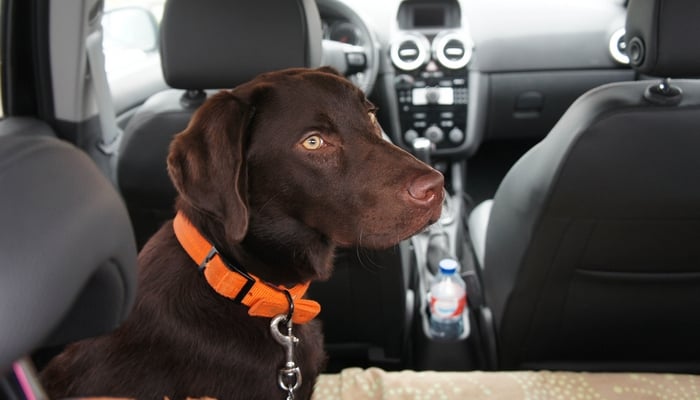
This should go without saying. Dogs can get a heatstroke from being locked in the car, which can be fatal . In many US states, locking your dog in a car may even be against the law or be considered animal abuse to leave your dog inside a vehicle.
The same applies to leaving dogs in cars in winter. When it's cold weather outside, it can eventually get very cold and freezing in a parked car, so make this a year-round rule.
Puppies are more likely to get sick in the car, just like young children. This is probably because their inner ears aren’t fully developed. Try to be aware of how your dog is feeling, and try shorter trips or other techniques until he gets more comfortable.
Symptoms of motion sickness in dogs range from the obvious to the more subtle:
- Extra drooling
- Restlessness
- Vomiting (in the car or shortly after arrival)
Don’t feed your dog in a moving vehicle, at rest stops, or right before a car trip unless he is a really comfortable traveler who never gets any signs of motion sickness. It’s better for the dog to have a light meal a few hours before traveling and not much on any dog treats.
Trust me, the last thing you want to deal with is a dog throwing up as you're driving down the freeway. But just in case you aren't sure whether this is going to happen or not, it's always a good idea to have dog car seat covers on the back seats as well.
It’s a cliché that dogs can’t wait to go out for a ride, but not every dog feels that way. Some dogs find traveling in cars frightening, and that can be a serious inconvenience.
If that's the case with your pooch, then accept that your dog’s fear is real and slowly begin to desensitize him with short, positive experiences, like treats or trips to the park.
For example, if you never travel with your dog to anywhere interesting and only drive together to the vet or the kennel, how interested can your dog be about getting in the car? It's a negative association for him. You’ve got to make it an enjoyable experience for your dog. You may need to start with a reward just for getting into the car.
Don’t push things too hard or fast. Forcing your dog too much only teaches him to expect things to get progressively more difficult and scary. Mix things up: play near the car, encourage him to reach in for a dog treat on the floor or climb over the car seat. Then, go for a quick trip. Just be patient and accept Fido's pace. They need to acclimate.
READ MORE: 10 Tips On How to Calm Down a Dog
If there's a friend with you when traveling with dogs in cars, there will always be someone to hold the dog’s leash when you go in a store or someone to help if there’s an issue.
Just having someone beside him in the back seat might help in the beginning. So try to make it a fun trip and bring more people; for dogs, the more, the merrier.
Dogs can associate streets, landmarks, and what direction the car turns with certain locations. They might get excited on the way to the dog park but frightened if you turn towards the vet’s office. You may need to deal with situations like this with more positive training and rewards.
Ultimately, it's all about training your pooch to adjust to the environment and the procedure of riding in the car: getting in, staying in, and getting out. Dedicate to train him at first and reap the benefits for the rest of the time.
If you need to take your dog on a long car trip or go to the vet, dog groomer, or kennel, start positive: give him rewards and train him as early as you can. Puppies should ideally learn to make a positive association with riding in cars before they leave for their forever homes and are separated from their mothers.
An emergency is stressful enough that you don’t want to take on more than you have to. Car travel preparations can save you a lot of stress and time. It’s better to leave your dog at home, get a dog sitter, or take him to the kennel than jump right into more than your dog’s ready for. Bad associations are harder to deal with than just inexperience.
You don’t want your dog dependent on medication whenever he needs to travel or have him completely sedated. However, something to take the edge off his fear or settle his stomach might help him to be less anxious and start making more positive associations.
There are plenty of drug solutions out there, and you can get some of the best dog anxiety medications to calm your dog before any car ride. Just keep in mind that it's not a long-term solution, and you still need to train your pooch for positive association.

Dog crates have been one of the best solutions when traveling with dogs in cars because many dogs love them (especially after you crate-train your dog) . They feel much calmer in their crates, and pet parents also reap the benefits: it's easy to transport your pooch in a dog crate, and you can also use that crate later once you arrive at your destination.
Not all dog crates work with cars, however. There are some that are specially designed and particularly travel-friendly dog crates , which will be more secure in the car and comfortable for the dog, too.
Airbags are as dangerous for your dog as they would be for a child. Anchor any dog crates or pet carriers with a proper seatbelt or use a dog restraint harness when traveling with dogs in cars to prevent them from shifting around if there is an accident or sudden stop. In some places (Tennessee), it's the law that your dog can’t move freely in your vehicle.
Luckily for pet owners, there are specially designed dog seat belts that work in many different ways: some just restrain a dog (like this EzyDog Restraint Harness) and keep him secure, and some will attach only to an existing dog harness that you've already put on your pooch, and others will also work with dog crates and secure them in the car.
We've done a test and comparison video review to find the most effective solutions for this. Take a look at the results of our best dog car seat belt round-up.

There are also special calming caps or fly masks to limit your dog's vision when traveling in a car. There are things called Dog Appeasing Pheromone collars (or D.A.P. collars). These collars contain special pheromones that calm your dog and provide him comfort. Adaptil is one of the most popular DAP collars out there but search for your own best solution.
Alternatively, you can also try essential oils like lavender or peppermint. Read more on how to use essential oils with dogs and why you should give this natural solution a try.
Some dogs react well to a calming pressure vest or wrap. Think of it like a hug to make your pup feel better. This is why many owners are opting to use calming vests and jackets for dogs to keep them stress-free. There's no science behind this other than it actually works well.
For example, a Thundershirt is the most popular vest for calming dogs, and it's often used for anything—from dealing with separation anxiety in dogs to calming them down during car rides, training, fireworks, loud noises, or all types of travel. There are a few other great quality dog anxiety vests that have been positively reviewed by hundreds of owners.

It has been very popular to allow dogs to keep their heads outside of moving vehicles, but the cold air pushed into their lungs can do some damage to their health. That is without mentioning how he might get hit with something like stones or other debris.
There are actually tons of reasons not to allow your dogs to stick their head out of cars, so maybe don't do it.
Dogs need frequent rest stops on long trips, but never let your dog out of the car or out in public without an identity tag. Keeping your dog on a leash in an unfamiliar place is the best thing you can do to keep him safe, even at the dog park.
Even if your pet is equipped with a dog GPS tracker so you can easily locate him, nothing will be as reliable as an ID tag that you attach to his collar and have your phone number on. Dog ID tags are cheap, small, and simple to put on, so there's no reason not to use them to provide yourself with just a little more peace of mind.
You’ll need certain things while traveling with dogs in cars , like bags for poop, a leash, and a water bowl. At the same time, if you have a smaller breed dog and no dog crate with you, you may want to carry your pooch somewhere where he cannot go himself.
This is where dog backpacks or carrier slings are great because you can store everything, including your dog in them. And it doesn’t hurt to be prepared with a first aid kit for dogs and yourself, towels and paper towels, water, dog food, and whatnot. All, just in case.
READ NEXT: 4 Essential Tips For Traveling With Dogs That Will Keep Them Safe

LATEST FEATURES
How to Get Rid of a Dog: The Right Way
Why Are Dogs So Loyal?
Why Do Pets Make Us Happy?
Dog Names Starting With Z
How Many Dogs Are Too Many?
Can Dogs Get Sick From Humans?
Dandie Dinmont Terrier Breed Profile
Dog Names Starting With Y
Can Dogs Be Blood Donors?
My Dog Ate a Diaper! Should I Be Worried?

- Terms of Use
- Privacy Policy
- No AI Clause
Hepper is reader-supported. When you buy via links on our site, we may earn an affiliate commission at no cost to you. Learn more .
How to Travel With a Dog in a Car: 11 Vet-Reviewed Tips

By Nicole Cosgrove
Updated on Feb 23, 2024
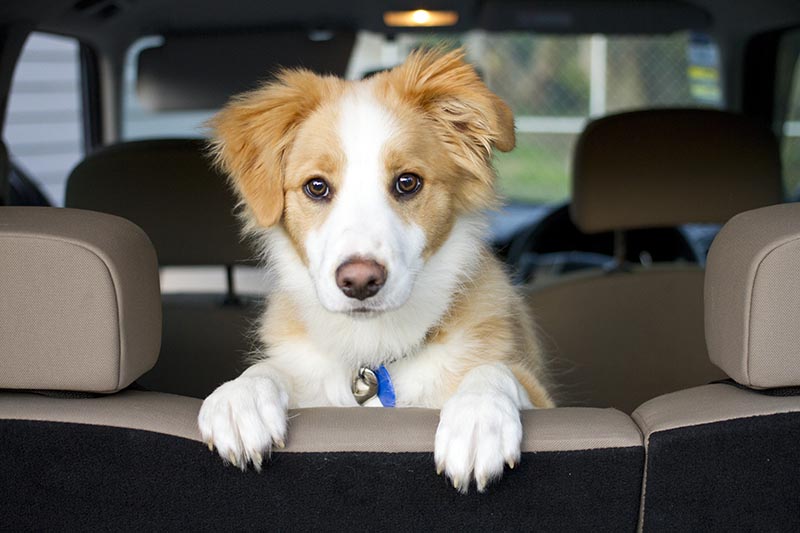
Vet approved
Reviewed & Fact-Checked By
Dr. Lauren Demos
DVM (Veterinarian)
The information is current and up-to-date in accordance with the latest veterinarian research.
Road trips are a great way to get out of the house and enjoy time away from work by exploring. They’re even better when you can take your canine best friend along.
Cars aren’t inherently geared up to be safe for dogs, though, and there are a few things that you need to sort out before you let your dog join you on a long trip. Investing in a sturdy dog seatbelt 1 and making sure the doors and windows are secure are essential, for example.
There are also a few other adjustments to your travel plans that you’ll need to consider to ensure that the journey is as fun for your dog as it is for you.
The 11 Great Tips for Traveling With a Dog in a Car
1. building up to longer trips.
To make a long car ride more comfortable for you and your dog, it’s best to build up their tolerance. Start with short drives around the neighborhood. This will help introduce your dog to the feel of the car in motion and give you an idea of how well they handle car rides in general.
Getting used to the car will help ease their nerves about trips. If they’re a puppy that has never been in a car or they associate car rides with veterinary visits, you need to teach them that car rides are a good thing.
2. Seatbelts or Restraints
For the safety of you, your dog, and everyone else on the road, it’s best if you have a way to keep your dog restrained while the car is in motion. This is important whether you’re driving alone with your dog or you have passengers who can keep them out of trouble for you.
Dog seatbelts are one way to accomplish this. These can either be leashes with seatbelt attachments or straps that hook over the headrest and attach to your dog’s harness. You can also use a dog crate or car seat to keep your dog in one place.
Not only does restraining your dog keep them from jumping around the vehicle while it’s moving, but it’ll also keep them and other passengers safe during an accident, along with helping emergency services tend to the injured without a scared, loose dog threatening their safety.
3. Empty Stomach
Dogs can get carsick just like we do. If you know that your dog suffers from car sickness or just want to make the ride as comfortable as possible for sensitive stomachs, don’t feed them as much before you set out.
For longer car trips, give your dog a small, light meal a few hours before you set off. This will digest easily and still keep your hungry pooch happy while they’re cooped up in the car.
Avoid feeding them big meals during the journey. Take along snacks that they can chew on, but otherwise, wait to feed them their dinner until you’ve reached your destination.
4. Plenty of Water
It might be a bad idea to let your dog eat big meals during car rides, but you need to make sure they drink plenty of water. Driving long distances can make it easy to forget to take breaks, and your dog is unlikely to have free access to water while the car’s moving, especially if you don’t want water spilling everywhere.
Pack a few water bottles and a travel-sized water bowl for your dog, and offer them water every time you stop at gas stations or rest stops. This is especially important if your dog doesn’t like to drink while the car is in motion.
5. Regular Potty Breaks
Car rides can be uncomfortable and boring, for your dog and for you. You might be able to keep yourself distracted from long drives by listening to the radio or chatting with your passengers, but your dog won’t be able to play while they’re restrained in a crate. While you can give them their favorite toys to play with, nothing works as well as taking frequent breaks.
Stopping at rest stops regularly enables you to stretch your legs, take a break from driving, and give your dog much-needed playtime. They’ll be able to go to the bathroom, drink water, and explore for a bit.
A vigorous game of fetch might even wear your dog out enough that they sleep through most of the trip.
6. Not Leaving Them Unattended
Summer, cars, and dogs don’t mix well. Never leave your dog in a locked car unattended, even for just a few minutes. Cars quickly become far too hot on sunny days, and your dog has a fur coat to worry about too. The opposite is true on frigid winter days. Without the heating running in the car, your dog will quickly get too cold.
It’s not just the health of your dog that you should consider. A well-meaning bystander who sees a dog left alone in a car might smash the window to get them out, even if you’ve only been gone for a few seconds.
7. Canine Travel Kit
Whether you’re taking a week-long road trip or just heading out for the day, you’re likely to only pack a few essentials . If you’re traveling alone, this can be limited to one or two small bags. Once your dog is included, though, there are a few other essentials that you need to consider.
Your canine travel kit should include all the basics: poop bags, a collapsible water dish, a dog first aid kit, your dog’s favorite toy, a few chews, and their favorite treats to snack on while you drive. You may also want to take health and vaccination records with you.
The best part is that most of these doggy essentials are lightweight. If you use a harness, you can attach small bags to it, so your dog can carry their own travel kit and everything that they need is always close at hand.
8. Microchipping Your Dog
Your dog should already have a collar and ID tag with your contact information on it, but these aren’t infallible. If your dog loses their collar or tag for any reason, there will be no way for strangers to identify your dog if they get lost. A microchip is a permanent form of identification that is always with your dog.
While it’s not pleasant to consider the possibility of your dog getting lost during your road trip, a microchip will increase the odds of them getting back to you quickly. If someone finds them and takes them to a veterinarian or a shelter, whoever scans the microchip will be able to contact you and get your dog back home.
9. Closed Windows
Many people love to let their dogs stick their heads out of the car windows during long drives. It can be cute and many dogs enjoy it, but it’s a dangerous habit to let your dog develop.
When you’re driving — whether on slow back country roads or busy highways — the wheels kick up a large amount of dirt from the road, and dust can get thrown around by other cars. There’s also the risk of an unrestrained dog spotting a squirrel on the side of the road that they simply must get to immediately.
If you do want to keep the windows open, don’t open them far enough to let your dog stick their head out. Or, only open the windows that your restrained pet can’t reach.
10. No Rides in an Open Truck Bed
Dogs can get muddy and horrifically smelly when you’re adventuring together. In these cases, riding in an enclosed car with them isn’t pleasant. You shouldn’t use this as an excuse to let them ride in the open bed of your truck, though. Packing dry shampoo or wet wipes is often enough to get your dog smelling good enough until you’re back home, or you can even bring a makeshift shower head for on-the-go baths.
If you don’t have enough room in your truck’s cabin for everything that you need to take and your dog, reconsider if you need everything that you’ve packed, find alternative transport, or ask someone to look after your dog while you’re away.
While it’s always sad leaving a dog behind, it’s far safer than risking a serious injury or death by letting them ride in the back of the truck.
11. Local Veterinarians
If you’re in an unfamiliar town, locating a veterinarian can be stressful during emergencies. Unfortunately, accidents happen, and planning ahead is the best way to make a horrible situation easier to handle.
Before you head out on your trip, plan your route. Make a note of all the places that you can stop at for potty breaks and to sleep overnight. For each place, keep a list of numbers for the nearest 24-hour veterinary clinics, especially if you’re unfamiliar with the area you’re road-tripping through. If you’re heading out for a day trip, keep your destination’s local veterinarian’s number handy.
While this might seem excessive, if your dog does get into an accident, you’ll be prepared to handle it.
Final Thoughts
Traveling is fun but stressful , particularly when your dog tags along. While there’s nothing better than going on an adventure with your furry friend, it’s important to keep them safe too. These tips not only will help you keep your dog safe during car rides but also as comfortable as possible. We hope that we have helped you plan for your next trip with your dog!
Related Reads:
- Is It Safe for Dogs to Fly? Flight Options & Preparation
- Benefits of Traveling With Dogs: 10 Advantages & Tips For Your Trip
- https://www.animaltrust.org.uk/blog/how-to-travel-in-the-car-with-your-dog/
- https://www.akc.org/expert-advice/home-living/complete-guide-to-traveling-with-your-dog/
Featured Image Credit: Aarontphotography, Shutterstock
Related Articles
Further Reading
6 Types of Poodles: A Complete Overview (With Pictures)
Feb 29, 2024 - 4 min read
10 Weimaraner Pros & Cons: Mental & Physical
Jan 11, 2024 - 5 min read
Do Australian Shepherds Shed? Care and Grooming Tips
Mar 6, 2024 - 6 min read
Vet Articles
Latest Vet Answers
The latest veterinarians' answers to questions from our database
Why You Should Never Buy a One-Gallon Fish Tank: Our Vet Explains
Answered by Dr. Paola Cuevas, MVZ (Vet)
How to Check a Dog’s Heart Rate: Our Vet’s Tips, Tricks, & Guide
Answered by Dr. Luqman Javed, DVM (Vet)
How to Cycle Your Aquarium Using Liquid Ammonia – Our Vet Explains
How Should I Introduce My Puppy to a Dominant Dog?
Answered by Dr. Joanna Woodnutt, BVM BVS (Vet)
How to Help an Abused Dog Recover: 8 Tips & Tricks
Answered by Dr. Sharon Butzke, DVM (Vet)
6 Common Goldfish Diseases: Our Vet Explains Treatment & Prevention
Answered by Dr. Iulia Mihai
Cat food recalls
Have a cat? Stay on top of cat food recalls here >
Dog food recalls
Have a dog? Stay on top of dog food recalls here >
Have a question? talk to a vet online for advice >


Road Trip! Guide to Traveling with Dogs in a Car Long Distance
A cross country trip with a dog should be fun, not stressful. We show you how to travel with a dog in a car.
Depending on your dog’s temperament and experience traveling by car, the thought of taking a long distance road trip with your pal can either conjure up feelings of freedom and adventure on the open road, or instill dread or even panic. Not to worry. We have you covered from start to finish of your journey.
Should you take your dog on a cross country road trip?
Your first consideration should be whether traveling long distance in a car with your dog is even a good idea. Sometimes it’s just not worth the hassle, and letting them stay with a trusted friend or boarding service is the better option.
Some dogs simply hate riding in a car, and if you are unable to help the dog overcome its fears or discomfort on shorter trips, then it makes no sense to try to do this on a long trip. There’s a good chance it will be a miserable experience for both of you.
Another reason to think twice about bringing your dog along is if your road trip involves lots of stops along the way (other than for gas, food, and lodging) or involves events at your destination where you can’t spend enough time with them or provide them with adequate care and supervision. For instance, driving cross country to a wedding may seem fine, but where will the dog stay all day during the wedding?
Thinking ahead and anticipating your daily schedule may lead you realize that bringing the dog along will be more complicated than it’s worth. It also might lead you to solve these logistical problems, and plan ahead accordingly! More on that below.
Well ahead of your trip, you should:
- Plan all aspects of your trip that involve your dog
- Make a list of all essentials you’ll need to bring
- Prep your dog for the trip.
Planning your trip
Do your homework and have a list of dog friendly hotels, restaurants and other places you plan on stopping along the way. It’s better to plan your trip more rigidly than you might otherwise and have the comfort of knowing in advance that your pup is welcome. A late night search for a pet friendly motel is no fun (nor is getting caught sneaking your dog in one where they are prohibited). Fortunately, the number of pet friendly places is greater than ever, and that list is growing rapidly.
Arrange for care of your dog at your destination. If you are attending an event or visiting a tourist attraction that will take you away from your dog for a period of time, you should locate a day care or boarding service in advance.
Leaving your dog unattended is simply not an option. In addition to safety issues, a new environment can stress out your dog, so make sure you have an individual or facility to take care of them. Lots of information regarding pet friendly resources at your destination can be found online. You can also ask for recommendations from the accommodations where you are staying, or family and friends you might know in the area.
Create a dog road trip packing list
It’s good to create a master packing list for your dog so that you can use it each time you travel. You may need to purchase some items to complete it, but once you have them, you’ll be ready in the future to go on short notice.
Pack a separate travel bag for your dog. Just like with our own luggage, we find that it’s easier to access what you need when you’re on the road if thing are organized.
Here’s a list of essentials from which to start.. You can modify it as needed.
Adequate food and water
Make sure you have more than enough food for your dog in case you get delayed or there’s an emergency. The last thing you want to do is have to switch your dog’s food while traveling and risk the upset stomach that commonly occurs when you switch brands or types of food suddenly.
We suggest bringing your own water, either in bottles or larger jugs/container, depending on the dog’s size. While local water may be easier, water from a new source can upset your dog’s stomach, and can also taste different enough that your dog may be reluctant to drink it. Water is as essential as it gets, so no reason to take a chance.
Food and water bowls
You’ll need bowls for both food and water. There are some great collapsible bowls that take up less space. You can also get a dog water bottle , which is convenient at rest stops and doesn’t require a bowl. Just make sure your dog is familiar with it before heading out on your trip.
Leash and collar/harness
Don’t laugh — a leash is commonly forgotten when loading a dog directly into a car from the house.
The collar should have i.d. and license tags attached. Make sure your dog’s info is up to date on the identification tags, with the correct phone number being that of the mobile phone you are carrying and not a number back home (where you will not be if the dog were to get lost). It’s also a good idea to add a second number of a friend on the tag as an extra precaution, especially when traveling.
Toys and bones
Just because he’s traveling doesn’t mean your dog doesn’t need his usual items of distraction. In fact, just like people, he may need them even more on the road to keep him occupied. Remember, it’s a long trip for them, too, and they don’t have audio books to entertain them. Also, a favorite security toy or bone can go a long way towards easing any travel jitters.

Medications
Have an ample supply of all of your dog’s medications, including any motion sickness medicine, topicals and supplements. Like food, have extra in case you get delayed on your trip or have an emergency. If any of your dog’s meds need to be refrigerated, plan ahead by bringing a cooler.
If you are headed to a different climate or an area with unfamiliar geographical characteristics, check with your vet to see if there are any special medical precautions you should take. Even though conditions such as Lyme disease, heartworm, and tick borne diseases can be transmitted anywhere, they are prone to occur in some areas more than others, and your dog may need a vaccine or preventative medication.
Note about dog motion sickness :
Dogs are susceptible to motion sickness. If your dog has ever had issues, or is new enough to you that you’re not sure, check with your vet before leaving on your trip to see if she can recommend an over-the-counter medication or prescribe one if needed. A sick dog in the middle of a car trip can quickly put a damper on the excursion.
Vaccination records
Make sure your pup is up to date on vaccinations. Generally, it’s a good idea to have a copy of their rabies vaccination if you’re crossing state lines. Laws differ from state to state, and a simple photocopy of the record can save you a big hassle in certain situations. Just leave it in your dog’s travel “go bag.”
Bring plenty to last the whole trip. No need to tell you that you should always clean up after your dog. Right?
If you run into wet weather, you will want to be able to dry your dog off and clean its paws before getting back into the car. We find shammies work well because they are super absorbent and don’t take up much space.
Familiar bedding
Whether your dog sleeps in its crate or on the floor, you will want to provide familiar, comfortable bedding to sleep on. We like to use the Petspective Pet Mat because it’s waterproof, easy to clean, and rolls up nicely to pack in the car (plus our dogs vouch for its comfort!).
Protective clothing
If your dog wears any kind of protective boots or outerwear like sweaters or raincoats, don’t forget to pack it.
Thunder Shirt
If your dog wears a Thunder Shirt for anxiety (fireworks/thunderstorm induced or just general uneasiness), bring it along. If your dog does encounter a stressful situation, you’ll be happy you have it to help calm her if it’s something that you already know works.
Stain and odor eliminator
If your dog has an accident, it’s nice to be able to clean it up properly with a good stain and odor remover and not leave a hotel room soiled. It’ll likely earn you K9 Karma points.
First aid kit
There are all shapes and sizes of medical kits, but you should bring the equivalent of whatever you use at home.

Take a test road trip with your dog
If your dog has never traveled long distances in a car, you should definitely go for a “test drive” or two well before you plan to leave on your road trip. Make it a couple of hours so you can simulate the long drive experience.
This allows you to identify any issues and address them before the long haul. Make an afternoon out of it and go somewhere fun! Try to simulate the experience, including having your dog ride restrained (more about this below) and taking some rest stops to let your dog relieve herself and have a drink of water. It’s a good time to establish road trip rules for the dog.
How to travel with a dog cross country
Exercise your dogs before you load them into the car to leave. A tired dog is a better traveler than an energetic one.
Don’t feed your dog immediately before traveling. Try to feed them 3-4 hours prior to departure to avoid an upset stomach from motion sickness.
What is best in a car — a crate, dog car seat, or dog seat belt?
Whatever you do, don’t let your dog loose in the car while driving. An accident can easily cause them to be launched, endangering both them and you.
Dogs are also known to easily distract drivers, a leading cause of car crashes. Just like people, they need to be restrained for safety while driving.
Ideally, your dog will travel in a properly sized crate anchored to the vehicle with a strap or seatbelt. A crated dog is the safest solution (especially in a crash-tested model of crate).
Dog seat belts, while helping to keep a dog distanced from the driver, are not safe at protecting dogs during a car crash.
If a crate is impossible for reasons of size, then a dog car seat is the next best option, though not ideal.
What NEVER to do with your dog in a car
Never put a dog in the back of a pickup truck, even when in crates. Amazingly, we still see this occasionally.

Never let your dog ride in the front seat. If airbags are deployed, they can injure your dog, even if they are in a crate. Regardless of how your dog is restrained while driving, it should always be in the back seat or cargo area.
Never allow your dog to stick its head out of the window, cute as it is and as happy as they might seem taking in all the smells. Believe us, your dog is smelling lots of new scents with the window closed.

Road rules for your dog
It’s best to maintain your dog’s routine as closely as you can during a road trip. Stay on schedule for meals, walks, and bedtime. Dogs love routine, and you’re already altering that routine a lot by traveling, so the more familiar the better.
Make plenty of stops to rest and air your dog. Dogs usually won’t tell you when they need to relieve themselves until they are near the panic point.
Every dog has different stretching needs , so be sure to give your dog adequate time to do so. There’s no need to make a dog jump out of the car and rush into action without stretching first. Just like us, sitting in a car for a long period of time can make them stiff or cramped.
Provide fresh water and let them eliminate. Clean up after them, of course.
Always keep them on leash, and with an id tag on their collar. A roadside rest stop or interstate exit gas station is a terrible place to have a dog running loose or getting lost. Consider having your dog microchipped if you haven’t already.
We find it best to generally avoid other dogs at these highly trafficked areas. The risks — aggressive dogs biting yours, transmission of parasites or disease, etc. — are just not worth the brief canine chit chat when traveling.
If possible, try to travel with another person who can help with the pet. It makes life easier on the road, especially when you want to use a restroom or get food so you can leave the dog supervised.
Dogs left in hot cars
We shouldn’t have to tell you this, but never leave your pet alone in the car. NO EXCEPTIONS! The number of reports of dogs getting sick or dying from being left inside a car is troubling. And it is safe to say that their owners didn’t think they were leaving their pets in a dangerous situation.
We are always inclined to think that it’s “somebody else” that does this, and that we are more careful and prudent than others when we leave our dogs “with the windows cracked open” and “just for a minute.”
The inside of a car can be much hotter than outside. A car’s interior can go from 75 degrees to 116 degrees in an hour. Studies have shown that rolling down windows has minimal effect on the interior temperature. Even with the windows cracked open, temperatures can rise from 85 degrees to 101 in 10 minutes!
In many places, it is illegal to leave your pet in the car regardless of the weather . 31 states now have laws against leaving dogs in cars. See a detailed rundown of each state here .
Obviously, there can situations where it is unavoidable, like traveling alone and having to use the bathroom. If you absolutely must leave your dog alone for a couple of minutes:
Park in the shade and lower the windows just enough to allow air in. But don’t lower them enough to let someone unlock the door. Even though it won’t keep your car much cooler, air is better than no air.
Lock your car. Dogs can be stolen (and so can your car).
Keep your dog restrained . Dogs can easily injure themselves by getting a paw stuck between seats, choking after getting tangled in a seatbelt, etc. This also prevents them from biting a stranger if they stick their hand in the car to pet.
It also prevents some “friendly” traveler from offering your dog ood through the window. We don’t want that. (I once briefly left my car to register to camp at a state park, only to later find my dog in his crate chewing a rawhide that someone must have offered him through the cracked rear window I had never once given him a rawhide, so it wasn’t me just forgetting!)
Make it as fast as possible . A few minutes to use bathroom or order food. Ordering food and returning to the car and then picking food up is a good option. Using a drive-through is an even better option.
Bring your dog with you into dog-friendly stores
An option to leaving your dog in the car is to bring them into a store with you. Many stores allow dogs inside as long as they are leashed (or held in a purse or carrier) and well behaved. Here’s a list of dog-friendly stores and some advice on making the experience positive for everybody involved, including you, your dog, store employees, and other shoppers.

Dog etiquette at hotels and motels
Make sure the establishment allows dogs. Duh. Confirm in advance whether there are any dog fees and how much they are. You don’t want surprises.
Also, be accurate when you tell them your dog’s size. As nonsensical as it is that hotels prefer small dogs to large ones, it’s better to clear that up in advance and avoid any potential problems. The definition of “large dog” varies tremendously. If there is any issue, offer to pay a deposit to put the establishment at ease.
Never leave your dog alone in a room. Even the most well behaved dogs can get stressed in an unfamiliar environment. Barking and destructive behavior are common responses to fear and anxiety.
Bring in your dog’s crate or a bed for it to sleep in. The more you can make your dog feel at home, the better. If your dog sleeps on the bed with you, make sure to bring a sheet or other cover to separate her from the bedspread (which, as we all have learned from tv investIgative reporting, are rarely if ever washed).
Don’t give your dog a bath in the shower/tub. It’s a hotel room, not an animal grooming facility.
Do your best to keep your dog from barking. Many non-barkers suddenly become barkers in motels and hotels. Everything is new and different, and they are put on high alert. Be considerate of the guests in the room next to you who paid for a good night’s sleep.
If your dog makes a mess on the carpet, clean it up (remember the stain and odor eliminator your packed?). If you can’t do so successfully, or your dog damages the room in any way, report it to the front desk when you check out. Better to resolve the problem with open communication than have the hotel coming after you later.
Crate your dog or take him for a walk when housekeeping comes. Or just ask that housekeeping skips your room during your stay. A housekeeper may not like dogs (and your dog may not like housekeepers), and it’s not part of their job to work with and get along with pets.
Finally, don’t use the ice bucket as a water bowl!
Campgrounds are a viable alternative to motels when traveling with dogs. They are cheaper, much more dog-friendly, and likely far more enjoyable for your dog, too. Of course, you have to set up a tent (see tents suitable for dogs ) and travel with some more gear, but it may end up being an easier option depending on your dog’s (and your) temperament.
Again, plan ahead to make sure there convenient campgrounds on your route, and that they have availability on your travel dates. Just like motels, be sure to make reservations in advance.
As you can see, there’s lots to think about when traveling with dogs long distance in a car. But with proper planning and foresight, you’ll quickly be able to find a routine and rhythm with your pup out on the open road. The key is to keep things as normal as you can, and with as few stressors as possible. Our idea of adventure is much different than that of our dogs. Keep that in mind and your dog will be an easy rider in no time.
Superb Dog Editor
Add comment, cancel reply.
Save my name, email, and website in this browser for the next time I comment.
You may also like

Which Stores Allow Dogs? A Guide to Pet-Friendly Retailers (2022)
Dogs are accompanying their owners in stores more than ever. Here's a guide to which stores allow dogs and how to provide the best experience for everyone involved.

The Best Tents for Camping With Dogs
Many dogs love going camping, and they'll enjoy it even more if you provide the proper tent. Use our guide to choose the best tent for your dog.

Best Bike Baskets for Dogs
Bringing your dog along on a bike ride can be both fun and convenient. We look at the best dog bike basket carriers.
A Dog’s Life
Recent posts.

Can Dogs Be Retarded or Mentally Challenged?

My Dog Was Bitten By Another Dog: What Do I Do?

My Dog Chewed a Lidocaine Patch. Should I Be Worried?

My Dog Died and I Feel Empty. What Should I Do?

Why Is My Adult Dog Pooping in the House Suddenly?

My Dog Ate Kong Rubber – What Should I Do?

What To Do If a Dog Bites You: Steps To Take Immediately

My Dog Bit Someone. What Should I Do?

What Should I Do if My Dog Ate Wax Paper?

"Every Dog is a Superb Dog"
Providing advice, opinion, humor, information, and product reviews.
Become a Superbanite!
Wanna boost your dog's superpowers? Or maybe receive positive K9 Karma? Then join our exclusive club! (You'll also get inside info and cool deals.)
- Disclosures
- Privacy Policy
Copyright © 2024 · Superb Dog
Most popular

Is the Kong Classic the Best Dog Toy Ever?

Fetch Machines for Fetch Machines! The Best Automatic Ball Launchers for Dogs

Is Tug of War Bad for Dogs?

Are Nylabones Safe for Dogs and Puppies?

How Long Should I Play with My Puppy? Puppy Playtime Guidelines
Most discussed.

14 travel essentials to keep your dog safe and comfortable on road trips, recommended by experts
When you buy through our links, Business Insider may earn an affiliate commission. Learn more
- If you're taking a road trip with your dog, you'll need to ensure their safety and comfort.
- We rounded up the best gear for driving in the car with a dog, including a dog crate and harness .
- You can protect your dog from overheating on the road with window shades and plenty of water.

Americans across the country are hitting the road with dogs as their copilots this summer. Whether your plan is to hike and camp , explore back roads and under-the-radar towns, or visit family and friends, the promise of an adventure on the open road is intoxicating not just for you but for your dog, too.
To ensure the success of a road trip with your pup, you'll need a handful of dog car travel accessories to keep them safe and comfortable during long drives. As a professional dog trainer by day and travel writer by night, I have years of experience hitting the road with dogs. I've combed through my own gear to come up with this list of essentials for a canine-friendly road trip.
For expertise on traveling safely with a dog in the hot summer months, I've consulted with veterinarian Tanya Fraser , medical director of VCA Allendale Animal Hospital in Allendale, Michigan, and Lindsey Wolko, founder of the Center for Pet Safety in Reston, Virginia. Below we've rounded up our favorite travel gear as well as tips for traveling safely with your dog .
Here are 14 of the best dog car travel accessories for a canine-friendly road trip:
A crash-tested kennel to protect your dog in a collision.
Gunner G1 Kennel, available at Gunner, from $499
According to Wolko, you should never travel with your dog in a plastic crate that has been buckled in with a car seat belt because it can easily fracture in a crash. Instead, use a crash-test-certified crate to give your pet the best possible chance of survival in a crash. The Center for Pet Safety has tested several crates for their Center for Pet Safety certified list , including the Gunner G1 Kennel, which received a five-star crash-test rating. It's also a top pick in our guide the best airline cat carriers . Crating may also help alleviate motion sickness in some dogs, according to Fraser.
A foldable car ramp for pets with mobility issues
Petsafe Happy Ride Bi-Fold Pet Ramp, available at Chewy , Amazon , and Wayfair , from $74.95
Just because a dog's mobility is limited doesn't mean they aren't an ideal road trip companion. Bring along a lightweight car ramp to make your travels with an older or disabled dog go more smoothly and save you from having to lift them in and out of the vehicle 20 times a day. In between stops, just fold up the ramp and slide it behind the seat for easy storage.
A crash-tested harness to travel safely with your dog outside of a crate
Sleepypod Clickit Sport Dog Safety Harness, available at Sleepypod, $94.99
Sleepypod Clickit Terrain Dog Safety Harness, available at Sleepypod, $94.99
Testing done by the Center for Pet Safety indicates that a crash-test-certified travel harness is an effective way to keep a dog safe on a road trip, especially a dog that has never been crate trained or that suffers from confinement distress. Sleepypod's Clickit Sport Harness and Terrain Harness each earned a five-star rating. They attach to the seat belts in the back seat of a car through built-in loops.
Read our full review of the Sleepypod Clickit Sport harness .
Shades to block the sun and keep car temperatures down
Munchkin Brica Window Shade, available at Buy Buy Baby , Target , and Amazon , from $14.99
Even with the air conditioning on full blast, the interior of the car can heat up to uncomfortable levels when temperatures get extreme outside. Sunshades can help to minimize the greenhouse effect inside the car by blocking the heat out. Don't expect them to help when you've parked the car, though. Temperatures can skyrocket inside a parked car in just minutes. "Never leave your dog in the car, even with the windows down, and even for just a few minutes," said Fraser.
A hammock-style seat cover to keep paw prints and dirt at bay
Orvis Grip-Tight Windowed Hammock Seat Protector, available at Orvis, from $189
If any portion of your road trip involves hiking, camping, or other explorations of the great outdoors, do yourself a favor and get a water-resistant seat cover to protect your car from moisture and dirt. This version from Orvis blankets the back seat and the backs of the front seats. A see-through mesh panel between the two front seats prevents your dog from feeling too isolated.
A soft, washable blanket that doubles as a dog bed
Carhartt Dog Blanket, available at Amazon and Carhartt , from $84.99
If you're exhausted by the end of a day of driving, so is your dog. Whether you're staying in a hotel or camping overnight, pack something soft and cozy for your pup to cuddle up in. I always bring a soft, washable blanket along for the ride. Not only is a blanket easy to fit into an overstuffed trunk, it's ultra-portable and can double as a dog bed whenever needed.
A pet first-aid kit just in case
Adventure Dog Series Medical Kit, available at Chewy, $27.49
From foxtails to ticks, there are dozens of nasty surprises that await your dog on a road trip. Be prepared for the dangers in your path with a high-quality pet first-aid kit. Fraser also recommends downloading the American Red Cross's Pet First-Aid app to help you navigate minor injuries. If you're headed for a specific destination, she suggests looking up a local emergency clinic before you arrive.
An insulated water bottle with a dog bowl built right in
Kong H20 Stainless Steel Dog Water Bottle, available at Amazon and Chewy , from $11.21
Whether you're on a nature walk or in a socially distanced beer garden, keep your dog hydrated with a combination water bottle and dog bowl. This version from Kong is made of insulated stainless steel that will keep liquids cool and refreshing all day long.
A spill-minimizing bowl so your dog can quench their thirst anytime they want
Heininger Waterboy Portable Pet Bowl, available at Chewy, $24.95
Heininger's portable water bowl, which has a reservoir that fills with water when laid flat, has lived in my car on and off for years. Leave it out while you drive — the well has been designed to minimize spillage — or stand it up to drain the well water back into the jug. The BPA-free device holds up to 3 quarts of liquid.
A long line to let your dog safely explore new environments
Signature K9 Biothane Long Line, available at Amazon, from $34.99
Even if your dog has an excellent recall, the allure of the new environments they'll be exploring on your road trip may prove more powerful than your cue. Bring along a 15- to 20-foot long line to give your dog some freedom while ensuring they remain out of trouble.
Interlocking treat-dispensing puzzle toys to help alleviate boredom
West Paw Toppl, available at Chewy , Walmart , and West Paw , from $18.95
Keep your dog from getting restless on the road by occupying them with treat-dispensing puzzle toys. West Paw's Toppl can be stuffed with treats, spread with peanut butter, or sprayed with cheesy goodness. For smarty pants dogs, try combining a large Toppl with a small one to create a toy that's a bit more challenging.
Grooming wipes or waterless shampoo to quickly remove grime and nasty smells
Earthbath Green Tea & Awapuhi Grooming Wipes, available at Petco, $15.99
Bodhi Dog Waterless Lavender Dog Dry Shampoo, available at Chewy and Amazon , $13.99
On the road, there may be hundreds of miles between you and the closest dog-washing station, but if your dog is living their best road trip life, chances are they'll need at least a little cleanup before your trip is over. Grooming wipes are an easy way to freshen up your dog's coat or remove debris from their paws or muzzle. If you've got a dog that loves to roll in stinky things, I can tell you from experience that you'll need something stronger to remove the stench. A waterless dog shampoo works a bit better and it never hurts to bring a bottle along for the ride.
A dog-size backpack for outdoor adventures
Ruffwear Approach Dog Pack, available at Ruffwear , Backcountry , and REI , from $53.93
If you plan on doing a lot of hiking or backpacking on your road trip, it's only fair that your dog should carry their share of the gear. Always limit your dog's load to no more than 25% of their body weight and make sure the pack fits properly before your adventure.
A folding travel crate for use inside a hotel room
Orvis Hose-Off Folding Travel Crate, available at Orvis, $159
To keep everyone safe when you leave your hotel room, you'll need a portable crate to set up inside your room. While most hotels don't require this, I've heard one too many horror stories about a hotel staff member who has been bitten after walking into a room with a canine guest. Choose something that collapses flat and has a handle for easy carrying. I like Orvis's version, which also has two doors and plenty of ventilation and comes with a padded fleece mat.
Additional safety tips for road trips with dogs
To ensure the success of a road trip with your pup, you'll need a handful of items to keep them safe and comfortable during long drives. Dogs also need regular breaks from the road, just like we do. "Stopping every few hours to get out, move around, and use the bathroom is ideal," said Fraser.
All that driving also increases the possibility that your dog may, at some point, experience some car sickness. Most dogs outgrow motion sickness in puppyhood, according to Fraser, but if your dog is prone to nausea in the car, things like withholding food for a few hours before traveling or letting your dog see out the window can help. Roll down the window for additional airflow but not so low that your dog can thrust their head into the wind. That's very dangerous. "You know the sound your windshield makes when a rock hits it? Imagine your dog being hit by that rock. Ouch!" Wolko said.
Before you embark on your trip, Fraser recommends making sure your pet is up-to-date on their vaccines and parasite control. Consult your vet if you have questions. They can also provide you with anti-nausea medication if your dog frequently experiences motion sickness.
- Main content
The safest way to travel with dogs

There’s something idyllic about taking to the open road with your dog by your side ― seeing their head hanging happily out of the window from your rear-view mirror, their faces warm in the sun, their ears flapping in the wind.
However, some of what we love most about driving around town with our constant companions may not be wise.
Whether you’re taking your pup to the pet supply store for some quick socialization or embarking on a cross-country road trip for the holidays, here’s what you should know to keep you and your best friend safe.
@animalhumanemn How do you keep your pet safe in the car? #dogsoftiktok #AnimalHumaneMN #travelwithdogs #cattledog ♬ Countless - Official Sound Studio
Buckle up your pup
Seatbelts are lifesaving — for people as well as pets. Any time you take your dog in the car it’s crucial they are secured.
Kennels are the best way to keep your pooch safe and ensure they aren’t distracting you while you navigate and drive.
However, if you’d prefer to keep an eye on your buddy during your trip, you can purchase a harness or car seat that buckles into your vehicle’s seatbelt system.
Not only will keeping your pet secure prevent injuries from an accident, but it can also protect you and others in your car as pets can become dangerous projectiles during a crash.
According to Allianz Life Insurance Company, if a car crashes at a speed of just 25mph, an unrestrained dog can be projected forward at a force equal to 40 times their weight. That means a 50-pound dog can achieve an impact force of 2,000 pounds in a car crash!
Though many states, including Minnesota, don’t have a specific law prohibiting dogs from being loose in your car, you could still get pulled over — and even receive a ticket — if an officer determines your dog was distracting you from driving or obstructing your vision. And wrangling a loose dog in your car while talking to a police officer can lead to other unwanted challenges!
Windows up for a healthy pup
We know how much dogs love sticking their heads out of the window to catch some breeze, and there’s something magical about seeing your dog so happy. Unfortunately, it’s not a safe habit for your four-legged friend.
Eye injuries, from dirt, rocks, dust, and other debris, are common when dogs have their heads outside of moving cars. Even a small amount of debris or a slight scratch to their cornea can cause serious damage resulting in time-consuming and expensive vet visits.
Ears flapping from high speeds can also result in lifelong problems for your pup. If you notice your dog’s ears are irritated or even swollen after a long car ride, you may want to think twice about lowering the windows the next time you hit the road.

Know your dog’s speed limits
Every pup is different. Some jump with excitement the second they hear “car ride,” while others can be downright terrified by the experience.
Many dogs that are fearful or anxious about riding in a vehicle will insist on curling up in your lap ― their safe space.
If this sounds like your dog, check out our tips for training your dog to tolerate car rides , or talk to a vet or behaviorist for more help.
They can prescribe situational medications to help with temporary anxiety and training methods to help you desensitize your doggo to life on the road.
Arriving at your destination
These precautions may seem like a lot, especially if you’re used to frequent car rides with your dog riding shotgun and have never had an issue.
As responsible pet parents, it’s up to us to examine our habits and admit when they aren’t safe.
Whether you’re traveling with dogs or your feline friends , the most important thing is arriving safely at your destination.
Sign up for AHS email
If you found this article helpful and want more information about pet parenting, sign up for email from AHS . You'll receive behavior tips, stories about adorable, adoptable animals, and more!
SIGN UP NOW
Related Resources

For caring, compassionate advice and resources to address all your animal concerns.
Contact the Pet Helpline
Skip Navigation
Where To Buy Sign Up & Save

- FIND THE RIGHT FOOD FOR YOUR DOG
SHOP BY AGE
- Adult (1-6) Dog Food
- Adult (7+) Dog Food
- Adult (11+) Dog Food
SHOP BY BRAND
- Prescription Diet
- Science Diet
- Bioactive Recipe
COMMON HEALTH CONDITIONS
- Food & Environmental Sensitivities
- FIND THE RIGHT FOOD FOR YOUR CAT
- Kitten Food
- Adult (1-6) Cat Food
- Adult (7+) Cat Food
- Adult (11+) Cat Food
- Skin & Food Sensitivities
- Our Company
- Nutritional Philosophy
- Sustainability
- Ingredients
- Quality & Safety
FOR PET PARENTS
- Information for New Pet Parents
- Articles and Education
- Puppy Nutrition
- Kitten Nutrition
COMMUNITY SUPPORT
- Food, Shelter & Love Program
- Natural Disaster Support
- Shelter Partners
- Pet Adoption Resources
- Contact Hill's
- Frequently Asked Questions
- Chat with Us
- Press Releases

COMUNITY SUPPORT

The Safest Way to Travel With a Dog in the Car
Learn more about Hill’s commitment to sustainability
Find food that fits your pet’s needs
Find a dog food that fits your pet’s needs, find a cat food that fits your pet’s needs.
If you like to travel, you probably have a road trip checklist that includes snacks, water and entertainment for the long hours ahead. Do you have a similar checklist for your furry four-legged travel companion?
The safest way to travel with a dog in the car is to be prepared. Adding a dog to your long-distance trips doesn't have to be difficult. If you follow a few best practices for driving with dogs you can make the trip less stressful for both you and your dog.

1. Restrain Him
The safest way to travel with a dog in the car is to secure him in a crate . If that isn't an option, try a seat belt specially made for dogs. We've all seen a dog with his head lolling out the window as his pet parent zips along in the passing lane, but letting a dog roam around your car is not safe. A dog who's unrestrained in a crash could be ejected from the vehicle or injured by an airbag. It's also for driver and passenger safety: If a dog gets nervous or excited on the road and begins bouncing around the car the distraction could cause an accident.
2. Make Sure He Wants to Go
While many dogs are excited about taking a ride in the car, others are not interested. Dogs can get carsick, become anxious or otherwise prefer to stay on solid ground. Take your dog for test drives before setting out on an epic road trip to gauge his comfort level in the car. If he's nervous you might want to consider finding a pet sitter or kennel for him instead. If you must travel together by car, talk to your veterinarian about possible solutions for car sickness or anxiety.
3. Prepare a Pet Travel Kit
Just like your own travel bag, a kit for driving with dogs should have snacks (dog food and a bowl), drinks (water and a bowl) and entertainment (nylon bones or a favorite toy are a good start). The pack should also contain a leash, grooming supplies, waste bags and any necessary medications. Your pup may appreciate a comfy blanket to rest on if you expect it to be cold or there is no dog bed in his crate. Need more ideas? Make a list and check it before every trip. Make sure to keep any food, treats or medication out of his available reach though. What you don't want is to wind up at your destination only to find out that you need to make a trip to the pet store to pick up more food because he secretly ate his trip rations in the back of the car.
4. Update His Tags
The worst feeling in the world is to realize your dog has gone missing. Before setting out on a road trip — or any time you change your address — make sure your dog's tags are up to date. You should also check that the address and phone number on his microchip are current. You don't want to lose your pup hundreds of miles from home! If your trip takes you out of state or out of the country, be sure to bring his most recent vaccination tag or proof of a rabies shot to comply with local pet laws. It is always a good idea to check country, state and local pet laws before bringing your dog with you to ensure you are compliant with all of the requirements.

5. Keep Him Hydrated and Comfortable
You might want to just keep driving to get to your destination as quickly as possible, but a long trip with no breaks isn't fair to your dog. Bring jugs or bottled water for your pet, and give him a water break — along with a chance to stretch his legs and relieve himself — every few hours. Unless you're going on a multi-day trip, avoid giving him food during a road trip. You could easily wind up with a carsick dog. It's a good idea to plan out your stops in advance of your road trip to ensure that he will have amble grass to relieve himself.
Doggy comfort stops can be an adventure all by themselves. Find restaurants with outdoor seating, take turns at rest stops and search for pet-friendly hotels. Never, ever leave your pet alone in the car, even with the windows cracked. A locked car can quickly and dangerously overheat. Many states even have laws that allow them to break into your car if they see your pet is left alone in a car.
Finally, make sure your pup has a relaxed ride by keeping the car a comfortable temperature for him. You can open the windows if he's in his crate, but avoid letting him stick his head out since he could injure himself. Never let him ride in the back of a pickup truck outside of a secured crate.
Feeling a little more ready to take on a road trip with your pup? Great! With a little preparation, you will both have a great journey and make lots of memories together.
Contributor Bio

Kara Murphy
Kara Murphy is a freelance writer and pet parent who lives in Erie, Pa. She has a goldendoodle named Maddie.
6 Practical Tips for Taking a Road Trip With Your Dog
These tips could make all the difference between a fun trip and a lot of stress—for you and your dog.
After loving 19 cats, 11 dogs, and a canary, Tracey married someone allergic to all those creatures. Thankfully, she receives oodles of animal goodness sharing stories on Daily Paws! When not traveling, teaching yoga, or doing voiceover projects, she's an editorial strategist and developer for print, digital, and multimedia platforms.
:max_bytes(150000):strip_icc():format(webp)/TK-headshot-dca429224052414a8f7405a9f66233de.jpg)
"A vacation isn't a vacation unless the dogs come along," Colby Lehew says.
The owner of Dogletics , a dog training and walking company based in Chicago, is serious about her love of going on road trips with her dogs in tow. So much so, she named one of her two Australian shepherds Haven after her favorite road trip destination of South Haven, Mich., about a two-hour drive from home. On several occasions every year, Lehew loads up her car with 2-year-old Haven and 4-year-old Loki. And she isn't the only one.
According to the 2021-2022 National Pet Owners Survey conducted by the American Pet Products Association (APPA) , 70 percent of U.S. households (or 90.5 million families) have a pet. And more than 60 percent of pet owners love taking their furry friends on vacation and are always in search of the next dog-friendly destination.
As you're planning a future road trip with your dog, it's important to consider how to make the event safe and stress-free for your pup so you can all get excited for the adventure.
6 Practical Tips for a Road Trip With Your Dog
1. create positive associations with your car.
"A lot of dogs are afraid to go for a ride in the car because the only time they go anywhere is when you take them to the vet or to get groomed," Lehew says.
If this is the case with your pet, you may want to start planning some fun things locally to get your dog more excited to go with you and be more comfortable in the car . That way, he won't associate car trips with stressful situations. Take him to a dog park or visit a nearby pet store and make sure he gets a treat out of the excursion.
"If you constantly do fun things, they will no longer be afraid, and from there you can go so far as to start planning a cross-country road trip with your dog," Lehew explains.
It's a good idea to start with small distances (30 minutes to two hours) before traveling long distances, and to pay attention to stress signals from your pooch. These signs can come in the form of yawning a lot , licking their lips, or even vomiting .
Another important thing to think about when bringing your dog along on any car trip is how to secure him safely . There are several types of restraints, and it pays to do some research on what kind of travel gear you should get for your individual pet, including a carrier, harness, crate, or a car seat.
2. Know How to Ease Motion Sickness
Wonder how to travel with a dog who gets car sick? It doesn't happen to every furry pal, but there are some key reasons it might. Kingsbrook Animal Hospital notes that it's common with young dogs under a year old because parts of their inner ears, which affects orientation and balance, aren't fully developed. Other dogs also have middle- or inner-ear infections or vestibular disease that causes nausea.
Additional symptoms of motion sickness include:
- Excessive drooling
- Lethargy or inactivity
- Extreme restlessness
If your pup is fairly acclimated to riding in the car but still prone to getting queasy, help them stay calm by keeping the interior cool, especially where they're riding. Maybe only offer a small nibble 6–12 hours before the trip starts to reduce the chances of stomach upset, and have plenty of fresh water available.
Finally, talk with your veterinarian about anti-nausea medications, such as Cerena , that may help. However, if your poor pooch has anxiety-induced motion sickness, your vet might prescribe something to help mitigate that first.
3. Research Dog-Friendly Destinations
When preparing for a road trip with your dog anywhere in the U.S., try to plot out a few fun dog-friendly stops along your route. This will give both you and your pup opportunities to stop and stretch your legs, as well as take in more of the sights in different areas before reaching your final destination. Especially if you can stop in places with walking trails to get your dog some much-needed exercise .
"I like to look at AllTrails for great places to go with Loki and Haven," Lehew says. "You can filter by dog-friendly trails. It's a great app to look at when planning road trips with dogs."
Before you leave home, do some research on dog-friendly places you can go to and activities you can partake in together. This will come in handy when you get to your final destination so you can start enjoying day one of your vacation. This could include dog-friendly restaurants , breweries, and wineries , as well as hiking trails or nature preserves, beaches , lakes , and anywhere else that piques your interest.
Apps like BringFido or BarkHappy are free and helpful resources for pet owners looking for pet-friendly travel options, and can help you find many attractions both you and your canine companion can enjoy. This includes pet-friendly Airbnbs , hotels , and cabins .
4. Plan for Emergencies
One of the best tips for traveling with your dog in general is to mentally prepare for any potential emergencies. This means researching emergency vets and pharmacies local to your destination and putting those numbers into your phone. And make sure you have your own vet's 24-hour emergency helpline (if they have one) in your contacts.
Some signs to look for that would indicate a potential emergency include:
- Obvious injury or bleeding
- Signs of poisoning
- Allergic reaction
- Excessive vomiting
Make sure you know some basic dog first aid techniques such as how to do CPR or the Heimlich maneuver , and always ensure your dog has an updated microchip and wears a collar with ID tags in case he gets lost.
5. Also Plan Potty Breaks
Try to stop for a bathroom break once every 90 minutes, Lehew recommends. While putting together your itinerary, check maps to see where you can stop along the way and make an effort to visit a few parks or trails so your pooch can run around for longer than just a few minutes.
"Just like it can be hard for a child to sit in the car for a long period, it's the same for many dogs," Lehew says.
6. Exercise and Play Often
Abide by your dog's exercise needs, even while traveling. This ensures they'll stay in tip-top shape the entire trip. Couple regular opportunities to leave the car with special vacation toys that your pooch can only play with while on excursions away from home. This positive reinforcement training means soon, your pup will point a paw in the direction of your next adventure!
Related Articles
More related articles.
- Dog Accessories
- Dog Bowls & Feeders
- Dog Carriers & Travel Equipment
- Dog Cleaning & Potty Equipment
- Dog Crates & Pens
- Dog Grooming
- Dog Leashes & Collars
- Dog Technology
- Dog Food By Brand
- Dog Food By Breed
- Dog Food By Condition
- Dog Dental Health
- Dog Flea & Tick Treatment
- Dog Health Conditions
- Dog Health Products
- Dog Supplements
- General Dog Health
- Dog Behavior
- Carrier & Travel Equipment
- Cat Accessories
- Cat Grooming Equipment
- Cat Leashes & Collars
- Cat Litter Equipment
- Cat Trees, Condos & Scratchers
- Cat Food By Brands
- Cat Dental Health
- Cat Flea & Tick Treatment
- Cat Health Conditions
- General Cat Health
- Cat Behavior
- Food Treats
- Cages Accessories
- Guinea Pigs

Car Travel With Dogs: The Essential Guide

The great American road trip is a big part of the US lifestyle but what happens when you get a four-legged friend? Is this a part of your life that you must give up forever? The answer is a definite ‘No’ because there is no reason why you cannot take your dog with you.
With some careful planning and preparation, your pooch can enjoy the trip just as much as you do. Here’s an essential guide to a successful road trip with your dog.
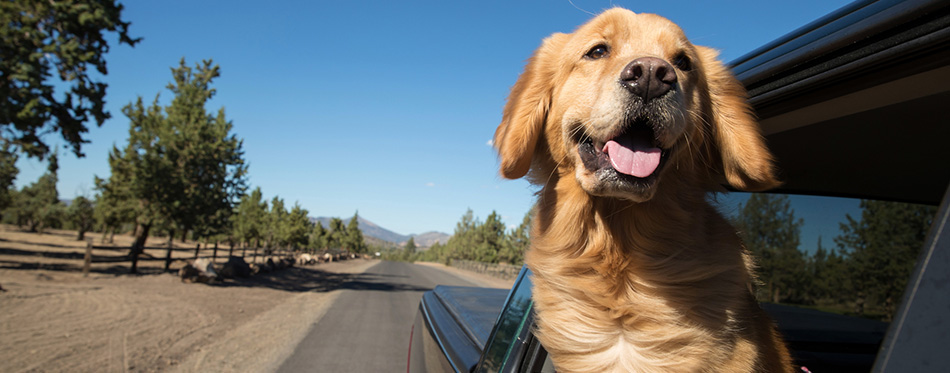

Planning the Trip – What You Need to Buy
The more planning you do, the more successful your trip will be. If your dog is relaxed and happy, you will be too. The key to a smooth road trip with a dog is the correct equipment.
Start by deciding how you will restrain your dog in the car. The word ‘restrain’ may seem a bit extreme but it simply is not safe for your dog to wander around the car whilst you are traveling on the highway. Sadly, collisions can and do occur and even though you are a very careful driver, there are others who are not.
An unrestrained dog is a danger to themselves and to others in the car should a collision take place because they will be flung around inside the vehicle. Also, an unrestrained dog can get very excited and rush around from one seat to another. This is distracting for the driver and could even get in the way of the driver reaching the controls. Some States require dogs to be suitably restrained within the vehicle so you may even be breaking the law. Finally, having an unrestrained dog in the car may breach the terms of your insurance policy and you may find that you cannot make a claim if you have an accident.
You have two options for restraining your dog in a vehicle which are a dog crate or a dog harness with a dog seatbelt . You may also like our articles on dog car seats and dog car barriers .
- Dog crates for car travel
This is by far the safest method for you and your dog. Crates come in all shapes and sizes so you will be able to find one that fits in the trunk of your car. However, crates can also be thrown around the inside of the car in an accident and present a hazard to the occupants of the vehicle so they must be tied down. There may be specific anchor points and ties so that you can secure the crate into place. Alternatively, you can use your own ropes or bungee cords to keep the crate in position should you be involved in an accident.
A crate is a considerable financial investment but you can also use it inside your home or when you are visiting other houses.
Take a look at our reviews of Dog Crate Pads and Dog Crate Covers for more options.
- Dog harness and seat belt
If space is very limited in your vehicle, an alternative to the crate is a harness that fits around the dog’s body and fixes onto the car’s seatbelt. In the event of a collision, your dog will be restrained. This is not as safe as a crate but is better than nothing.
You should not put your dog in the front passenger’s seat of your car, they should always be secured in the back seat. The airbags in the front seat are designed for a human and not for a dog and could cause serious injuries. Head over to our review of the best dog car harnesses for more options.
Obviously, you will do all you can to make sure that your dog does not go missing during your road trip but it is a possibility. It is most likely to happen during rest stops, particularly if your dog becomes frightened in unfamiliar surroundings and runs off. It is vital that they have a collar with your contact information or have a microchip. Don’t forget to make sure that this information is up to date before you set off.
- Food and drink
Even short road trips will require water stops and longer trips will require breaks for your pooch to eat, drink and have a pee or a poop.
It’s a good idea to invest in some collapsible food and drink bowls and some are small enough to fit in your pocket. Take adequate quantities of your dog’s usual food and dog treats and try to keep to their feeding routine as much as you can. This is not the time to experiment with a different type of food because a dog with a stomach upset is no fun on a long road trip! It may be a good idea to take some bottled water just in case you can’t find a fresh supply of drinking water on your journey. Find out more about dog water bottles here.
- Emergency travel kit
Traveling with a dog is a bit like traveling with kids, you need to prepare for any eventuality! However, you have to balance this with how much room you have! Here are some things that could be useful:
- Injury treatments . First aid materials such as bandages or liquid bandage , animal pain reliever and wound cleaner. For more options, check out our detailed review of the best dog first aid kits .
- Anti-nausea medicine . You can get this from your vet if it is required by your dog.
- A current photo of your pet . In case your dog goes missing at a rest stop.
- Poop bags . Essential for rest stops – make sure you have plenty of them.
- Extra dog toys . To keep your pooch amused in the crate and on rest stops.
- Cleaning wipes and paper towels . Very important for clearing up accidents and after feeding. For more options, check out our detailed review of dog wipes .
- Extra collar and dog leash . Just in case the original leash and collar get damaged.
- Very useful for constraining your dog if necessary.
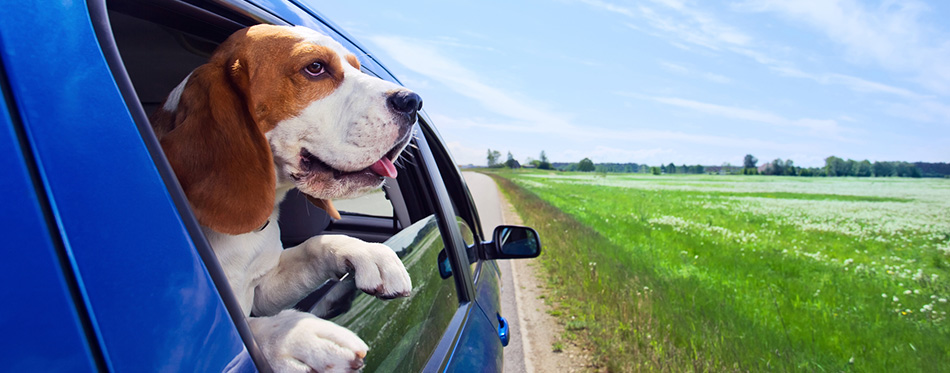
Preparing Your Dog for the Trip
The dogs that most enjoy road trips are the ones that are accustomed to traveling in cars and that are confident and happy in a vehicle. Remember that when your dog is enjoying your road trip, you are more likely to have a good time too so make this your aim!
Overcoming Car Fear and Phobia
You need to start preparations when your pup is small. Make car journeys a part of their socialization training. Start off by simply taking them inside a parked car. Then, introduce the crate or the harness and allow them to become accustomed to that. Of course, you can continue crate training inside your house too. Now, you can start the engine to allow your pooch to become familiar with the sound and the vibrations of the engine but don’t actually drive off anywhere.
Once your pup is comfortable with the crate or the harness you can make frequent, short journeys but always have one adult to drive and another to keep an eye on your pup. Gradually build up the length of the journeys.
It is important that your pup learns to associate your car with a fun experience so take them somewhere that they like. This could be the park or the beach. If you only ever take them in the car to the vet, this can lead to a type of car phobia especially if they don’t like the vet!
You can prevent car phobia from developing by giving them a nice treat like a game or a walk at the end of every car journey. You want your pooch to think that cars are fun!
Car Sickness in Dogs
Some dogs do suffer from car sickness and this makes the journey very unpleasant for them and you! It can affect all breeds but is more common in younger dogs so your pup may grow out of it. It is thought that the ear structures used for balance are not fully developed in pups and this makes them feel sick in a car.
This is a problem because a pup that has been sick in your car will now associate car journeys with feeling ill even after their delicate ear structures have fully developed. Therefore, it is important that you take steps to make your pup feel better.
Some motion sickness is caused by stress so use the above methods to acclimatize your pup to car travel gradually and to make it a positive experience. Feeding your pup just before a car journey is also a bad idea. Give them an hour or so to digest their meal. Traveling on an empty stomach is not advisable either. Make sure that the car is not too hot and that it is well-ventilated.
However, if your dog is still suffering, you should speak to your vet about getting some medication for car journeys before car phobia sets in. Remember that car sickness does not always result in actual vomiting so watch out for other signs that your pup is feeling poorly. Some signs of car sickness in dogs include listlessness, yawning, panting and excessive drooling.
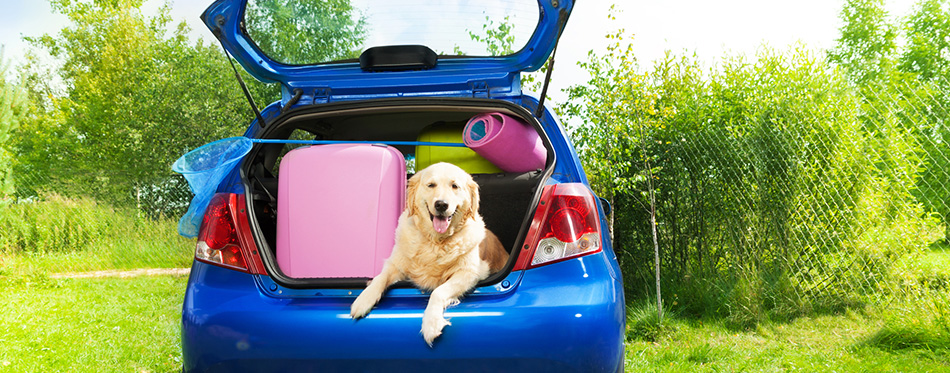
On the Car Journey
On the day you set off, gather together everything that you will need for your journey. Give your pooch a light meal and allow at least an hour or so for them to digest it. Preferably, take your dog for a walk so that they have had some exercise.
Now you can settle them into their crate with some reassuring words and a favorite toy or blanket. Double check that the crate is secured. Make sure that there is plenty of ventilation and that the car is not too hot. Remember that your pooch is wearing a fur coat so they may need it a little cooler than the human occupants of the car. If necessary, pop the AC on to keep your dog comfortable. Also, be aware that direct sunlight can create hotspots within the car so some shading may be needed.
The key to a successful road trip with a dog is taking plenty of breaks. Plan your journey in advance and choose locations where it will be suitable to exercise your dog . Take them for a walk around and have a poop or a pee if they need to. Offer them some fresh water. On long journeys, you may need to feed them but remember to allow them time to digest the food before you set off again. Some service stations have designated dog walking areas but parks or dog-friendly attractions are just as good.
Never leave your dog unattended in your car. Dogs cannot sweat and therefore cannot cool themselves down so it is possible for them to overheat very quickly. It is not sufficient to wind down a window, this will not cool them down. Also, remember that your dog is in unfamiliar surroundings and is likely to become very distressed when you walk away from them.
Some dogs can get overstimulated during car journeys and this is probably caused by a combination of the movement of your car and the sight of other cars and objects moving quickly across the window as your car speeds along the highway. An over-stimulated dog will bark a lot and if your dog has started to do this on car journeys, a crate can help to solve the problem. Also, give them a puzzle toy stuffed with their favorite treat to keep them busy and stop them looking out of the window. If you are looking for more options, check out our guides on interactive dog toys and toys for blind dogs .
Car Travel With Dogs: Dream vs Reality
It may look cool to be hurtling down the freeway with your four-legged friend next to you in the passenger’s seat with their head sticking out of the window but this is for movies and not real life! It presents all sorts of dangers for both of you and could result in a very nasty accident. Responsible dog owners do not let their dogs stick their heads out the window unless the car is stationary.
The reality is that a road trip with dogs can be a lot of fun but only if you prepare and plan carefully to keep your dog safe and happy. Have a great trip!
Related Reads
10 Essential Tips When Hiking With Your Dog
10 Tips To Make My Dog More Obedient
8 Dog Walking Tips Everyone Should Know
What to Do if You Lose Your Dog
Tips To Introduce New Dogs To Older Dogs
12 Steps To Help Improve Your Dog’s Recall
The Best Dog Travel Crates in 2022
The Best Dog Ramps in 2022

PetSide ©2024
- Privacy Policy
- Affiliate Disclosure
- Medical Disclaimer

Home » Grooming and Care » 5 Tips for Traveling With Dogs in a Car (Especially When They’re Big)
5 Tips for Traveling With Dogs in a Car (Especially When They’re Big)
This post may contain affiliate links. If you click and buy we may make a commission, at no additional charge to you. Please see our disclosure policy for more details.
For many families across the United States, their pets are seen as an extension of their family.
So it’s only natural that both children and adults alike would opt to take their canine friends along for the ride on their next family holiday.
However, there’s much to consider before exposing your dog to a long and, at times, uncomfortable travel environment inside a car.
So if you’re considering traveling with dogs in the near future, here are a few pointers to ensure their trip is as comfortable as possible.
Table of Content
Traveling with Dogs: What You Need to Know?
Nowadays, traveling with a dog has become far more common-place than in previous years.
Many airlines, hotels, and other forms of transport have changed their policies to allow for furry family members during travel.
Despite this increase in popularity, what’s really important to consider is whether your dog is fit for travel and what they can withstand.
Just because they cannot physically voice their discomfort doesn’t mean that a dog cannot be traumatized by a travel experience. If you plan on traveling with your dogs by car on your next family holiday, here are a few things to keep in mind.
Preparing for Your Road Trip
If you do decide to take your canine companion along for the road trip, you’ll need to do some preparation beforehand.
Make sure to do some research on canine laws and travel restrictions in your state and the state you’re traveling to.
Check that the accommodation you’ll be holidaying at welcomes dogs and is briefed on the fact you’ll be bringing your dog along. This is especially important for larger breeds of dogs, as many accommodations may only allow smaller pets.
If you’re nervous about your dog getting lost in a new environment, it would be worthwhile having them microchipped.
During this pain-free process, a vet inserts a microchip just under the surface of their skin which contains all identification information. Alternatively, always ensure your dog is collared with a tag which includes contact and identification information.
Before your departure, take your dog to the vet for an overall health checkup and have them cleared for travel. Remember to pack their health and vaccination certificates with you.
Don’t forget to pack dog medicine, such as calming chews in the case of anxiety or motion sickness. Otherwise, consult with your vet on the best solutions for keeping your dog well during car travel.
For large dogs, it’s worth investing in a canine seat belt, such as the Mighty Paw Safety Belt to keep them in place during your journey.
5 Top Tips For Car Travel with Dogs
If you’ve determined your dog can handle the trip, ok! Time to think about how to make the journey easiest. Hit the road with your furry family member in tow with these 5 simple tips to ensure they enjoy the journey too.
1. Store Pet Food With Care
If you’re traveling during the warmer months of spring and summer, beware of the dangers of pet food exposed to heat and direct sunlight.
Foods high in fat, with added oils and omega-3s, will spoil at a faster rate as the fats tend to break down in high heat.
This can make your dog sick and will not be a very pleasant experience inside your vehicle!
Make sure to store pet food in an airtight container and a cooler to keep it dry and cool. Don’t leave pet food in a hot car, take it inside with you.
If you don’t want to feed your pet human treats, pack a container of doggie treats so they feel included at pit stops.
2. Feed Your Dog Water Frequently
Dogs are highly susceptible to heatstroke inside a moving car – their air is stuffy and they tend to get hot easily. This is especially pertinent to large breeds of dogs.
Make sure to offer them water in a collapsible dog bowl every 2 hours, at least. Keep in mind that picky pets may not drink water that smells or tastes different from what they’re accustomed to.
If your dog is on the picky side, pack a few bottles filled with water from home. You will gradually have to introduce them to new tasting water along the journey.
Make sure to take regular breaks for a quick walk, potty break and the odd treat here and there!
Plan your stops around areas where you have access to walk freely for a few minutes.
3. Avoid Opening Car Doors or Windows With Unrestrained Big Dogs
The urge to break free and run wild is innate for most larger breeds of dogs, especially when couped up in a small place such as a car.
The last thing you want is your big dog jumping out into the street, at risk of getting lost or worse, hit by a car.
Whenever you come to a pitstop, make sure their lead is attached or their dog seat belt is in place. Keeping the window ajar is advisable so they can poke their head out if need be.
4. Feed Your Dog Before Departure
In order to avoid unnecessary accidents in the car, it’s important to make sure your dog is fed at least a few hours before your departure.
Feeding a dog in a moving vehicle can only increase their chances of experiencing motion sickness.
Likewise with exercise. Ensure they have had their walk well in advance to your departure so they’re not hot and thirsty sitting in the car.
5. Avoid Transporting a Big Dog in a Truck Bed
If you have a pickup truck and think this is the easiest way to transport your canine companion, think again.
Unless the bed of your pickup truck is covered by a canopy, your dog is at risk of jumping out the back or being propelled out after one abrupt stop.
Additionally, the heat of summer can warm up the metal of the bed of your truck, which can actually burn your pet’s feet.
Things You Should Have Before Traveling With Dogs
Traveling with your favorite pooch might be a thrilling and memorable experience for you. But as a pet parent, you need to ensure that your furry friend is comfortable during the journey. Let’s have a look at the ways that you can follow to make your travel a seamless experience.
1. Adequate Food and Water
To begin with, you need to carry ample food and water while traveling with your dog. Dogs tend to feel hunger and thirst more often than humans, and you need to fulfill your dog’s hunger and thirst as and when required.
Additionally, many times local restaurants or hotels may not be dog-friendly. It may become difficult to buy anything edible for your dog from those places. In such cases, you may have to feed your dog inside your car only. Ready-to-eat meals or snacks and cool and refreshing water can be immensely helpful in such situations.
2. Food and water bowls
While traveling, you need to carry food bowls and water bowls as well. You can’t keep your pet hungry and thirsty, and if you are in a car or a train, you need to give food and water to your pet at regular intervals. This is where food and water bowls will come in handy.
It may be difficult for you to carry the regular food and water bowl that your dog uses. So, it is recommended to get a portable one, which is lighter, occupies less space and is easier to carry for you.
3. Leash and Collar/Harness
You need to carry a leash and harness as well. It’s better to have a leash with a tag (with all the relevant details) and put it on your dog right at the beginning of the journey. This will ensure that your furry friend does not get lost.
Besides, new surroundings can excite your dog, and it can run away. Hence, a short but sturdy leash is recommended. The leash should not be more than six feet in length. This will enable you to keep your pet by your side and keep it under control.
4. Toys and Bones
You should also carry some toys and chewing bones for the journey. Toys are one of the best solutions to keep your dog engaged while it is restrained inside a car. It will also help you to focus better on the road ahead and reach your destination.
Chewing bones, just like toys, are equally important during a journey. Dogs can get tired of toys, and it is better to give them chewing bones than to keep them occupied during the journey. Many chewing bones are hollowed at the center. You can fill that up with some delicacy that your dog loves.
5. Medications
Although dogs love to have road trips with their owners, they are prone to diseases like car sickness. Hyperactivity is also another common issue among dogs, and this can be a hindrance during a long journey. Besides, some dogs may also show signs of anxiety and be restless after some time.
So, it is crucial that you consult your vet and get all the medications required for your dog. There are mild sedatives to calm your dog down, which can reduce your worries. Besides, if your dog is suffering from any other disease, don’t forget to get its medications for that as well. Also, keep a first-aid box handy to deal with any kind of unwanted situation.
6. Vaccination Records
If your planned trip with your dog consists of crossing state borders, carrying vaccination records may help you a lot. Moreover, ensure that your pet has been duly vaccinated before the commencement of the journey. And to be safe, consult your veterinarian as well.
Additionally, it is also recommended to get your dog microchipped before the journey to ensure that it is found if it gets lost during the journey.
Is it a Good Idea to Take Your Dog?
It’s important to remember that if your dog is sick, injured or pregnant, traveling with them is not recommended unless it’s 100% necessary.
Likewise, if you have a dog that doesn’t respond well to change, is old and frail or easily over-stimulated, travel by car may not be the best option.
For these types of animals, a routine is normally the best thing for their health. Otherwise, your road trip could quickly turn into a traumatizing disaster for them.
Vets recommend leaving your dog in the care of a relative, friend or neighbor in an environment they are most comfortable.
Yes, you can take your dog on long drives, but you need to remember that dogs can get car sickness, and you have to be prepared to deal with that. It is always advised to divide your driving time into small segments instead of traveling in a single stretch. Hence, it is necessary for your dog to get some respite from the continuous movement after every 3-4 hours. Besides, carry ample food and water for your dog during the journey. Moreover, you are already aware of its frequency and timings to pee or poop, and you need to ensure that you stop your car during those times. Besides, it is better to stop your car and take your carry for a short walk before continuing with your journey. While doing so, carry a leash to ensure that your dog doesn’t get lost.
It depends on the dog and the kind of upbringing it has. Generally speaking, a potty-trained adult dog can comfortably ride continuously for around four hours before actually requiring a break. Although, since old and ailing dogs and young puppies have less control over their bladder, they may need potty breaks more often.
If you want to travel alone with your dog in a car, you need to follow certain guidelines. To begin with, try to ascertain if your dog is calm during car rides or does it show signs of distress and anxiety. Then, decide if you want your dog to be unrestrained or in a pet cage during the journey. Introduce your dog to the pet cage if it is not habituated to one. Additionally, giving your dog a good amount of exercising and tiring it out is a great idea and can make your journey easier. Besides, try not to feed it right before the journey. Let your dog eat at least a few hours before the journey and reduce the amount of food if possible. Also, carry some toys or bones to keep them occupied during the journey. Last, if your dog has hyperactivity, consult your vet, who will probably advise some mild sedative to calm it down.
According to pet experts, your dog can easily stay in your car for around two hours. But after two hours, you need to stop to let your dog stretch its limbs or relieve itself. It has also been observed that if your dog is traveling in a crate or in a pet carrier, it can stay inside your car for a longer period of time.
Although dogs can travel in any seat in your car, it is recommended to keep your dog secured in the backseat of your car, especially if you have a minivan or an SUV. It will ensure that you are not distracted while driving and will reduce the chances of injuries. Besides, dogs can also travel in the front seat of your car, beside the driver’s seat. But in this case, please switch off the side airbag meant for the passenger and move the seat as far back as you can.
It is strongly advised that you should never feed your dog before beginning your journey, as dogs have a tendency to suffer from car sickness. To be safe, feed it at least an hour or two before starting your trip. Besides, you can also take your dog for a nice walk or to the dog before heading out. This will help it to relax during the journey. Also, reduce the portion of food during the last meal before the journey. The same rule applies to water as well. Carry ample food and water with you, to ensure that you can readily provide it with food and water if required during the journey.
Although most dogs love outdoor activities while traveling, dogs may show restlessness and signs of anxiety. Car sickness is one of the most common problems dogs encounter while traveling. As a dog parent, you need to ensure that your dog feels safe and secure during the trip. Soothing music or fresh air may help in this case. Your dog must have some favorite songs, and you should try playing them. But ensure that your dog doesn’t lean out of the open window. Last, consult your vet before setting out for the journey. Depending on the anxiety level of your dog, your vet may prescribe alprazolam, trazodone, or gabapentin. These medicines can be administered to your dog to effectively calm it down while traveling.
Looking for More Tips on Canine Care?
At Canine Weekly, we offer a plethora of useful information and resources on the best possible care for your canine.
For more tips on traveling with dogs, grooming care, nutrition or training and behavior , find everything you need to know on Canine Weekly.
You May Also Like…
- Flying with Large Dogs: Everything You Need to Know
- Best Dog Travel Accessories
Forrest is a lover of dogs, the wild outdoors, deep mysterious conversations… and coffee. He is the owner of several websites, including Canine Weekly. He resides in Austin, Texas.
Leave a Comment Cancel reply
How to Travel with a Large Dog in the Car: 9 Tips & Tricks!
WRITTEN BY:
April 1, 2024
No Comments
K9 of Mine is reader-supported, which means we may earn a small commission through products purchased using links on this page. Here’s how it works .
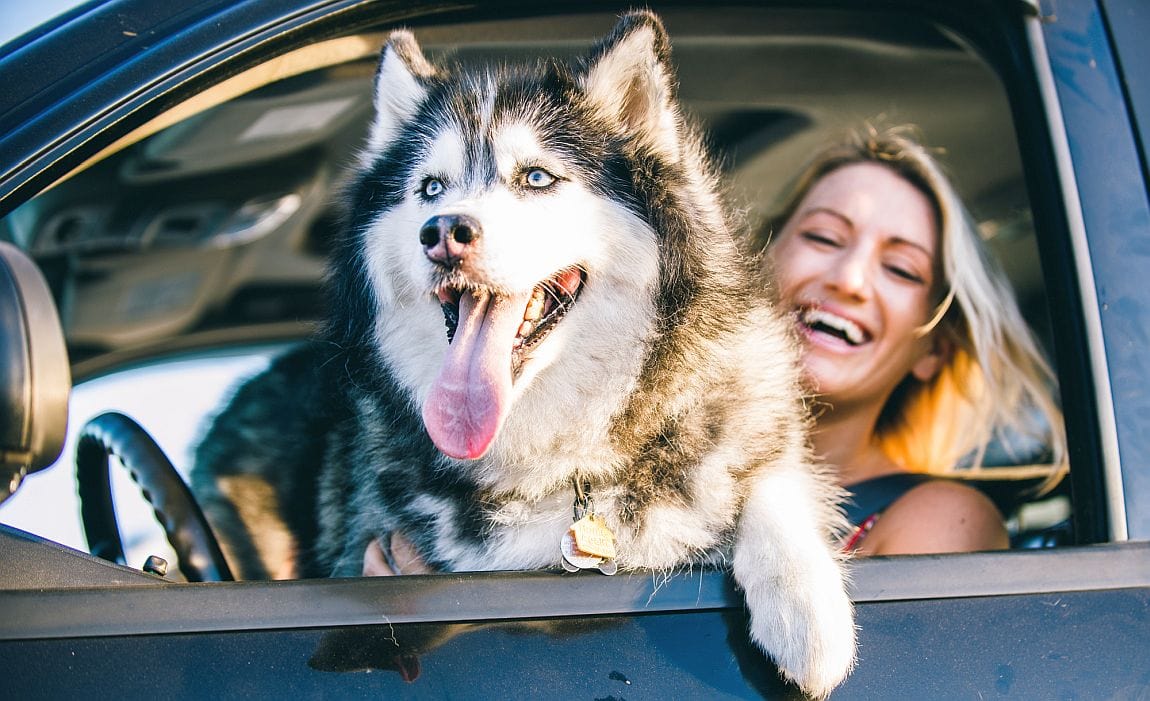
Whether you’re going on a family road trip or a visit to the vet, traveling in a car is an unavoidable part of every pup’s life. But no matter the reason, you’ll need to keep safety in mind and make sure that your canine rides comfortably.
While this is fairly easy to achieve for small pups, gentle giants… are a whole other story.
There are tons of challenges involved when traveling with a large dog, starting from getting over 50 pounds of fluff safely through the car door!
But don’t worry. We’ll help you do so below by sharing nine tips for managing a large dog in the car . We’ll then cover some general travel tips that will benefit any woofer.
How to Travel with a Large Dog in the Car: Key Takeaways
- Lots of owners enjoy taking their big dogs for car rides . But it’s important that you employ a few tips, tricks, and strategies to ensure everyone’s comfort and safety .
- Among other things, you’ll want to make sure your dog has a safe place to ride and that you monitor the car temperatures . You’ll also want to do things like bring plenty of water.
- There are also some general travel tips it makes good sense to embrace when riding with your do g. This includes things like providing your pup with plenty of pee breaks and getting him some exercise beforehand .
9 Tips for Managing a Large Dog in the Car
From investing in seat protectors to finding a comfortable restraint system, there are plenty of things to take into consideration when traveling with a gentle giant.
1. Consider Whether Your Car is Appropriate for a Big Dog or Not
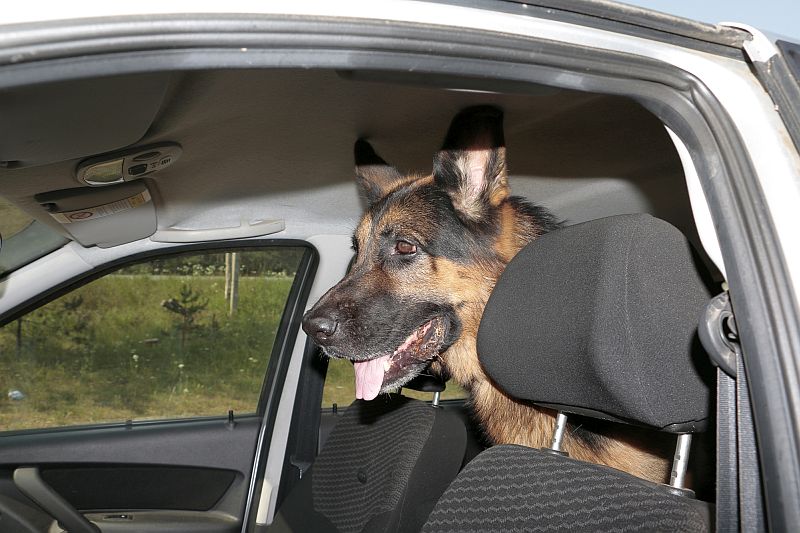
Before your pooch even steps into the car, you’ll want to make sure your vehicle can comfortably accommodate his size .
As a rule of thumb, you’ll want to make sure your dog can sit up, lie down, and turn around completely without having his movements hindered.
If he can’t do all of those things in the car, you’ll have to find an alternative means of travel.
You’ll also want to check whether he can easily get in and out of the car. Some big dogs, especially those with short legs like basset hounds, have a hard time jumping up and may require low floorboards and a ramp.
The entrance also shouldn’t be a tight squeeze – those with compact, two-door cars may find themselves faced with some challenges. Hatchbacks are ideal, as they typically provide a wide rear entry point.
The best cars for dogs are fitted with ample storage space, foldable seats, rear air vents, and childproof locks . You’ll also want upholstery material that’s easy to clean and doesn’t retain doggy odors.
2. Decide Where Your Dog Will Ride
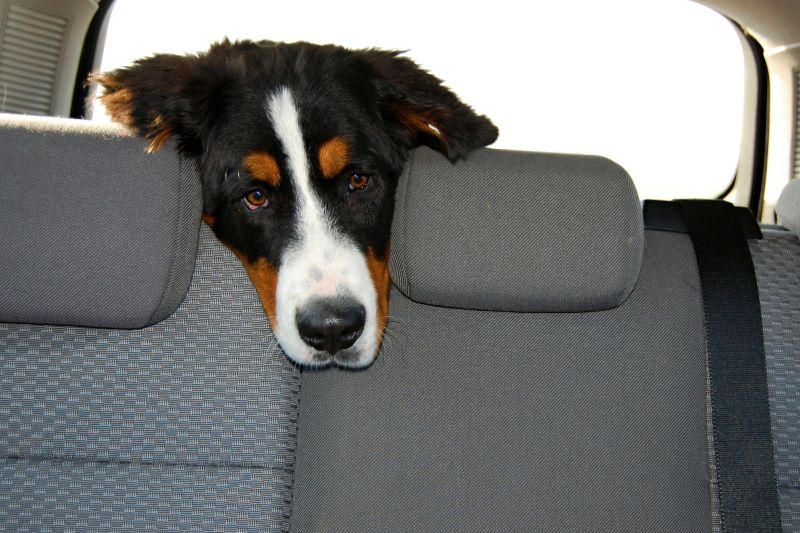
The rear seats and cargo area are the best places for a big dog to ride . Don’t let him sit with you at the front of the car, no matter how adorable he looks (resist those puppy eyes!).
It’ll almost certainly be too small of an area for him to sit comfortably, and he’ll also serve as a distraction while you drive.
The rear seats and cargo area both have pros and cons, so you’ll want to consider your decision carefully. We’ll try to help you decide below:
Pros and Cons of Dogs Riding in the Back Seat
- Your pooch can see you easily; ideal for big dogs with anxiety .
- The visibility also means you can keep track of your pooch. So, you’ll know straight away if he gets sick, agitated, or needs to relieve himself.
- Can easily use safety measures such as harnesses and seat belts.
- Lets your dog easily look out the window while driving. This may help prevent car sickness .
- Usually less space than the cargo area.
- Smaller entry point.
- Uneven surface area. Your dog may feel unsteady on his feet.
Pros and Cons of Dogs Riding in the Cargo Area
- Spacious; ideal for dogs that love to stretch out or move about.
- Since the cargo provides a flat, even surface, your pooch can also feel secure and easily keep his balance.
- Larger entry point.
- Can easily adjust the area to your dog’s liking. Add blankets, his bed, favorite toys, and anything else that will help him travel in ease.
- Tends to be the stuffiest part of the car, unless it’s a climate controlled cargo.
- Can’t see your dog easily.
- Not a safe option in SUVs and cars with a rear crumple zone.
3. Choose a Safe and Comfortable Restraint System
Nothing beats road tripping with your best friend, but it’s vital that you don’t get caught up in all the excitement.
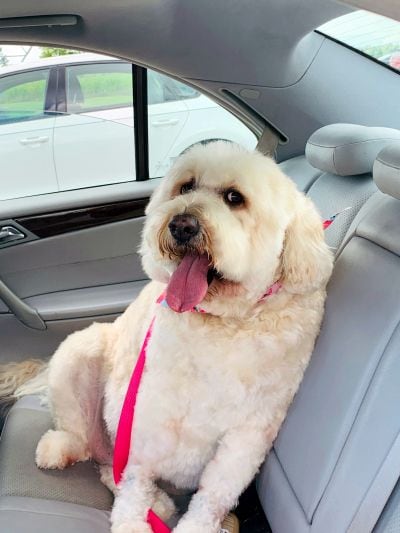
Just like humans, dogs need to have a restraint system that keeps them comfortable and safe .
Left unsecured, your pooch could lunge forward, attempt to climb on your lap, or hit the controls – all behaviors that can cause serious injuries for both him and your passengers.
And if the car crashes, it can have serious — possibly fatal — results .
According to Pet Pro Supply Co , if a car crashes at just 25 miles per hour, an unrestrained dog can be projected at a force around 40 times his weight.
So, now imagine the impact force of a large dog — it will no doubt be a deadly blow.
There are several safety restraint systems you can use, each unique and tailored to different needs. The three best options are:
- Dog Car Harnesses : Dog car harnesses attach to the car and keep your dog securely in place. It typically fits around the chest and upper body, and can be adjusted to suit your dog’s size. This is often considered the safest option as it helps spread the force of impact. However, harnesses offer less freedom of movement than other measures. Only buy a harness that has been crash tested (and has passed) by a third-party group.
- Dog Car Crates : Crates that are specifically designed to absorb shock and keep your pup secure, these are good options for dogs who experience neck or back problems (a harness can exert sudden pressure in an accident). Just make sure you pick a crate large enough for your big pooch !
- Dog Seat Belts : Essentially a seatbelt that clips into a car buckle, but designed for a dog’s size and body shape, dog car seat belts allow for more freedom of movement than a standard harness, making it a suitable option for dogs who can’t settle down easily.
Whichever option you pick, always make sure the system is secure, durable, and properly installed . If these aren’t feasible due to the layout of your car or where your woofer is sitting, you can instead consider a car barrier or tethering your doggo to hooks in the back with a leash.
These measures will both keep your dog out of the way and also prevent him from flying forward in an accident.
4. Consider a Ramp or Stairs
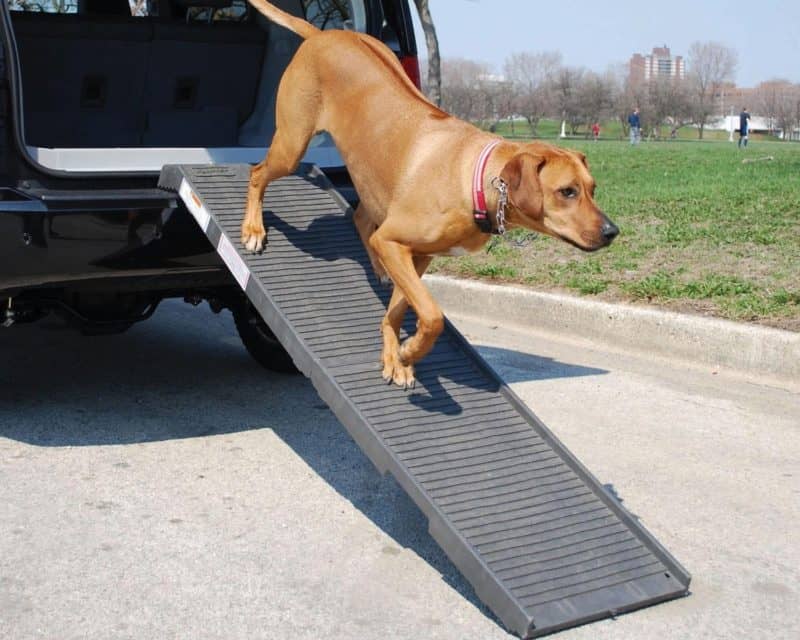
A car ramp makes the process of getting your pooch in and out of the car a whole lot more convenient and safer . It’s also easier on your dog’s joints; repeatedly jumping can cause unnecessary strain and lead to potential injuries.
There are plenty of dog car ramps and stairs on the market , but you can also make a DIY dog ramp if you prefer.
You’ll want to make sure that whichever one you get is durable, portable (can be folded up and stored easily), and can accommodate your dog’s weight. The material should also be slip-resistant.
In many cases, you can choose a ramp or stairs — whichever one you think will work best. However, senior dogs and pooches with joint problems will usually prefer a ramp to stairs .
5. Consider Warning Signs
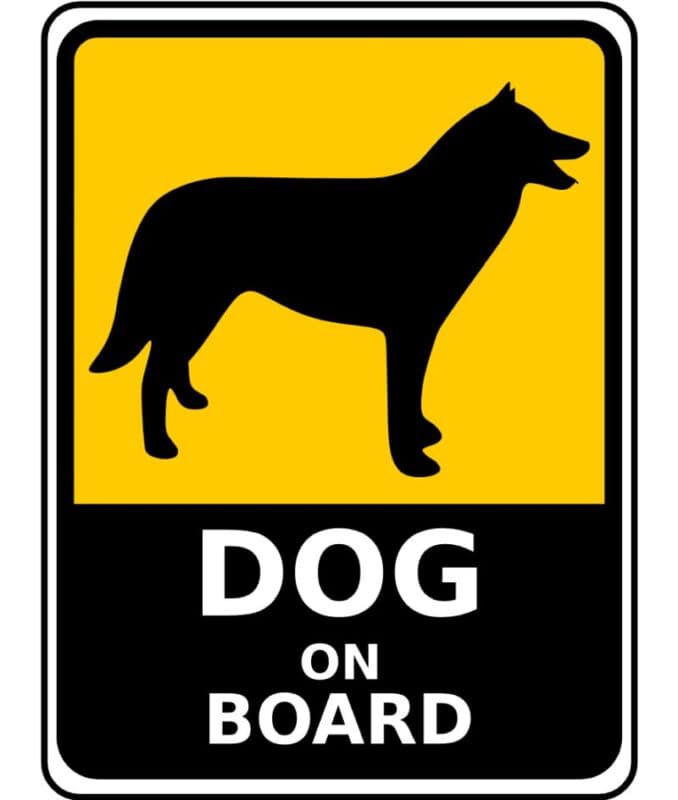
Some people, especially small kids, are frightened by large dogs. So, while it’s not strictly necessary, it’s a good idea to add a “warning sign” sticker informing those around you that there’s an oversized pup on board.
This will be especially useful if your pooch has a bad habit of jumping out immediately as soon as the car door opens; the sudden movement can startle and distress people who are afraid of dogs.
6. Be Careful When Exiting the Car
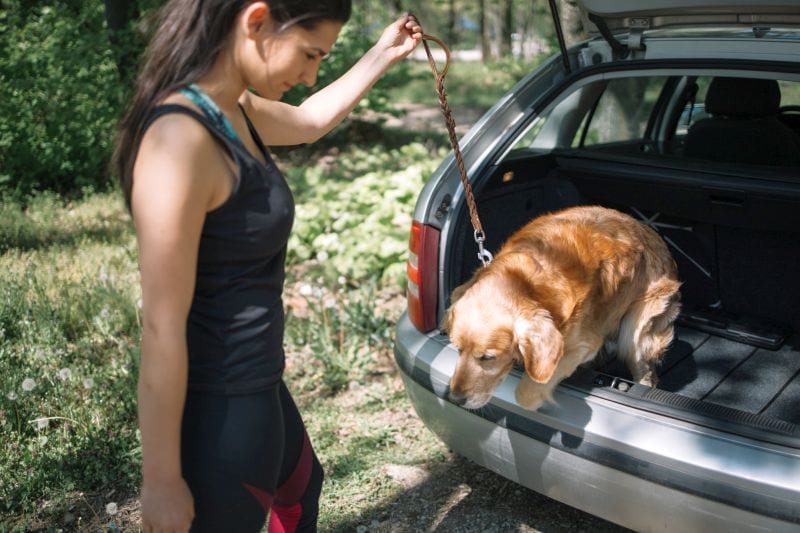
As we mentioned above, some dogs can’t resist jumping out and embracing the world once the car door opens. While this can look incredibly cute, it does come with risks and should be prevented . Your dog could injure himself, accidentally frighten or bump into someone, or even run off.
You’ll need to be careful and ensure you maintain a tight hold of your pup when exiting the car. Your restraint system can also affect how exactly you approach it. For example, if your dog is in a harness, you’ll need to first attach the leash, place down the ramp, and then unbuckle him.
It may also help to play some impulse-control games with your dog , so that it’s easier to get him to wait until you’re ready before he jumps out.
7. Consider Seat Protectors
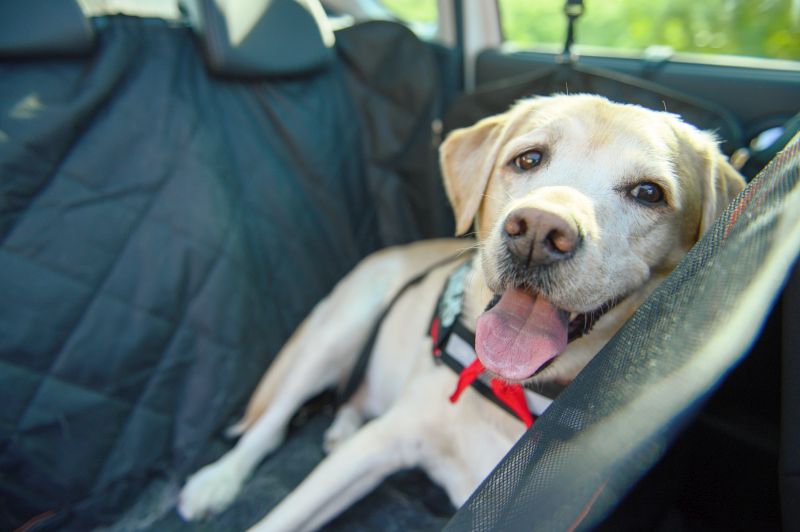
It’s an understatement that dogs are messy. And when it comes to canines, the bigger the size, the bigger the mess! They shed, drool, chew, scratch, and spread mud and debris everywhere. All these things aren’t exactly… ideal for your car.
If you don’t want your seats to be left looking like a battlezone, you’ll need to invest in some high-quality seat protectors . The best kinds are easy to clean, waterproof, don’t retain odors, and come with adjustable straps.
8. Consider Grabbing a Dog Gear Bag
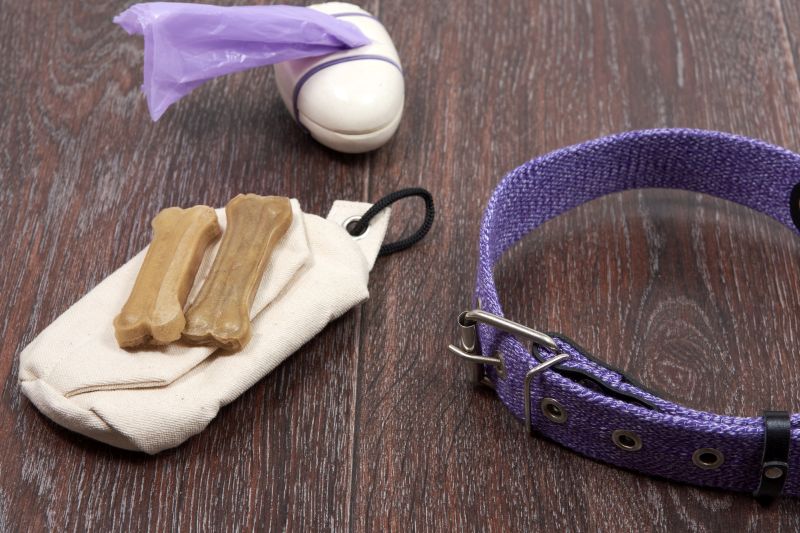
While you can get away with not having a dog gear bag for a small pup, a big dog is a whole different matter. The travel supplies large dogs need are a lot bigger, bulkier, and take up more space, so a bag is a really good idea .
A dedicated, size-appropriate gear bag or backpack will be immensely useful , especially if you’re going on journeys with your gentle giant.
9. Scope Out the Location Beforehand
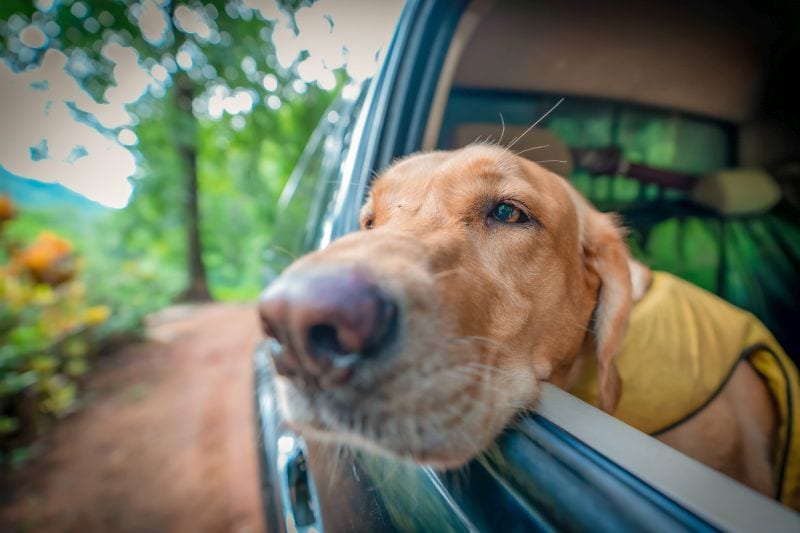
While it’s fun to take your woofer on day trips to new and exciting places, it’s always wise to scope out the area beforehand .
Some places may have narrow pathways which can be difficult for a big breed to navigate, while others may have actual size limits enforced (e.g. a park for small breeds). If your dog is reactive to people or certain objects, you’ll also want to make sure you know which paths best avoid these triggers.
Can’t scope out a location in person? You can instead look for photos of the place, check out its website, and hop into Google Earth. You can also speak to friends or colleagues who have been to the area.
General Car Travel Tips for Any Dog
While these car travel tips aren’t specific to large dogs, they’re still important to keep in mind.
Provide Plenty of Potty Breaks
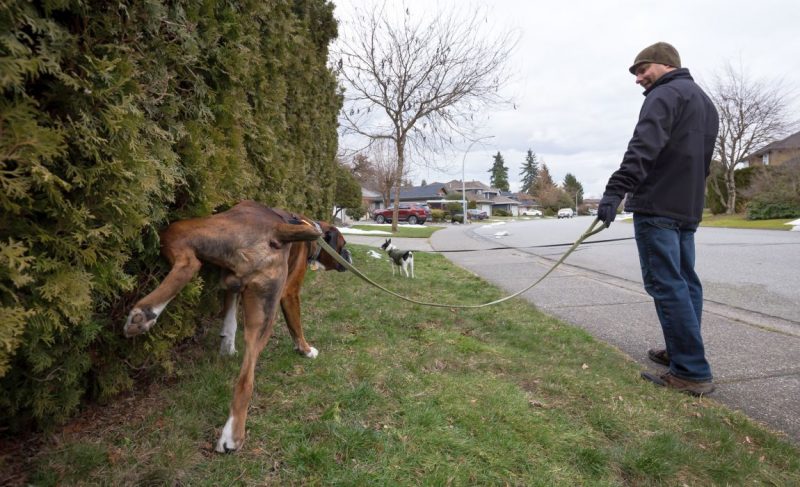
You should always let your dog relieve himself before a car trip, and if the journey is going to be long, make sure to stop for plenty of potty breaks . This will help your pooch feel more at ease while minimizing the chances of an accident occurring.
The breaks will also give him time to stretch out and enjoy the fresh air .
Feed Your Dog Several Hours Before Driving
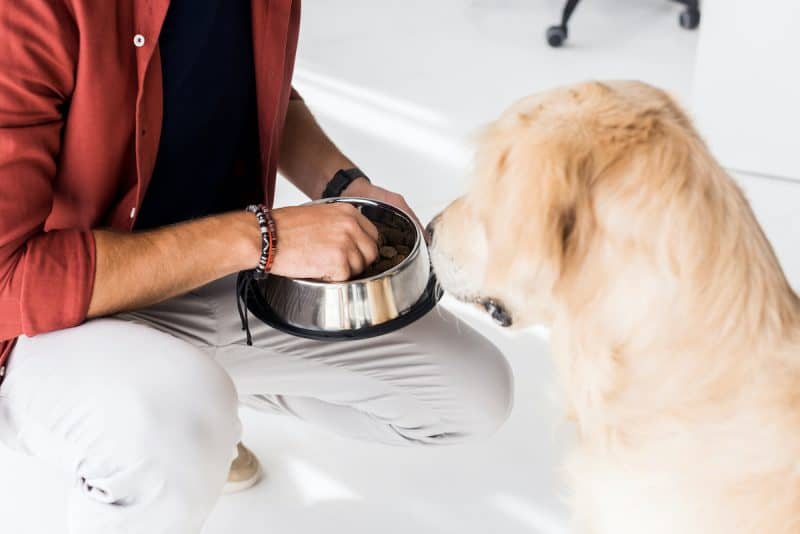
Always try to feed your dog several hours before heading out .
This is particularly important if your woofer gets car sick! If you feed him just before driving, motion sickness can cause him to throw it all back up. It won’t be pleasant for him, nor you, or your car.
As a rough guideline, hold off feeding your dog for at least three hours before a road trip.
Pack Lots of Treats, Toys, and Distractions

A long car journey can be a stressful experience for many dogs. You can help your pup feel at ease, and distract him from the journey itself, with treats, toys, interactive puzzles, and blankets covered in comforting scents .
With that said, if your dog suffers from motion sickness, it’s important to not give him too many treats in the car. You can break down a couple of treats into smaller pieces, and feed the pieces to him occasionally throughout the journey.
And as always, you’ll also want to make sure that any toys you provide him can withstand your dog’s teeth and paws .
Make a Checklist of Everything You’ll Need Before Leaving
It’s important to bring along everything you and your dog will need during your adventure . There is nothing worse than arriving at your destination, only to find out that you forgot your dog’s leash or water bowl.

At best, you’ll have to fork out some cash at a local store to buy these items again.
At worst, you’ll have to drive back home and collect them.
It can also be incredibly dangerous if you forget to pack enough water for your pooch.
Making a checklist of everything you’ll need ensures none of the above ever happens.
Among other things, you’ll want to bring all of the basic road trip supplies such as toys, leashes, poop bags, bowls, water, food, and harnesses .
You may also want to bring anything that’ll help keep you comfy during your outing . This may include things like a raincoat or umbrella, a change of footwear, and snacks (you deserve treats too!).
Monitor the Temperature
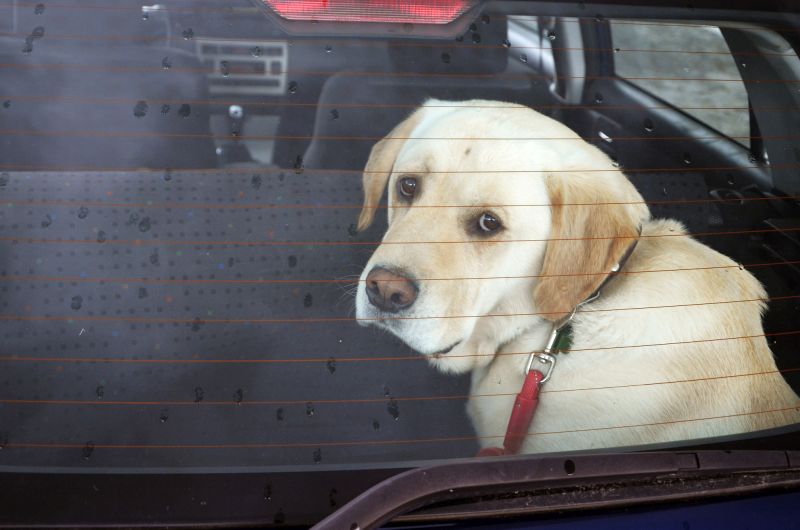
A hot car can be incredibly dangerous for your gentle giant.
Dogs have very few sweat glands and are less efficient at cooling themselves down than humans. Brachycephalic breeds and dogs with dense coats are particularly prone to overheating.
You’ll need to take every measure to keep the car as cool and comfy. You’ll also need to monitor the temperature, and immediately seek a vet if you see any signs of heat exhaustion in your pup .
We feel this goes without saying, but never leave your dog alone in a car on a warm day , even if the windows are open. It can become as hot as an oven and your pup will have no way to cool himself down.
Check out our review of the Waggle RV & Car Pet Temperature Monitor !
Bring Plenty of Food and Water
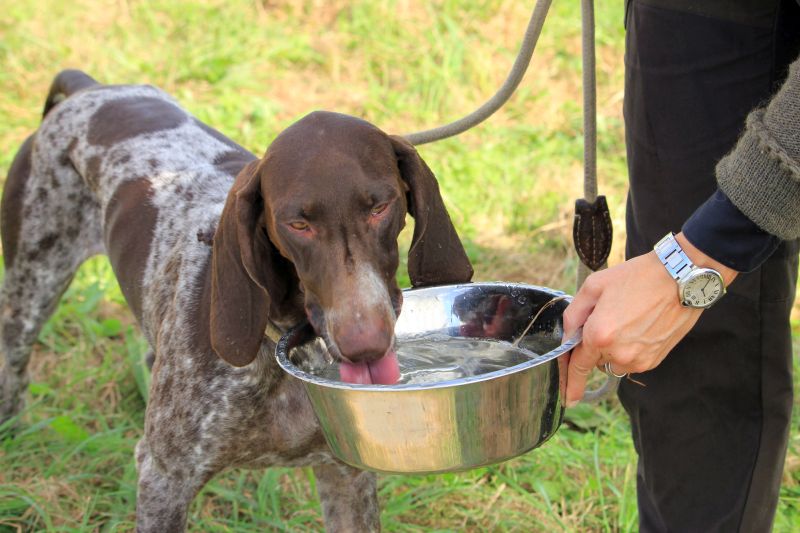
We can’t stress this enough: You need to be fully prepared and bring plenty of food and clean water for the journey. You should also store water in a shaded, cool area so it doesn’t warm up from the sun.
Wear Your Woofer Out Beforehand
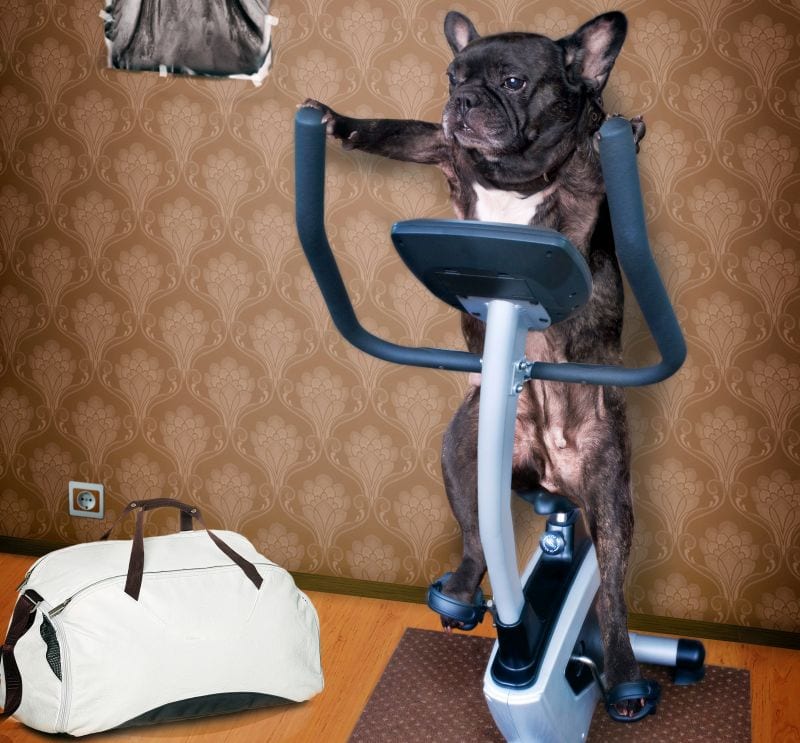
A dog brimming with energy is going to find it hard to settle down on a long road trip. That’s why it’s important to wear your woofer out beforehand ; take him for a long walk and give him plenty of mentally-stimulating games to play with, like food puzzles.
Getting overwhelmed planning a road trip with Rover? You can always consider flying with your four-footer. Check out some of the most pet-friendly airlines to see if they’re heading where you are!
Traveling with a large dog can seem like an impossible feat, especially when your woofer isn’t exactly a quiet, patient passenger! But if you follow our tips above, while prioritizing your pup’s safety and comfort, the road trip is sure to be a happy experience for both humans and pooch.
Have you ever taken a road trip with your gentle giant? Was it a fun experience? Do you have any more travel tips to share? Let us know in the comments down below!
Like it? Share it!
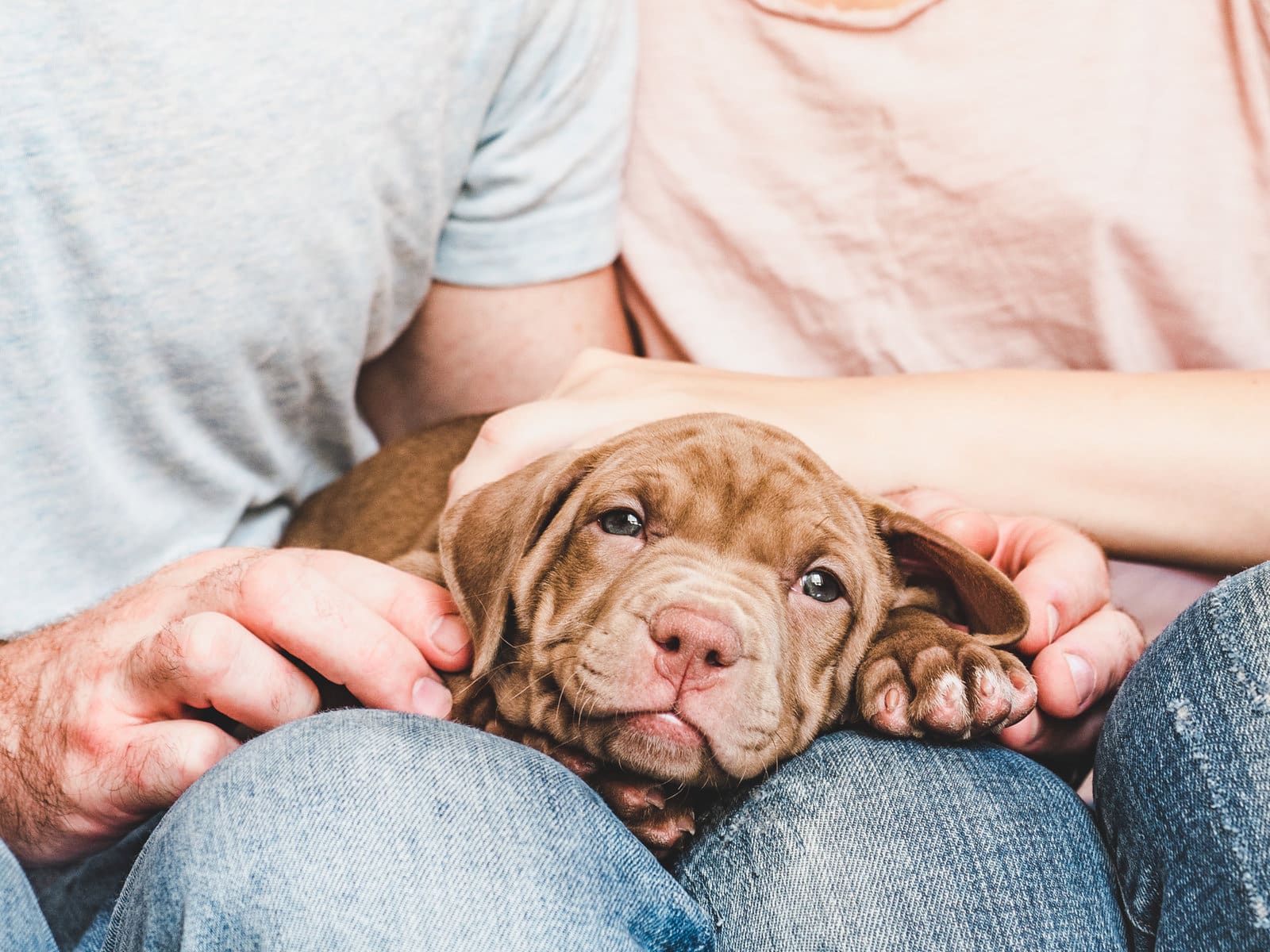
Recommended For You
Puppy Blues: 17 Tips for Dealing with the Puppy Blues
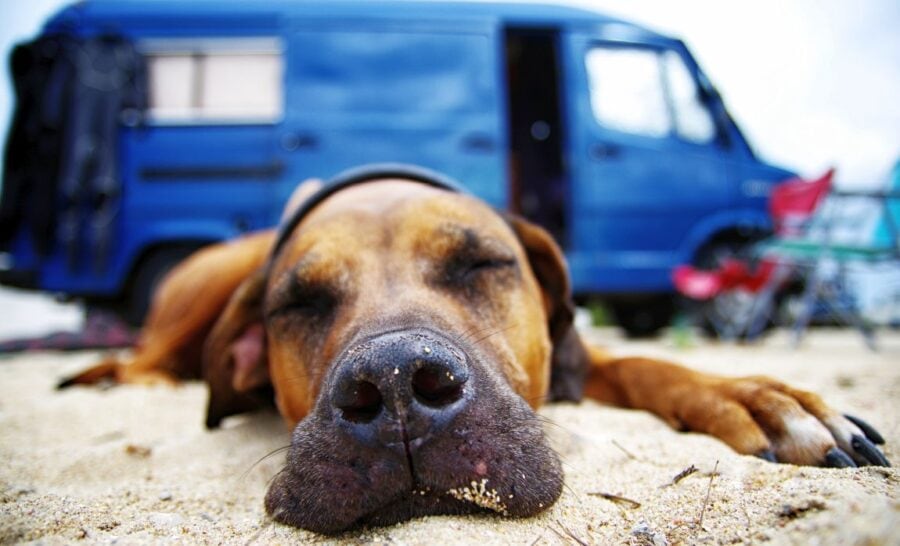
Van-Life with Dogs: 31 Tips for Success on the Road!
Join our pup pack!
Get tons of great dog training tutorials, canine gear guides, and the latest doggy discounts.

No comments
Leave a comment cancel reply.
Save my name, email, and website in this browser for the next time I comment.
This site uses Akismet to reduce spam. Learn how your comment data is processed .
Also Worth Your Time

Best Cities for Dogs: Where to Move With Fido
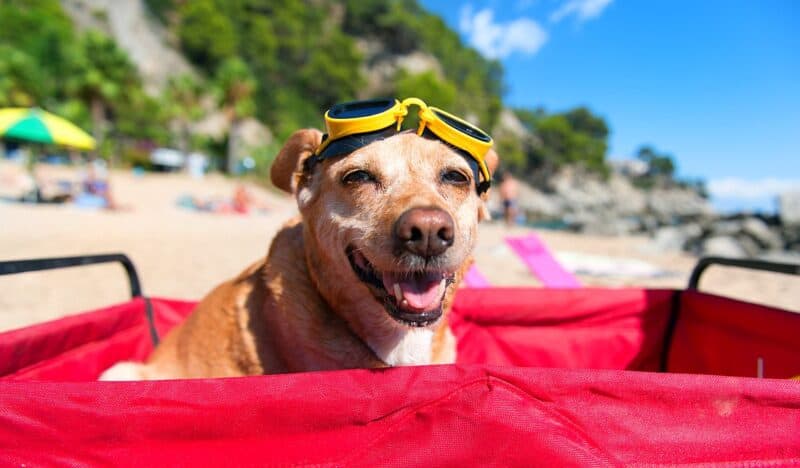
Dog Care Pet Travel
Best Dog-Friendly Vacation Destinations: 37 Pawesome Places

13 of the Most Pet-Friendly Airlines: Stress-Free Flying with Your Dog!
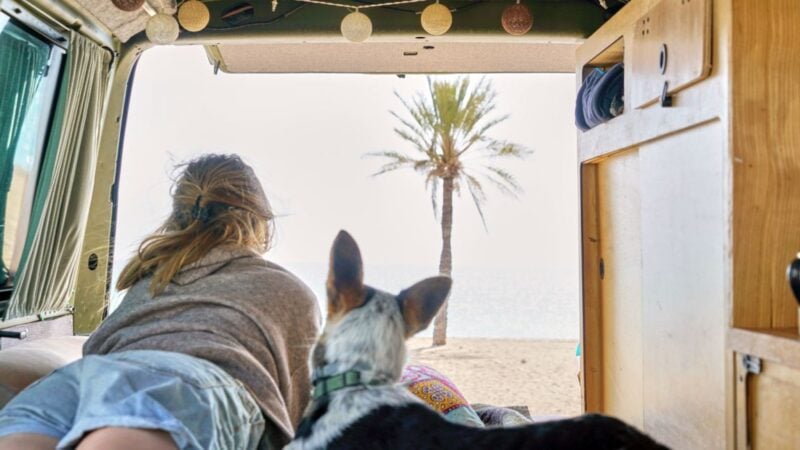
The 11 Best Dog Breeds for Van Life (and Some of the Worst)
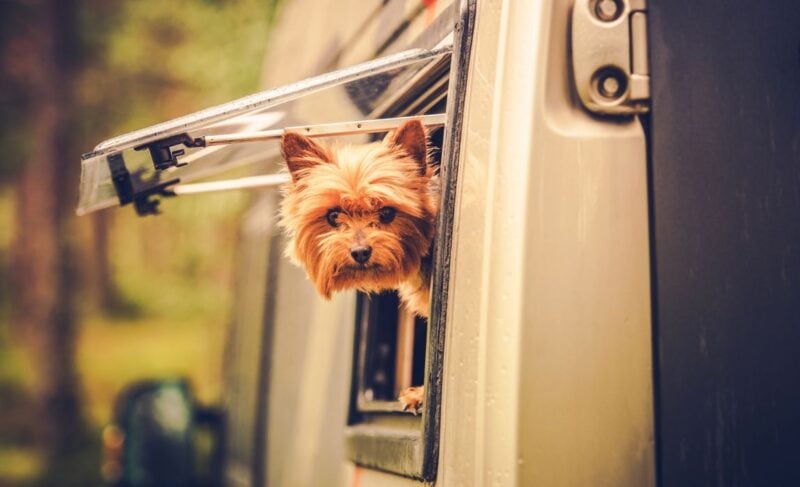
8 Tips for RV Traveling With Dogs
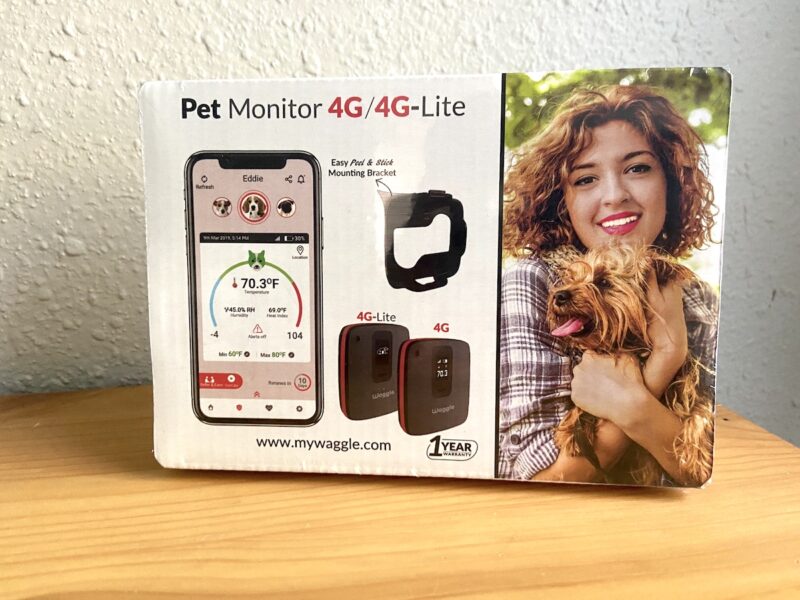
Waggle RV & Car Temperature Monitor for Pets: Our Hands-On Review
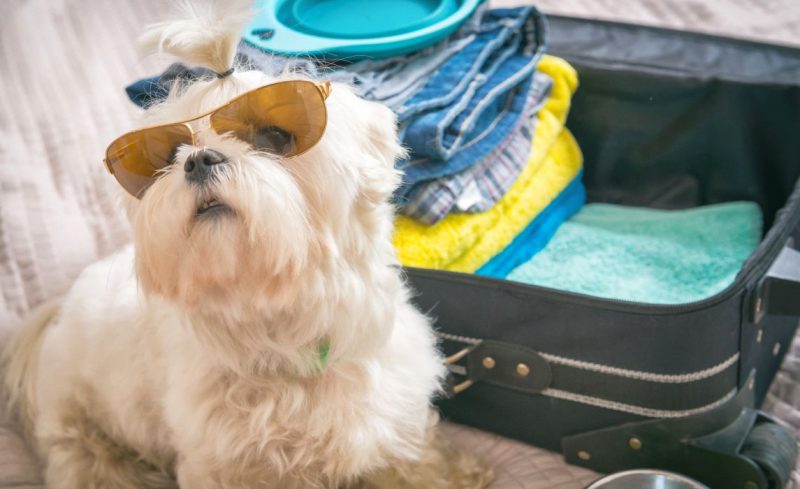
The 17 Best Dog-Friendly Hotel Chains

+1 (512) 720-6136
[email protected]
Marrsipan Media LLC 5900 Balcones Drive #17677 Austin, TX 78731, USA
© Copyright 2024 by K9 Of Mine / Marrsipan Media LLC
USEFUL LINKS
About K9 of Mine
Privacy Policy
Terms of Use
K9ofMine.com is a participant in the Amazon Services LLC Associates Program, an affiliate advertising program designed to provide a means for sites to earn advertising fees by advertising and linking to Amazon.com. Additionally, K9ofMine.com participates in various other affiliate programs, and we sometimes get a commission through purchases made through our links.
K9ofMine.com does not intend to provide veterinary advice. While we provide information resourced and canine education, the content here is not a substitute for veterinary guidance.
Traveling With Dogs In The Car Safely
When you purchase through links on our site, we may earn a commission. Here’s how it works .
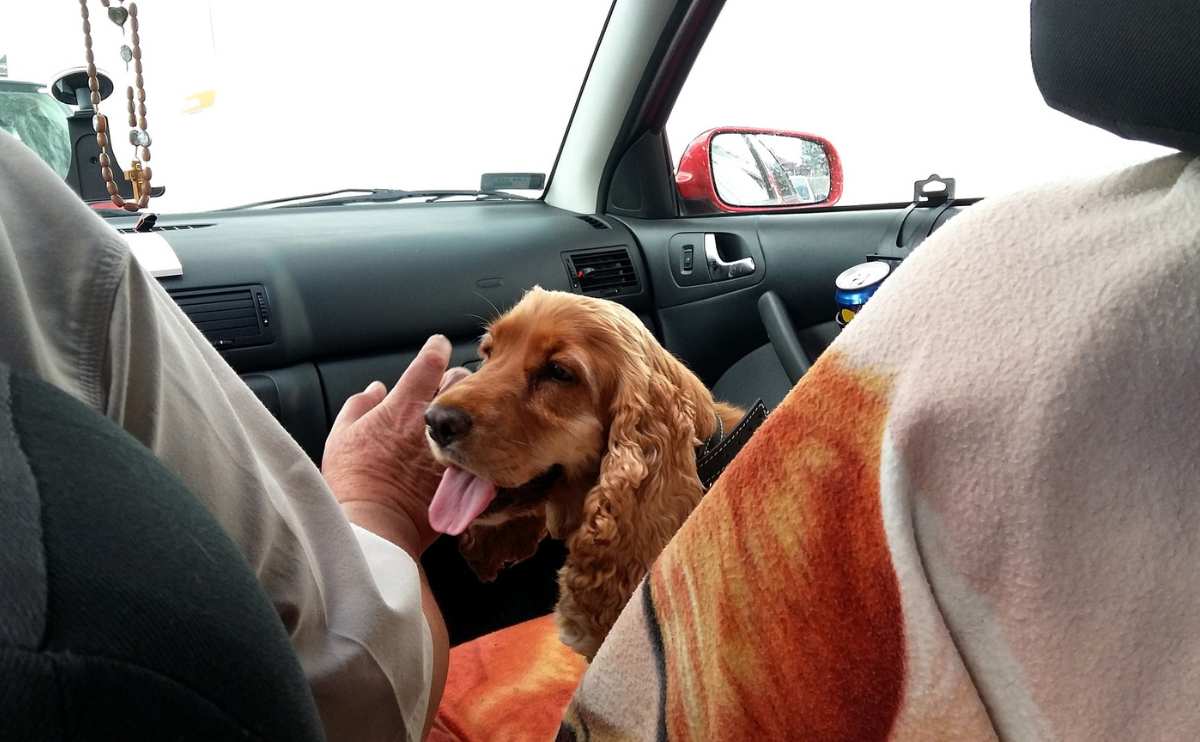
Road trips can be a lot of fun, and staying safe while traveling in your car is a priority. We all think about wearing our seatbelts and following the rules of the road. But how often do you think about how to keep your dog safe in the car? Focusing on traveling safely with your pup in the car will help you all have a better time and enjoy your trip.
Traveling With Dogs Safely
While it may be fun to have your pup riding shotgun while you cruise down the highway, it isn’t the safest choice for you or him. You may want to consider easing your dog into a car trip and securing your dog in a safe place in the car. Below are our recommendations on how to travel safely with your dog in your car.
Never Leave Your Dog Unattended In Your Car
It’s unsafe to leave your dog in the car alone, especially in the summer , when he could easily overheat in a matter of minutes in a car. Even slightly cracking your car windows isn’t safe.
Start Small

Small trips can give you a feel for how your pup does in the car. It can also help you figure out if your dog is dealing with car sickness or anxiety before you work up to a longer trip.
Your Dog Is Safer When Restrained
Along with dangers if a crash should occur, your dog runs the risk of putting his head out an open window. He could even lower the window on his own or move into a seat near an airbag, which can be very dangerous in an accident.
Legal Issues
It’s the law or a potential law to buckle up animals in cars in a growing number of states. More states are regulating the transportation of dogs in cars for the safety of both dogs and humans.
Fewer Driver Distractions
A restrained dog will reduce driver distractions. If you’ve ever had a dog suddenly hop into the front seat, into your lap, or even down near the gas or brake pedal, you know the risk of distracted driving. A Kurgo /AAA survey showed that 29% of drivers admitted to being distracted by their dog . 1
Dog Restraints Protect Human Passengers
Kurgo reports that an unrestrained 10-pound dog in a crash at only 30 mph will exert roughly 300 pounds of pressure. In comparison, an unrestrained 80-pound dog in a crash at only 30 mph will exert approximately 2,400 pounds of force. Imagine the pressure exerted at freeway speeds! 1
You Can Unload Secured Dogs From The Car More Safely
On arrival, you can safely put the leash on your dog before unbuckling and removing him from the car. Regardless of prior training, an unsecured dog can become excited on arrival and quickly bolt when the door is opened.
Secured Dogs Are Safer For Emergency Responders
If you should get into an accident and need the help of emergency workers, having a secure dog in the car allows emergency personnel to enter the vehicle quickly without concern of an unsafe situation.
Traveling With A Puppy In A Car
Traveling with a puppy can be stressful for you and him. Try not to start with a long trip. Get your pup acquainted with your car and test things out. You don’t want to learn that your little guy gets carsick, anxious, or that your plan to secure him isn’t working out when you’re in the car for hours.
How To Secure Your Dog In The Car
Whether you’re planning a dream vacation or just an afternoon of errands, a few moments spent securing your canine can be a lifesaver in the event of an accident. Securing your dog in the car will depend on several factors, including your dog’s size and the layout of your vehicle . Here are some options for you to consider:
Dog Car Booster Seat
A booster seat is a semi-enclosed kennel seat , some of which include a seat belt. Our top pick is the Flow.month booster seat , which can keep your pup cozy and safe.
Dog Carrier or Crate
Small dogs (as well as cats) are also often transported in carriers. You can secure the carrier so they can’t become projectiles if a sudden stop occurs. For larger dogs, secured dog crates provide a safe option .
Dog Car Harness
A dog car harness that buckles into a seat belt or clips to cargo tie-down is an option that works for most dogs and vehicles . A car harness for dogs can create a safer, more comfortable ride for your pup. When it comes to picking a dog harness, we recommend the PetSafe Deluxe Harness . This harness works with any seatbelt and can also be used to walk your dog.
Dog Barrier Or Seat Cover
If you have an SUV and a large dog, a dog barrier could be a good solution. There are also dog seat covers that create a hammock for your dog.
What Do I Need To Travel With My Dog?
When you’re thinking about how to travel with a dog, remember that traveling with dogs isn’t only about keeping them secure. It’s also about making each trip safe, healthy, and comfortable. Here are a few tips to make your trip a success:
Need A Dog Ramp?
Do you have trouble getting your pup in and out of the car? A dog ramp can be an excellent addition to your travel experience to provide a convenient and safe way for your pup to get in and out of the car without injuring themselves or their owners.
Keep Your Pup Hydrated
Bringing a dog water bottle is a travel-friendly alternative to a water bowl and can help you hydrate your pup on a trip without a lot of mess.
Take Breaks
It’s so important for you to take a break from driving for your pup to potty and get a bit of exercise. These stops will prevent accidents and keep your pup from getting bored in the car.
Identification
If your dog gets away while you’re out of town, you want to make sure he can get back to you. Make sure your pup has an ID tag or a microchip so people can easily identify him if gets lost.
Snacks And Treats
Don’t forget to bring some treats for your pup to snack on in the car. He may get hungry, especially if your travel disrupts his regular eating routine.
Dog toys can be a lifesaver on a long trip to prevent boredom and entertain your dog.
Keep Your Dog Clean
Adventure can be messy. Keeping a paw cleaner or dog wipes in the car can help you clean up your pup before he gets in the car.
Adventure Awaits
This seven-minute video from Mojo Travels gives you some great ideas on the best places in North America to take your pup. You’re sure to be inspired for your next road trip.
Be Prepared However You Choose To Travel
Making sure you know how to travel in a car with a dog is essential. But if you love to travel and you want to bring your pup along, you’ll want to know how to prepare for all types of travel no matter what your destination.
Sources: [1] Kurgo
The information provided through this website should not be used to diagnose or treat a health problem or disease; it is not intended to offer any legal opinion or advice or a substitute for professional safety advice or professional care. Please consult your health care provider, attorney, or product manual for professional advice. Products and services reviewed are provided by third parties; we are not responsible in any way for them, nor do we guarantee their functionality, utility, safety, or reliability. Our content is for educational purposes only.
About The Author

Sadie Cornelius, Creative & Content Marketing
Related posts.
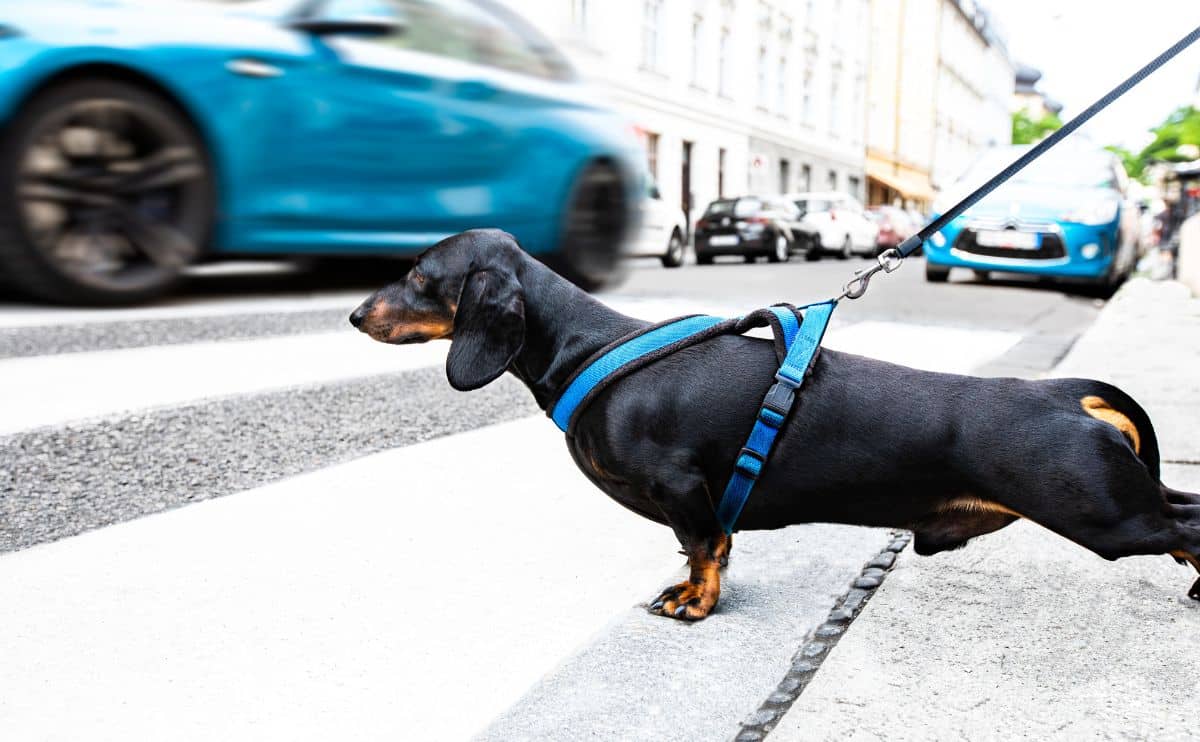
Does Car Insurance Cover Injured Pets Or Hitting A Dog?
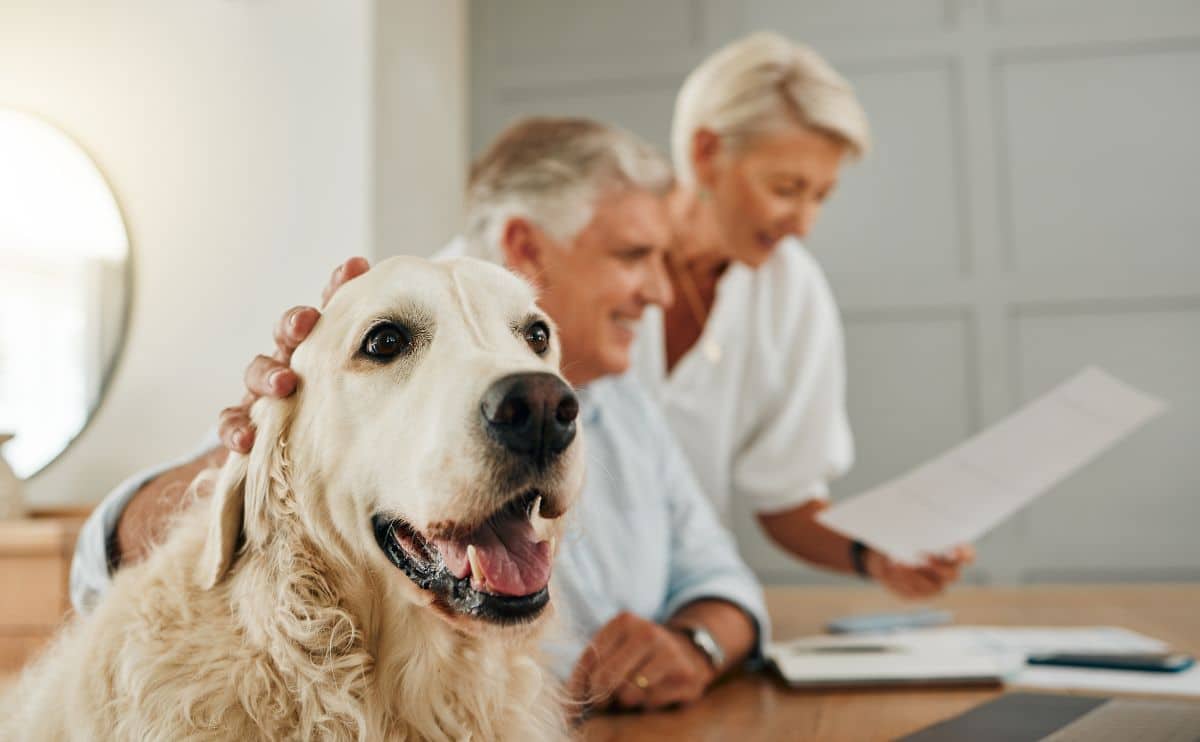
Pet Sitting Contract: Why It’s So Important, Where To Find One & What To Include

How Much Does It Cost To Fly A Dog?

Traveling Cross Country with a Dog: Great Travel Hacks + Guide
Disclosure: This article contains affiliate links and is a member of Amazon Services LLC Associates Program, meaning when you make a purchase, I earn a small commission. Affiliate links cost you nothing to use, and help keep my content free. It’s a win-win for us both! For more info, see the Privacy Policy
I can totally guess your favorite dog breeds based on how you travel
Take this quiz to see which breeds match your style!
Have you been wondering about the best ways to take a cross country road trip with your dog?
We have driven over 100,000 miles on the road with our dogs. We have crossed borders, traveled top to bottom, and coast to coast within the United States. Our dogs have been along (lucky us!) for the journey. We have also done this in a car that only has space for us, our dogs, and the stuff we need for the trip. It doesn’t have to be anything fancy for you to have a great trip, but there are a few things that make a huge difference!
Road trips and cross country traveling can take many forms and last from days to months, depending on how you are traveling. I can’t cover it all, but I can at least cover the essentials. Since most people will be driving and using the vehicle that they already have, that will be what we will assume here. (Though I do have a very strong vehicle recommendation if you are exploring options – see the section for tips on vehicles ).
This guide weaves together our own experience as well as some of the professional recommendations that the AKC and the Center for Pet Safety provide for traveling with dogs. It is a huge topic, but I really wanted to focus on the things that are in your control and can make a difference between a chaotic trip and a smooth one.
My goal is for this to be useful whether this is your first cross country tip, or you just want some tips and tools to make your next trip go better than the last. Even for veterans there are some tools (see our packing list and food calculator ) that can help plan your cross country trip.
I hope this helps you on towards a great cross country road trip with your dog!

First, if in the back of your mind you are wondering “is it really so complicated you have to write a whole article?” then you are in the right place. As you will see, the actual “how to” is pretty straightforward. However, it is a lot of distance to cover, a lot of things can happen, so I want you to make the best of this trip. If you are like me, you want to know how to do this safely, comfortably, and efficiently.
A quick guide for a cross country road trip with a dog
For the basic parts of a road trip it helps to look at the simplest scenario: a solo cross country road trip where you are just trying to get coast to coast as quickly and as safely possible. Whether it is for fun or for necessity (like moving to a new place or an unexpected life event), a cross country road trip requires both you and precious pup to drive…and drive…and drive all the way across the map.
To achieve this you:
1) Plan your route 2) Drive 3) Make pits stops for food, water, bathroom, car fuel 4) Find and stay in accommodations that allow pets
Road Trip Essentials
So now with the power of the internet and some common sense, here is a quick guide to traveling cross country with a dog:
Plan and Pack for Your Trip
- Use google maps or Wayze to plan your route
- Break the trip up into daily segments based on how long you can drive without getting tired (be conservative, this is a marathon not a sprint)
- Use the pet friendly filter on Expedia.com or Booking.com to find and book accommodations that allow dogs*
- Pack the basic dog necessities ( food , water, leash, poop bags, bedding, medicines)
- Pack your own travel necessities (clothes, toiletries, etc)
- Use a traveling harness or crate to keep your dog safe**
Hit the Road
- Load up the car, get your dog comfy and secure
- Drive (so much driving!)
- Take breaks to keep you and your dog hydrated, fed, alert, relaxed and comfortable. Truck/travel are great pit stops usually with shade and good amenities
- Use shade, climate control, Tesla “dog mode”, etc to keep your dog safe when you have to go inside without them (be very careful!)
- Check in to your accommodation. Sleep. Then begin again. * Accommodation is a huge topic all of its own but on trips where you spend one night in each place a hotel is usually your best bet for cost and convenience ** We will cover the benefits of safety restraints in more detail, but is also good to know that there are a growing number of states that by law require dogs to be restrained in your vehicle .
Yes. That’s it! Obviously, for your own trip this list might not be complete. If you are camping, or biking, or touring as a wandering minstrel and circus show … you’ll know best the special things and activities you require for your own adventure.
What should you pack for such a long trip?
If you have completed any kind of road trip with your dog already, I have good news! You probably have the essentials. If you want to double check that you have everything you need for a road trip, we put together a checklist for you. Our packing list is pretty comprehensive. Rather than exploding this post with long list, we put that at the end, and you can jump to that here if you want.
The checklist is also organized as a system, so the most frequent items are right at hand for you and your doggo, while the important but less used items are off out of the way.
Do’s and Don’ts for Traveling in a Car with a Dog
Before we get into our great Travel Hacks (I think they are great anyway), let’s touch on some dos and dont’s to be aware of. Our quick guide above obviously does not cover all of the “what ifs” and the ins and outs of traveling across the country. That would require a whole book, or several. As a start, here is a condensed list of important things to consider for the road ahead.
- Get Records from Your Vet : Ensure vaccinations and medications are up-to-date. Keep your records with you! You can’t plan for everything and there are many dog services (doggy daycare, grooming, etc) that require the records
- Consult a Mechanic : Is your car ready and are your tires in good health?
- Create a Safe Space : A divider, favorite blanket or dog bed can help your dog relax in the car
- Use a Safety Restraint : Our recommendation is a crash test-certified harnesses.
- Have FUN! : Get some great audio books, podcasts and playlists for yourself. Bring toys and chews for the doggo. Take breaks for walks, site seeing, play games!
- Book Longer Stays in Advance : Good pet-friendly Airbnb and Vacation Rentals go fast in popular destinations. Book a few months ahead to beat the crowds
- Get Real Time data with Navigation Apps: Wayze, google maps, etc
- Prepare for Weather : Layers to manage temperatures, umbrellas/raincoats for rain
- Pack a First Aid Kit : Like with the weather, best to be prepared
- Always have a Jug of Water: Stay hydrated, keep it full especially in summer.
- Use Belly Bands or Diapers for Seniors or Puppies: the change and stress of a trip can cause a dog to lose some of the control they normally have. Disposable diapers can help keep everything clean and keep things moving.
DON’T
- Don’t Drive Drowsy, Angry or Distracted : It is as dangerous as driving under the influence. Pull over, take a break. Recharge. Take a nap if you need to.
- Don’t Ignore Signs of Stress : Be aware of your dog’s comfort and health. Take a break and check your dog out if they are showing signs of distress.
- Don’t Get Nailed by Crazy Pet Fees or Policies : Read the fine print, call to confirm, look through all of the house rules and policy sections on Airbnb, Vrbo, etc. The pet fee amount on 3rd party booking sites is often missing or incorrect. You may need to check with the hotel directly.

Secure your dog with a Safety Harness or Crate
This final DO warrants its own section. Both the AKC and the Center for Pet Safety are very clear that the best thing you can do to keep your pet safe is to secure them in a crash tested safety restraint such as a harness or crate. Since you will be spending a lot of time driving, it is one of the best things to minimize movement and distraction for you and your dog.
This can be a challenging topic, but we have a great Travel Hack that has worked really well for us (see Travel Hack #1 ).
TIP : Here is a surprising fact that has been true for all of our dogs. Safety restraints help our dogs settle into “driving mode “. If you help them get used to the setup, it becomes a familiar and even calming routine for them. We have terriers, folks, so if a terrier can get on board, yours can too.
What we have found most surprising is that when they are NOT in their harness or crate, they are more agitated, stressed and active. So bottom line in our car: we wear seatbelts, they wear seatbelts or go in a crate …it is just a part of safe and smooth driving.
3 Great Travel Hacks for a Road Trip With a Dog
Next let’s move next into the heart of this guide, and what I hope you’re really here for: how to maximize comfort, ease and safety.
There is no way around it, you are looking down the road at some serious amounts of travel and driving time. It can be a fun adventure. It can also be frustrating, exhausting and challenging if we’re not ready for it. So now let’s focus on how to make this trip safe and comfortable for everyone involved. In our experience, there is a lot of advice out there, lots of to do lists, but out of all of that for us there are a short list of travel hacks that make driving with a dog a lot easier, more enjoyable and much safer. Here are our 3 travel hacks that have really made a difference for us and we hope will for you too.
Travel Hack #1: Our Favorite Crash Tested Restraint
Since crates can take up more room in the back of the car, our first big tip is to use a crash tested safety harness .

We found that SleepyPod Clickit harness is the best for freedom of movement and flexibility while also being secure. We are able to use it as a harness both in the car and for walks. Sam is fine wearing it for long hikes. So it is both comfortable and very solidly constructed. This harness has sizes that fit larger dogs, so even labs can wear it.

For smaller dogs like Denver, a harness will not protect them. We found that the Sleepypod Air is also great. It is comfortable and is built to be secured by the seatbelt. Because it is made to sit in the car seat, we can move Denver in and out of it easily.
We don’t have personal experience with crates that get tied down in the back of a car. However, for larger dogs or to free up your backseat for other passengers, you may need a crate. The Center for Pet Safety tested and approved Cabela ‘s, Gunner , Lucky Duck , and Rock Creek Crates

While none of these products are cheap, they are built with safety first. The reason why we like the safety harness is because it is one of the more affordable and flexible options.
There’s a great Facebook group for learning how to set up your crate in your vehicle.
Tip : Crates have different purposes and are not interchangeable. Wire house crates and plastic airline crates will not hold up to the impact of a crash
So to sum up here are some of the many reasons to use safety restraints. The biggest is to protect your most precious cargo. They deserve it!
- Safety : Protects your pup and passengers in case of an accident.
- Traffic Laws : Some states require safety restraints!
- Distraction Prevention : Keeps the dog from distracting the driver.
- Comfort : Ensures a more comfortable ride for your canine traveler.
- Stress Reduction : Lessens anxiety for both you and your pet.
- Emergency Preparedness : Easier to manage in unexpected situations.
- Vehicle Cleanliness : Keeps the dog hair, paw prints, etc in one consistent spot
Now do some dogs and their humans have a tough time with this equipment? YES , and yet dogs can learn to make it work. Traveling is a set of skills that almost every dog can master (more on this later).
Travel Hack #2: The Best Pit Stops for Traveling Solo with a Dog
The most efficient routes across the country are also major trucking routes. Gas stations that are built for truckers also make for great places to to take a break with your dog.
Recommended gas stations
TA Travel and Pilot are all over the United States Wawa and Sheetz are popular in many eastern states (and they have often superchargers) Buc-ees are great if you are down South
Our dogs may have seen Niagara Falls and the Golden Gate Bridge , but some of their favorite things have been grass patches at rest stops. I guess there’s a lot of “pee-mail”.
Dog-friendly retail stores are a lifesaver
There is a big problem when traveling solo, since travel stops serve food, you can’t take your dog inside . When the weather is extreme or when you are worried about the safety and security of your dog, retail stores are a great alternative!
Petco, Petsmart, Home Depot , Lowes , and TJ Maxx are just a few of the places that you can usually take your pet. They are large enough so that you can stretch your legs walking around. Home Depot and Lowes typically have big spacious bathrooms right near the entrance.
Note that many of these retailers have pet policies on a store by store basis, but we generally have not had any trouble just waltzing on in (thank you big box retailers!)
Tips for Leaving Your Dog in the Car (Travel Hack #3)
At some point, you will need to leave your dog unattended in the vehicle. It is almost unavoidable, especially if you are traveling solo. There are a few things people do that can really help when you need to leave your dog in the car to use the bathroom, grab something to eat, etc.
The method that works best for you will depend on the type of car you have.
- Remote Start : turn on climate controls while outside of the vehicle (newer cars)
- Physical Key : leave the fob in the car to keep it running, take the physical key out and lock it
- Tesla Dog Mode (This is a life saver. Never heard of it? Well, read on…)
- 3rd party vehicle cooling systems : these are especially popular with sprinter vans and RVs, but you can use them in a regular car too.
- Park in the shade: even on cool days, direct sun can make your car crazy hot
Please be very careful , even with automatic climate controls like Dog Mode, there are some risks to leaving your dog alone in the car especially in extreme heat.
Tips for what to look for in a vehicle
Most folks will just be using the vehicle that they have for their road trip. It is such a big ticket item and car rental prices can be stiff, so most of the time you just go with what you have. However, if you find yourself needing to rent a vehicle or actually are planning on getting a car that is great for traveling with a dog, then it is worth spending a little time on the topic. It is the MAIN piece of gear for your road trip.
Obviously we will only touch the surface here. Cars, trucks, vans all are such a huge topic that depend heavily on budget, style of travel and the size of your dogs. But I have been surprised at how little the “Top Vehicles for Dogs” articles focus on the things that are actually useful for traveling with a dog.
So here are our major features to pay attention to:
- Cargo Space : very important for dogs traveling in crates. You need generous space AND the seats need to lie completely flat
- Remote Start : most new cars will have this, helps keep your dog safe in a pinch
- Automatic Doors : easier to get in and out with your pup and all the stuff
- Configurable Space : seats that easily fold, seats that lie flat (for crates). Sometimes you need to have space for your dog(s), sometimes you need it for people.
- Easy to Clean : dog hair, muddy paws, you know the drill. Can the materials handle it?
What vehicle do we use? Tesla Model Y
EVs are still new enough it is worth spending a little time on why we chose a Tesla. What many people don’t realize is that the newer models of Tesla are Tesla are getting more affordable, and that they make amazing road trip vehicles, especially when traveling with a dog.
Great Road Trip Features (and one drawback) of a Tesla
Dog Mode: this is amazing! It allows you to set the climate of the car to stay the same while you are away. Your dogs can stay comfy in their car while you grab a bite to eat or pop into a store. Using the Tesla App you can monitor the car to make sure the climate is staying on.
Autopilot : driver assist technology that comes standard on all Tesla cars and is a huge help with driving, which you have to do for hours and hours and hours on end. Tesla’s Autopilot capability is much better than any other car maker out there
Safety Features: Tesla is also the safest vehicle on the road as independently tested by a bunch of different organizations. It has both active and passive safety features to protect you and your pups.
The main drawback – Charging . Our experience with EV Charging is mixed. Charging can be a hassle and in the middle states, the charging infrastructure is sparse. On the flip side more and more hotels are adding charging stations. So forget the gas station, if your hotel has EV charging you can be all fueled up and ready to go in the morning. So there are both pluses and minuses. Interested to learn more? Take one for a test drive ! You can both get some perks and send some thanks my way by using my referral code when you do a test drive or if you go all the way and get one for yourself! Use this link: https://www.tesla.com/referral/chris82996

Traveling is a skill and your dog can learn it (Bonus Tip)
One last tip is a special combo that can really help your dog become a great traveler on the road and in life in general. A safe space helps your dog keep something familiar through all the changes. A learning mindset helps both you and your dog adjust to all these changes.
A safe space might simply be a favorite blanket and/or toy. The ideal safe space can easily be moved from the car to the room where you are staying. Your dog’s safe space can also be very useful when working on travel skills that help your pup become a happy camper. The two main skills that will really help your pup make the journey are riding in the car and crate training . Your dog’s safe space can bring comfort and confidence to your dog as they take on these skills. It is a virtuous cycle.
Some dogs will naturally be good travelers, but many dogs have to learn how to travel. Others will have a negative experience and traveling with them can become a nightmare. In most cases this can be avoided.
Car Training Skills to Practice
If this is your first big road trip with your dog, there is a lot you can do ahead of time to get them ready. This section is primarily for those making their first big trip with their dog. But even for folks with few trips under your belt, let’s do a quick sanity check. Here are skills that a well rounded dog will have that really help with traveling:
- Can they settle themselves down and sleep in the car when driving or stopped?
- Can they go for long stretches of driving without getting restless and crazy?
- Can you leave them to stay calm in an unfamiliar place (like a crate in a hotel room)?
- Are they fine to pee and poo on different surfaces and under a variety of conditions?
- Do they eat and drink easily in an unfamiliar place?
Why is this such a big deal? Because if your dog is miserable, than you will also probably be miserable and have fewer options when traveling. The more your dog knows, the more freedoms you both have to enjoy the experience. Since our goal is for and your dog to be comfortable and safe, teaching your dog traveling skills will really help.
Riding in the car : I know it sounds a little silly that riding in the car is a skill, but think about it. It can be bumpy, noisy, nauseating and scary to a dog. Wearing a safety harness or traveling in a crate will also be something your furry friend will need to get used to.
Crate training : this is a lifelong skill that will help your pup deal with separation, learn to calm themselves down, get used to relax in confined spaces, and to be patient. It is a true game changer.
While it is too long a subject to go through here, our post about dogs that refuse to get in the car provides more of a deep dive into some of the issues dogs face while traveling. You can also learn more about what panting in the car might mean for your dog. Most of these skills can fit naturally into your day. Like with anything useful it just takes a small adjustment but can bring a big payoff in the end.

Road Trip Packing List for Your Dog
We organize our gear into three categories. 1) things we use all the time, so it just stays right near the dog in a door cubby or footwell 2) things we use daily/nightly, we try to fit those all in one “overnight bag” 3) gear that is useful for longer stays, or used less often If you want to see a brief talk through of our stuff, here’s a video I threw together (plus Denver cameo)

What to pack: what we need all the time
- Water bottle
- Travel Harness /Crate
- Treats and Snacks
- Belly Band / Diapers (for Sam our senior dog)
What to pack: the daily/overnight bag
- Blankets (Pawtect Waterproof is great!) and/or Dog Bed
- Dog Bowls for Water Food
- Towels/Rags for spills and paws
- Stain Remover for spills and accidents
- Collapsible Dog Crate – this one pops open like a tent (fast setup/teardown)
- Toothbrush and Toothpaste
What to pack: important, but bulky or less frequent
- Collapsible Wire Dog Pen : outdoor use, for yards without fences, parks, etc
- Mr Peanuts Dog Packpack : for public transport or carrying dog on long outings
- Collapsible Soft Dog Pen : used inside as a sleeping area
- Grooming Kit
- Bulky Dog Bed
- Refills on frequent items (poop bags, snacks, wipes, etc)
How much dog food do I need for my road trip? Dog Food Calculator

Dog Food Calculator for Your Trip
Wrapping up: how to travel cross country with a dog.
Planning a successful cross-country road trip with your dog can be intimidating, but with a little preparation and smart packing, you can be on your way. We hope that this guide helps you get ready for the road ahead.
We’ve learned a lot through research and planning, but most experience just came from hitting the road and learning from there. So I hope you have what you need for an enjoyable and memorable adventure across the country with your faithful companion.
Resource Guide for Travel with a Dog
🧳 What’s the best carrier for my dog when traveling?
You need different carriers for different types of travel
This is my favorite carrier for a small dog – Sleepypod Air
This is my favorite car harness for medium-large dogs – Sleepypod Clickit
This is the best for a large dog on a plane – Skymate Kennel
This is my favorite backpack for a small-medium sized dog – Mr. Penuts Tahoe
You can read more about my r eview of types of dog carriers for travel here .
🏨 What’s the best site to find cheap pet-friendly hotels?
To find cheap hotels, I recommend Expedia
Vacation Rentals are often the best option for people with pets VRBO
Stay for free or have someone watch your pet with Trusted Housesitters!
🚗 What’s the best site to rent cars?
To find cheap rental cars, I recommend Discover Cars
I have been living and traveling with dogs for over 20 years. One of the great joys in my life is to have our dogs Denver, Sam and Thandi (RIP) travel with us to as many places as possible. It can be tricky sometimes to make it all work and to create a great experience, so my goal is to help others do the same
My wife Emily and I have crossed international borders and we have experienced three different continents with a dog along for the journey. By plane, car, boat, train, bus, you name it we've done it and our dogs have come with us. Most of our time has been spent in the United States. Our home is in the California bay area, but since we love to travel we have seen a lot of the US.
We spend a lot of time on road trips. On the road, we have easily traveled more than 100,000 miles with our dogs. From coast to coast and top to bottom, state to state, we have had countless adventures and look forward to helping others do the same!
Similar Posts
![car travel with dogs Is Home Depot Dog Friendly? [Official Pet Policy]](https://petsaroundtheworld.org/wp-content/uploads/2023/04/Home-Depot-Sign-edited-300x240.jpg)
Is Home Depot Dog Friendly? [Official Pet Policy]
Are dogs allowed in Home Depot? Thinking about taking your dog with you on your next trip to the hardware store? We totally get it. For those of us who…

Dog Friendly Rotonda West, Florida: Top Tips From a Local
Is Southwest Coastal Florida a good place to visit with my dog? It’s a fantastic spot to visit with your pup, offering tons of dog-friendly beaches, parks, and trails that…

Dog Friendly Savannah: A Local’s Guide
Is Savannah Georgia a good place to visit with my dog? Savannah, Georgia is a city where Southern charm meets historic beauty, creating an enchanting backdrop for both two and…

The 14 Most Dog Friendly Cities in the US
Have you been wondering about the most dog-friendly cities in the US? If you are trying to find the best place to visit with your dog in the US, the…

Dog-Friendly Asheville: The Ultimate Local Guide
Is Asheville Dog Friendly? Asheville is a town nestled in the mountains of North Carolina. Dog friendliness is one of Asheville’s main attractions, so much so that Asheville is also…

Dog-friendly Washington DC: Great Pet-friendly Things to Do at the Capitol
The Washington DC region ranks as one of the most dog-friendly cities in the US. If you are visiting, it is a fantastic place for both you and your dog….
- What's My Car Worth?
- Buyer's Guide
Our car experts choose every product we feature. We may earn money from the links on this page.
Best Dog Car Seats, Carriers, and Restraints of 2024
In our quest to find the best dog car seats, we consulted with the experts at the Center for Pet Safety to learn about their testing to determine the safest choices.

If you have a pet, you understand they're more than just a furry roommate—they're family. As pet owners, we're responsible for their food, water, and safety at home, but how do we best care for them in our vehicles?
In our quest to find the best dog and cat car seats and restraints, we turned to the Center for Pet Safety (CPS) for insight. This group is widely regarded as the only nonprofit consumer advocacy organization dedicated to pet safety. We spoke with founder and CEO Lindsey Wolko about CPS's rigorous testing and certification programs that separate pet safety facts from marketing fiction.
Our Top Picks
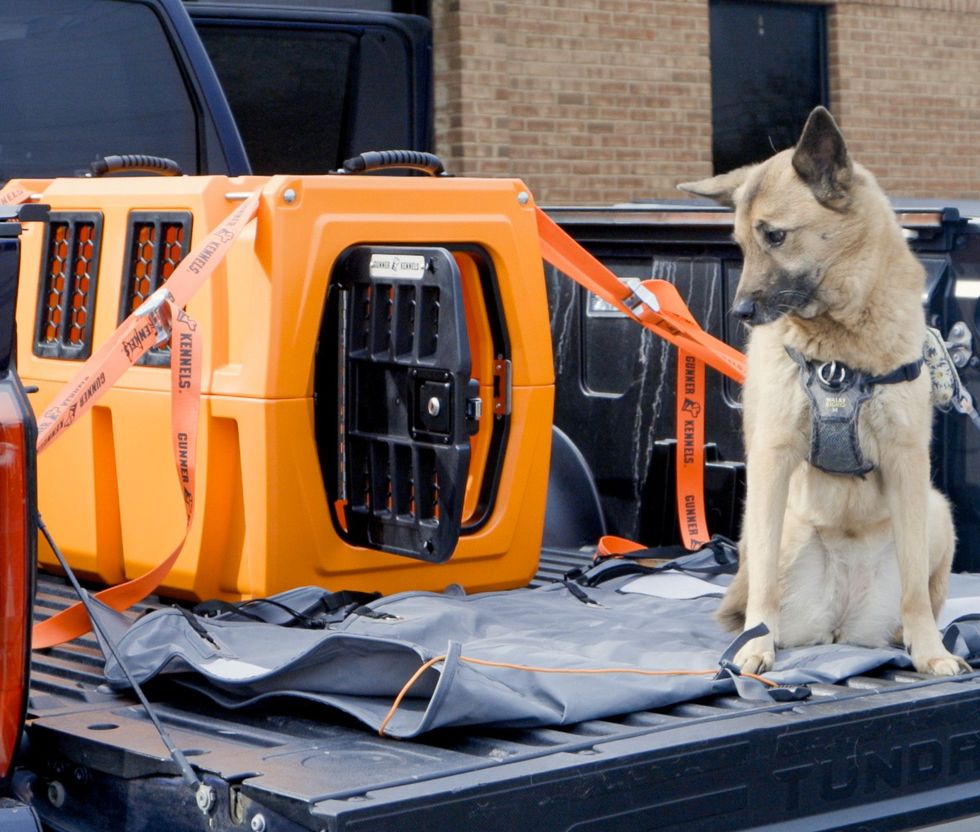
Best Pet Car Crate
Gunner g1 kennel.
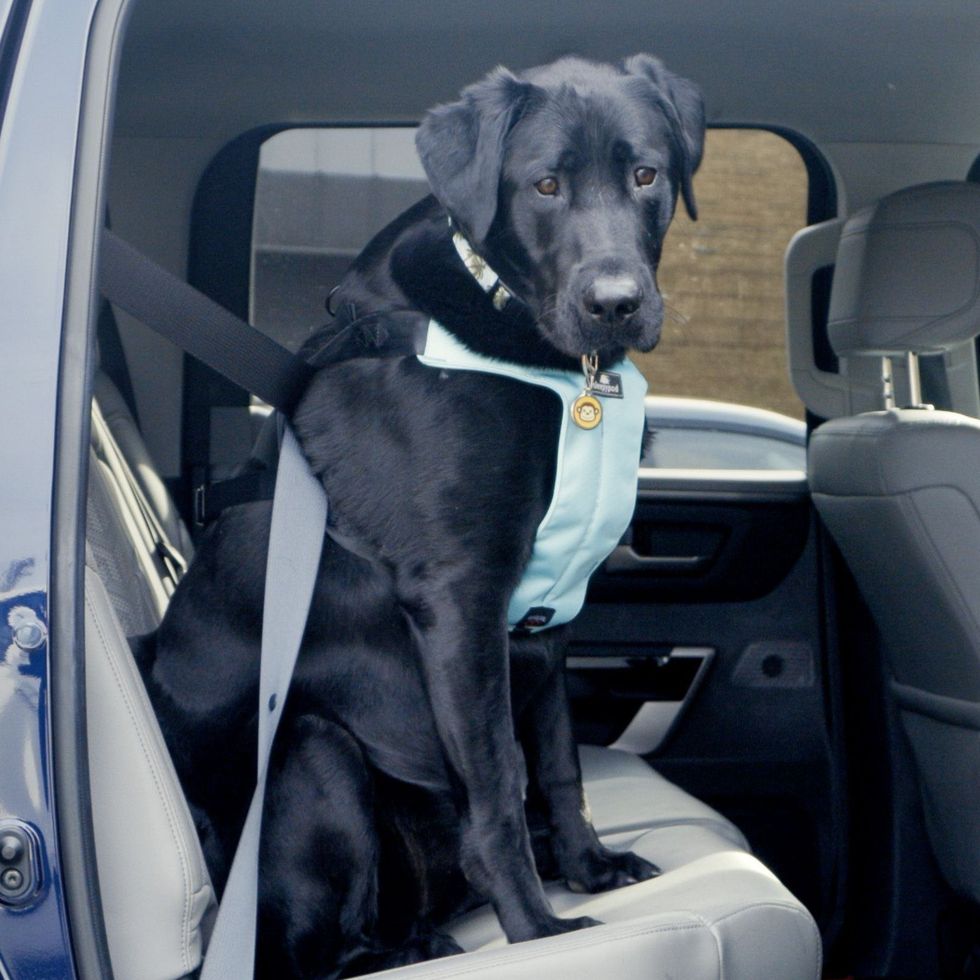
Best Pet Harness
Sleepypod clickit sport.
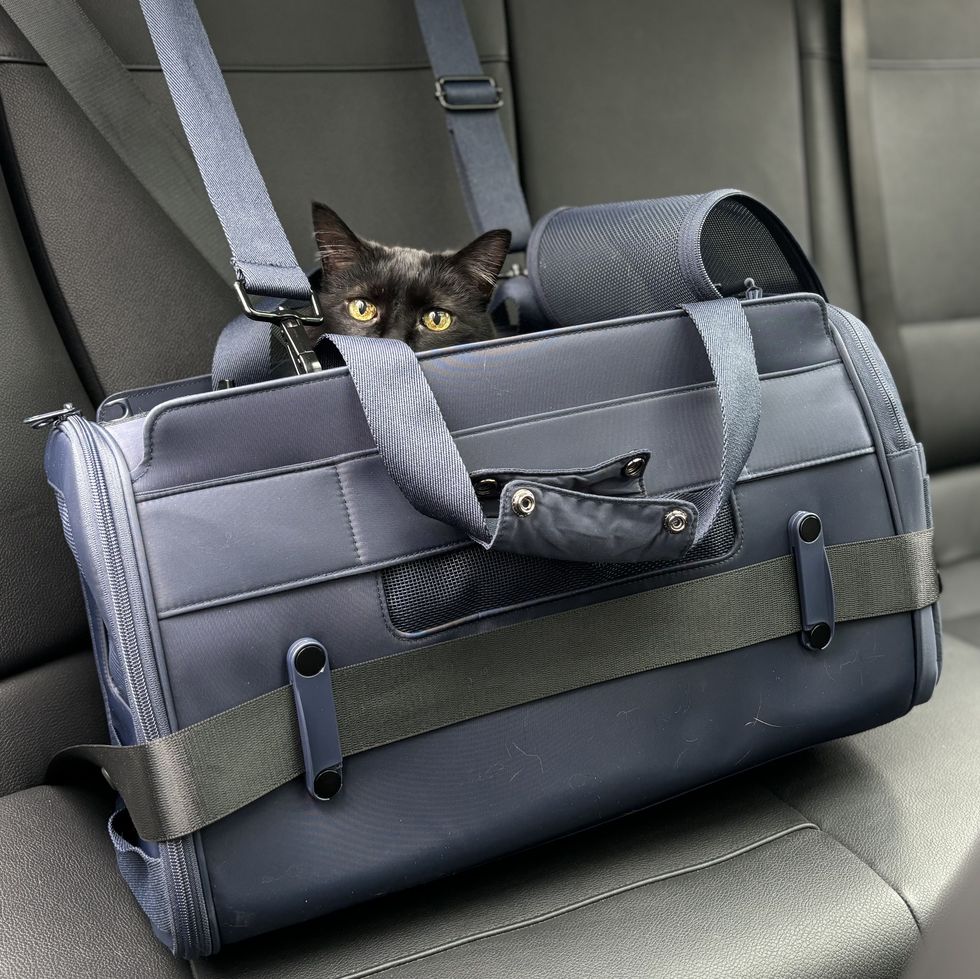
Best for Airline Travel
Diggs travel pet carrier.
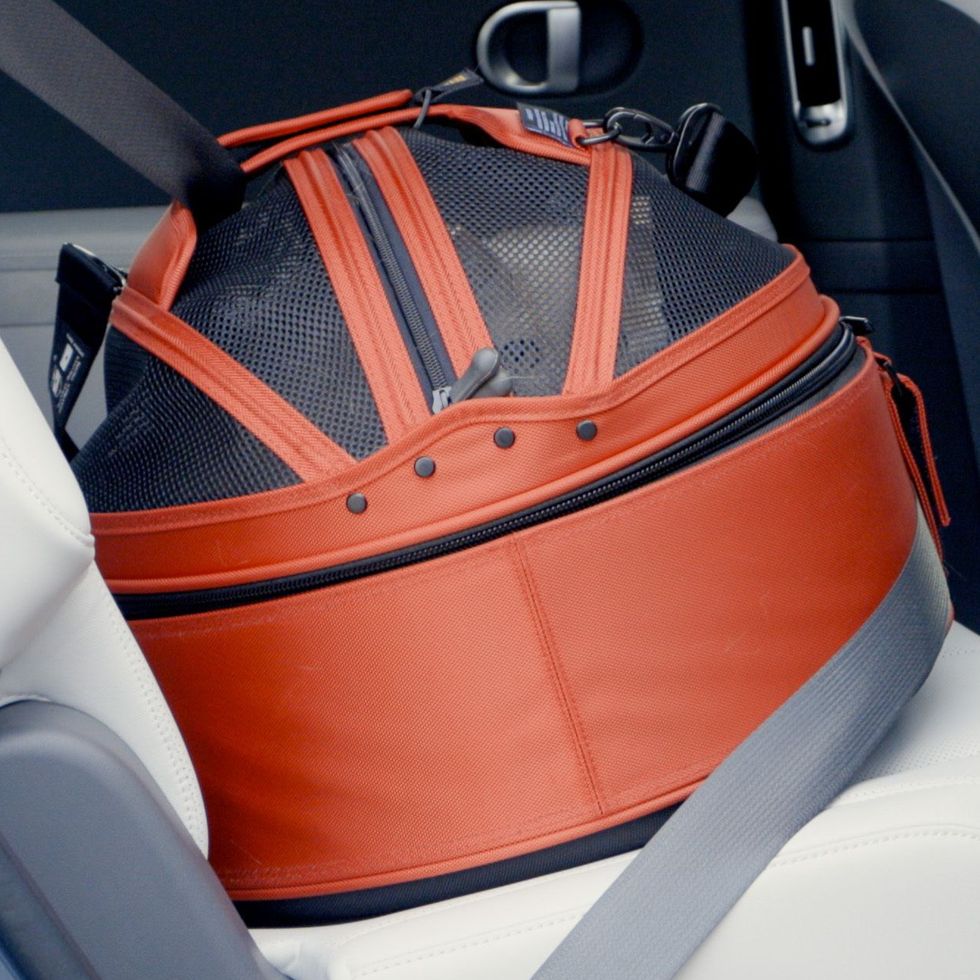
Best for Cats and Small Dogs
Sleepypod mobile pet bed.
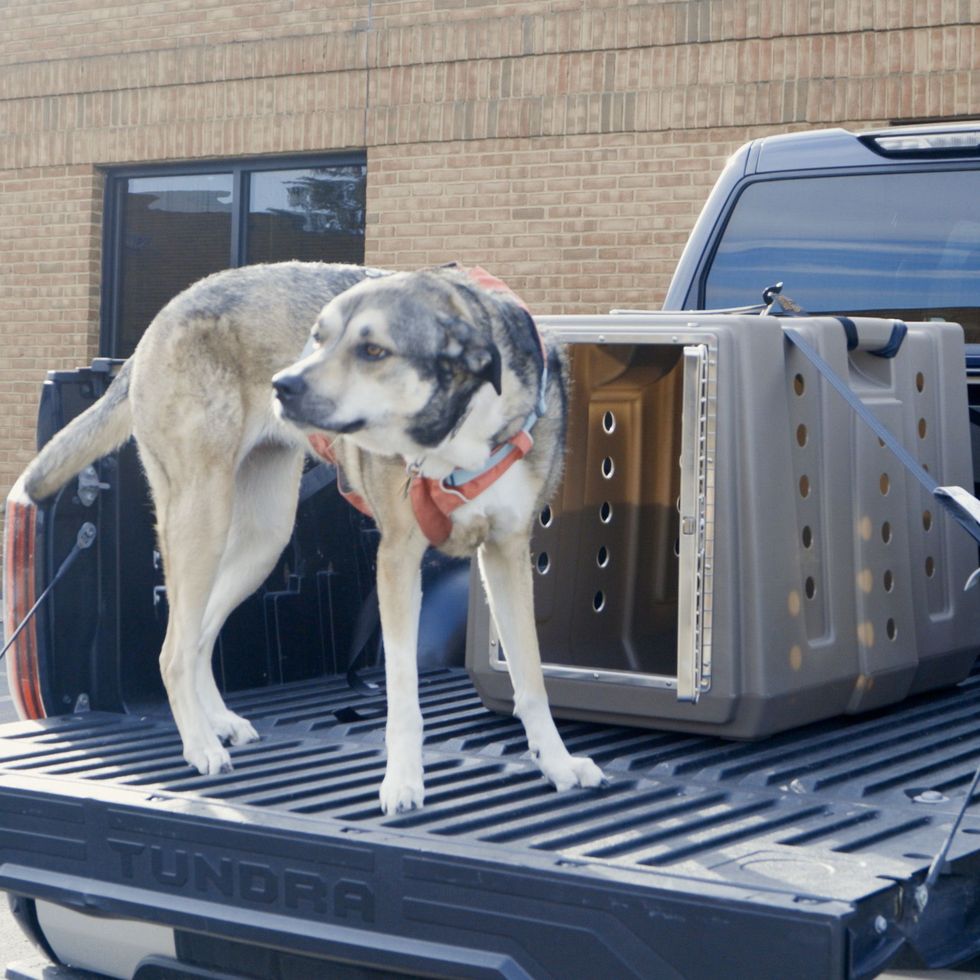
Best Budget Crate
Cabela's gundog intermediate kennel, things to consider.
We love our pets—and we're sure you love yours too. But it's important to know that, like your child (it is your fur baby, after all!), your pet should always be secured—and, preferably, contained—when your vehicle is in motion. That is to say, those simple open pet car seats (like home pet beds) are not enough; the CPS does not recommend them, and we wouldn't use them for our pets, so we declined to include them in this test or this article.
If you're shopping for a cheap, unrestrained pet car seat, you'll need to look elsewhere. But if you want to keep your pet safe while driving, here's what you need to know about car pet carriers and harnesses.
Safety and Independent Testing
While consumables like pet food, treats, and pharmaceuticals are subject to premarket standards, dog and cat car seats are not. This lack of regulation means that any restraint can claim to be safe for your pet.
To ensure your pet's safety, the Gear Team recommends choosing restraints tested by the leading independent pet product testing group, the Center for Pet Safety (CPS). All restraints mentioned in this article have met the CPS's strict criteria. The guidance in this article is directly from CPS, and we thank them for their mission and assistance in creating this informative piece.
Pet seats fall into three categories: crate , carrier , and harness . A crate is generally used for larger dogs and placed in your SUV hatch or truck bed, then secured with tie-down straps to anchor points. A carrier is for smaller dogs and cats (generally under 18 pounds), portable, and secured to the rear seat using seatbelts and headrests. The last is the harness , which rests on a dog's upper body and is secured by the seatbelt.
Harness : The industry standard for harnesses is the "two-finger fit," meaning that a harness is a good fit if you can comfortably fit two fingers between it and the pet's body. CPS implements this fit standard in its testing.
Carrier: When choosing a carrier, pay close attention to the weight rating and the measurement of your dog's body. A pet can feasibly fit into the weight rating but may be too leggy to fit comfortably inside. If you are unsure, weighing and measuring your pet is recommended. Carriers are usually suitable for both cats and dogs.
Crate: A snug fit is critical for crates. This video from Gunner Kennels does an excellent job of demonstrating the importance of a snug fit for your dog. Too much room leaves your dog vulnerable to additional g-forces within the restraint system, so ensure you get the correct measurements and the right-size crate for your animal.
While these restraints are tested for vehicle safety, they are also ideal for other types of travel. If you and your small pet fly regularly, consider a duffle-style carrier that fits onto luggage and underneath plane seats.
You may be a little shell-shocked by the prices, but consider these an investment. Companies that offer safety-certified products have spent considerable time and money to prove their product will protect you and your pet. Also, it's important to remember that if your pet is injured in an accident, the vet bill will likely far exceed the price of the car seat.
How Dog Car Seats & Restraints Were Evaluated
When purchasing a pet restraint for the car, safety should be every pet owner's primary concern. Cost and convenience can be factors, but they should never be the deciding ones. Given that crash testing with live pets is not feasible, we relied on the expertise and data from a leading pet-product advocacy group. However, subjective analysis is also crucial.
We asked the Car and Driver staff to bring their pets in for a photo shoot on testing day. Our work mainly consisted of installing the seats into our long-term Toyota Tundra to understand the ease of use and features that each seat offered. In this test, our role as the Gear Team was to evaluate the following aspects:
- Installation
- CPS safety testing guidance
Note: All products featured were purchased using a personal account. Companies were not made aware of this test.
How the Experts Test Pet Car Carriers
As for things like crash testing, etc., obviously we weren't going to put our personal pets at risk or crash any cars. Instead, we relied on testing data obtained from the experts at the Center for Pet Safety .
CPS grades on a point system for specific elements and uses high-level measurement tools like digital calipers and high-speed cameras to assess their work. The testing elements below are not the entirety of their scientific approach to testing, but they are intended to give you a good idea of what they are looking at to ensure safety. We thank CPS for their hard work.
CPS has strict criteria for passing these products. All products are tested at 30 mph.
- Tested on second-row benches
- Excursion distances (how far the pet launches forward)
- Strap movement (how much does the harness loosen during impact)
- The legs of a pet cannot come loose during impact, the harness cannot break, and any product with an extension tether is immediately disqualified
- Excursion distances (how far the carrier launches forward)
- Carrier lift (measuring the largest angle between the bottom of the carrier and the bench seat)
- Stitching and zippers must remain intact
- Strapping at anchor points cannot tear or rip
- If any part of the carrier fails, allowing the pet to escape, the carrier automatically fails
CRATES + STRAPS
- Tested on carpeted sled machine (to simulate rear SUV hatch and truck bed)
- The doors and windows must remain closed and locked
- The crate and straps cannot fracture or break in any way
- All crates must be anchored down with straps that the company provides
The Best Pet Car Seats, Harnesses, and Restraints
It's rare that we open a box and are immediately impressed, but that's what happened with the Gunner G1. Gunner car kennels are designed and marketed with hunters in mind, yet we see no reason this crate wouldn't be an excellent fit for anyone with a dog. We'd be hard-pressed to find a city-, suburban-, or country-living pet owner who wouldn't be captivated by this crate. It's that good.
The double-wall, rotomolded design results in sturdy walls. The robust door features three locking points—one key and two slider locks. And it comes in small, medium, intermediate, and large sizes. The small G1 is certified for the back seat and rear installation, while the other sizes must be in the truck bed or cargo hold only. Basically, the Gunner G1 car kennel is a tank and is clearly built to last. But quality comes at a cost, and its materials and construction also mean it's relatively heavy and quite cumbersome.
Safety Testing
Gunner has done its work in research, development, and safety. In the video below, you'll see some sliding about, but the carrier's shape remains intact, the straps stay attached, and the door stays secure. Gunner has also tested with other third-party facilities, including running this enlightening drop-crushing test to simulate crumple zones in a car accident.
Notably, the G1 needs to be strapped down, of course, and Gunner's accessory straps will set you back another $100. Now, while it would appear normal ratcheting cargo straps might work just fine to secure the crate, CPS does not certify non-OEM equipment. So, use your own straps at your own risk. (Moreover, CPS notes that the Large G1 did not pass its safety certification process.)
Still, there is plenty of anecdotal evidence by real users on the company's testimonials page . Real dogs in Gunner kennels are coming out unscathed after some pretty gnarly pickup-truck accidents. If that doesn't convince you that Gunner kennels are the best car pet crates you can buy, we don't know what will.
If you're looking for a walking harness and a safety-certified car restraint, the Sleepypod Clickit Sport is the perfect choice . The front portion of the harness is lined with a shock-absorbing padded vest. The back portion is typical of most walking harnesses, except for the addition of two automotive-grade seatbelt loops connecting the harness's top to the bottom. Using the vehicle's seatbelts, you run the latch plate through the two harness loops and into the buckle, and now you have a properly secured pet.
We were initially apprehensive, thinking a restraint on a dog's back might be agitating. Yet, when we secured Bodie to the seatbelt, he seemed perfectly content, and we could see it wasn't pulling with much pressure. The seatbelt is not meant to lock, so your pet should be able to sit up, lie down, and shift position comfortably. It turns out that what we thought would be a problem wasn't much of one, at least for Bodie.
While we (and Bodie) were pleasantly surprised by the Clickit Sport, we must admit the harness's double-looped strap system required serious brain power. Instead of pulling out your hair like us, we suggest you watch this instructional video on how to do it.
For the harness testing, CPS looks at "excursion measurements," meaning they are concerned with how far the pet will travel after impact. Paying attention to the red and yellow flags shows that the chest generally stays within the first flag. This is partly because of the seatbelt locking up but also, in part, because of the tight double-loop strapping mentioned above. CPS marks the initial buckle placement during testing and measures the loosening distance after impact. After realizing this was a testing parameter, it makes sense why the harness uses such a complex adjustment design.
Regarding harnesses, we were surprised that the product didn't come with an extension. Like many people, we imagine dog restraints in cars with a harness attached to the seatbelt buckle or headrest. However, it turns out this setup is categorically unsafe for your pet. "Extension tethers are extraordinarily dangerous," Wolko says. "If a brand includes an extension tether or component, they are automatically disqualified from participating in [CPS testing]." Wolko emphasized this in our interview. Read more in our FAQs.
The Diggs Travel Pet Carrier was designed with both automotive and airplane travelers in mind. The carrier stacks on top of your roller luggage, secured by a firm strap on the carrier that threads through the handle. It has several storage pockets to access your passport, phone, leash, etc., quickly.
Staff photographer Michael Simari took the Diggs home to test with his cats. "My cats immediately checked it out and even went in on their own, which never happens," Simari says. "They avoid carriers at all costs." After a few days of acclimation, his cats freely entered the carrier, and he could buckle them up in the car. While we know this is anecdotal and every pet will be different, if a couple of carrier-apprehensive cats were comfortable after a single weekend, we reckon Diggs is on to something.
For installation, there are three anchoring points to consider. First, you wrap the waist belt around the bottom of the carrier and loop it through two swivel clamps. Next, connect the chest belt over a clip loop at the carrier's top. Our main beef about the Diggs is that it didn't come with instructions, so we had to go digging online for this TikTok how-to . This was not a huge barrier for us, but it could be a big deal to someone who isn't digitally proficient.
For testing carriers, CPS is concerned with how far the carrier launches forward, the lift angle, and whether or not any features like zippers and stitching failed. In the footage, you can see the red and yellow flags that show the farthest a carrier can travel and still pass, and the Diggs Travel Pet Carrier stayed well behind the limit.
If you appreciate functionality and a unique aesthetic, the Sleepypod Mobile Pet Bed might suit you. Its round shape sets it apart from other carriers on the market, and in our professional opinion, pets somehow seem even more precious in a round carrier than a square one.
We especially liked that the Sleepypod doubles as a bed, seamlessly integrating the carrier into your pet's daily life. Since getting a cat into the car can be stressful, we appreciate that the Sleepypod considers the entirety of a pet's relationship with the carrier. Adapting the bed into a carrier is easy—slip the mesh dome over the bed, zip it up, and your pet is now secure in a safe space.
Installation is straightforward. The lap portion of the seatbelt wraps around the bottom of the round bed, and the shoulder portion is routed through the security strap at the top of the dome. The only difficulty we had with the carrier was fitting the security straps back through the plastic clips. We figured it was a tight squeeze to meet safety standards, but it was definitely a struggle.
During impact testing, forward motion is relatively contained by the safety belt attached to the lap and shoulder strap. The rebound lift is minimal, and the hefty zippers and straps remain intact even with the pet noticeably rebounding inside.
Sleepypod has tested all its products with CPS. While we are specifically featuring the Sleepypod Mobile Pet Bed, it's important to note that the Sleepypod Atom (five stars), Sleepypod Mini (five stars), Sleepypod Air (four stars), and both of their harnesses are also CPS certified.
GunDog is Cabela's line of hunting-dog accessories, and the Intermediate Kennel might be your best bet for an affordable crate. This crate is like other ones you're probably familiar with—a single-wall molded plastic crate with a stainless-steel door. The handles are part of the molding, making them sturdy and easy to move. Plus, it's lightweight, so our testing team found it easy to shift around.
While the GunDog doesn't have many standout features, its simplicity is its strength. In a world of bells and whistles, Cabela's has kept it straightforward. It comes in one color, includes straps, uses an additional manual slide lock for security, and is molded as a single-body construction. It's nothing flashy, but the price reflects that. It's simple yet effective, making it a great budget option for a safety-tested crate.
The main complaint we have about the Gun Dog is the strap-down pattern. The crate must be strapped correctly to maintain the safety certification. But boy, did we find it challenging to get right. We recommend double- and triple-checking your work, especially if spatial awareness is not your strong suit. Incorrect strapping could unknowingly put your pet at risk during transport.
The Center for Pet Safety awarded the Cabela's GunDog crate five stars, meaning it has passed the main parameters: The doors remained locked, sliding is minimal, straps did not break, and the crate isn't fractured or broken.
However, while the crate meets safety standards, it may deform during impact, as seen in the footage. "It did have a fair amount of crush," Wolko says. "But it popped right back into place when we removed those straps."
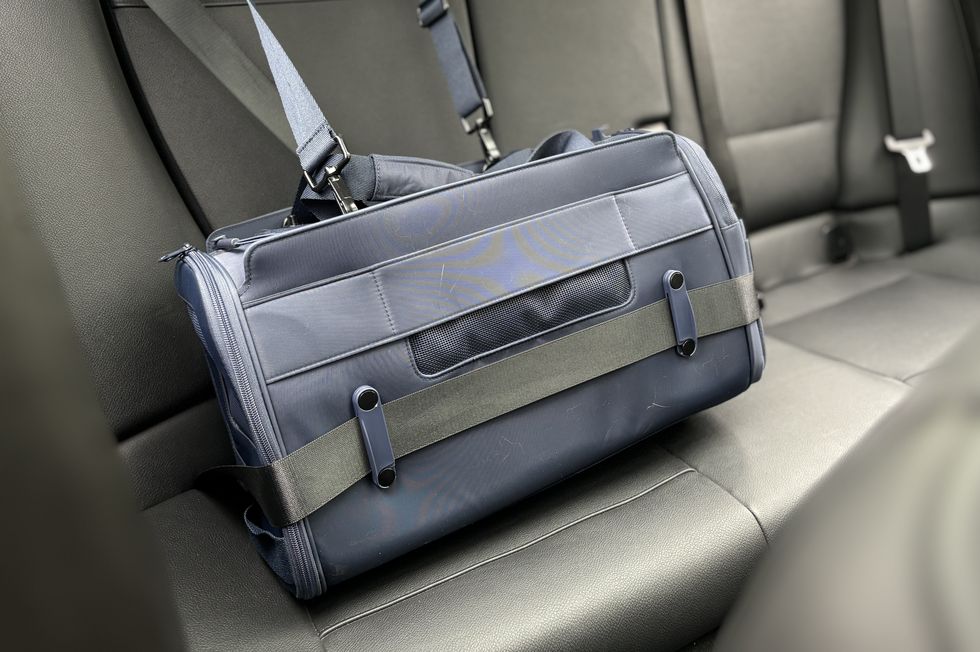
What is a dog car seat?
A pet car seat or restraint is specially designed for safely transporting pets in your vehicle. Like any unrestrained car occupant, if your pet is not restrained correctly, it can become a projectile within the cabin during an accident, causing injury or worse. A crate, carrier, or restraint should contain your pet during and after an accident.
The Gear Team recommends purchasing only carriers and car seats tested and approved by the Center for Pet Safety.
Can my cat use any of these carriers?
Yes, any carrier within the carrier category is suitable for cats, as long as they fit comfortably and are within the weight restriction.
How can I be sure my pet seat has been adequately tested?
This article features only a handful of dog car seats, and several more are on the market that meet strict safety criteria. If you want to explore more products that CPS has tested, visit their website at www.centerforpetsafety.org . You can learn more about other tested and certified products under the "CPS Certified" tab.
Are dog and pet car seats easy to install?
While these seats have passed rigorous testing, their effectiveness relies on proper attachment to the anchoring points. This ensures that in an accident, the carrier will perform as expected. Always read and practice installation instructions for optimal results.
Can pet car seats be used in all types of vehicles?
Yes and no. Harnesses are generally compatible with all seatbelt restraint systems. Carriers are compatible with seatbelt restraint systems but should be used in the second row. Crates are compatible with the rear hatch of a larger SUV and truck bed. Always confirm with the seat manufacturer before purchase that your car is compatible.
Can dog car seats accommodate more than one dog?
Would you put two kids in a child car seat ? Probably not. One carrier/restraint per pet, please.
Why can't I attach my dog's harness and leash to the anchor points of my car?
If you decide to go the harness route, you should be clear about the difference between distraction and crash-safety devices. A harness attached to any extension tether may effectively prevent driver distraction, but it is categorically unsafe for the pet during an accident. According to CPS, any harness with an extension rope as part of their product is automatically disqualified for crash-safety certification. This video does an excellent job of explaining the risks of a harness-plus-extension combination during an automotive collision.
Why Trust Us
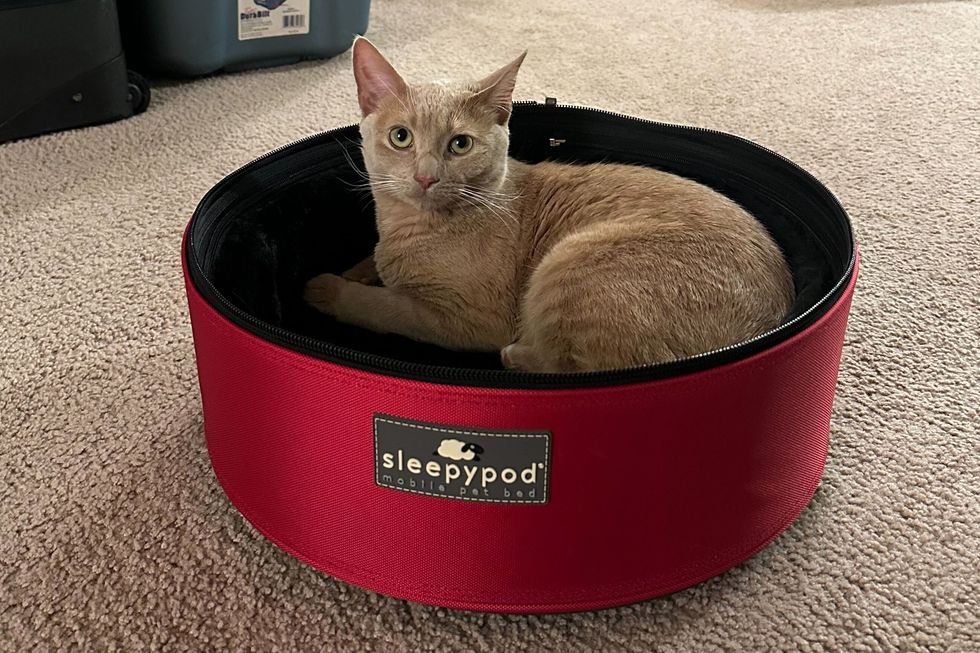
Hearst Autos combines the talent, resources, and expertise of three of the largest, most influential automotive publications in the world. The Gear Team has tested a wide variety of automotive products, parts, accessories, and gear, such as dash cams , portable jump starters , and snow brooms and ice scrapers . We get our hands on each and every product we test. Most are purchased; some are supplied by manufacturers.
Hearst Autos doesn't need to game algorithms for traffic or promote lousy products. We're more concerned with our legacy, our reputation, and the trust that our readers have in Car and Driver , Autoweek , and Road & Track to deliver honest opinions and expert evaluations.
Visit our Tested & Trusted page to see the very best in automotive gear. Read more about our product testing and evaluation process here .
Katherine Keeler is an Assistant Testing Editor at Hearst Autos. By day she evaluates tools for your enjoyment; by night, she Frankenstein’s her ever changing fleet of rust-bucket-oddities back to repair. Her dream is to open a roadside attraction where the public can view, drive, and learn repairs at her emporium of curious cars.
Collin Morgan is a Commerce Editor at Hearst Autos, where the former Rust Belt mechanic and gadget enthusiast presents the best gear for your automotive endeavors.
Gannon Burgett loves cameras, cars, and coffee: a perfect combination for his Hearst Autos work. His byline has appeared in USA Today , Gizmodo , TechCrunch , Digital Trends , the Detroit Free Press , and more.
.css-190qir1:before{background-color:#000000;color:#fff;left:0;width:50%;border:0 solid transparent;bottom:48%;height:0.125rem;content:'';position:absolute;z-index:-10;} The Auto Enthusiast's Shopping Guide .css-188buow:after{background-color:#000000;color:#fff;right:0;width:50%;border:0 solid transparent;bottom:48%;height:0.125rem;content:'';position:absolute;z-index:-10;}
Tested: Best Car Wax
Tested: Best Carwash Soaps

Best Car Cleaning Products for 2024
Tested: Best Automotive Glass Cleaners for 2024
Best Shop Vacs for 2024, Tested

Get Amazing Deals on Watches Right Now at Amazon

Best Deals at Amazon's Spring Sale
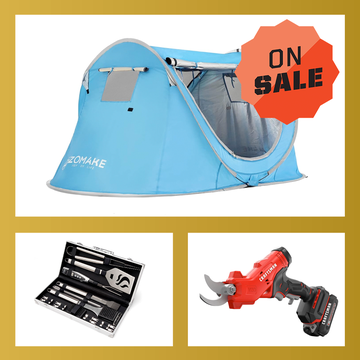
What You Need to Know About Amazon’s Spring Sale
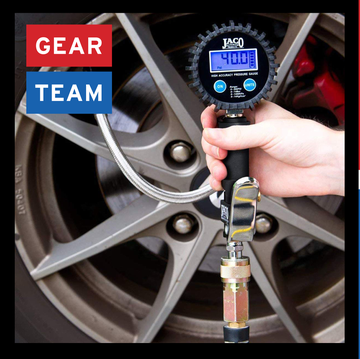
Our Favorite Tire Pressure Gauges of 2024
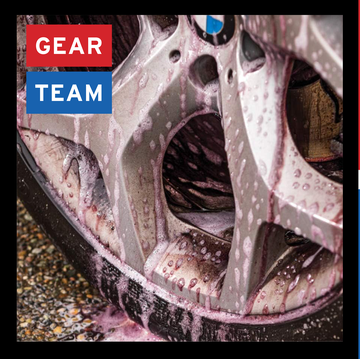
Top Wheel Cleaners for 2024
Tested: Best Car Interior Cleaners for 2024

16 Car Safety Tips When Traveling with Your Dog
Posted: March 22, 2024 | Last updated: March 22, 2024
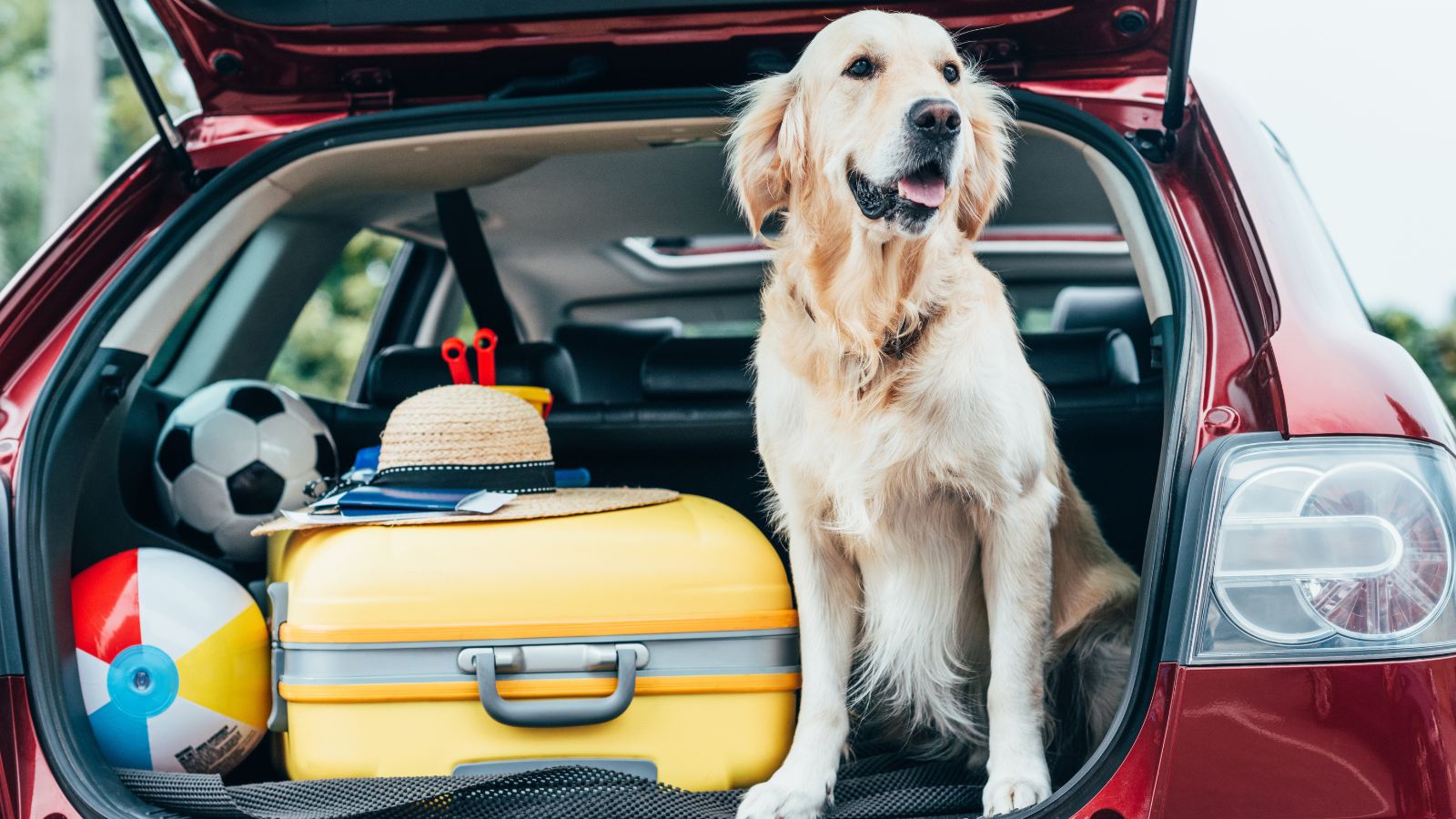
Nearly seven in 10 U.S. households owned a pet as of 2024, according to Forbes.
If your dog travels with you on family road trips or when you’re running errands, you’ll want to ensure it’s safe from point A to point B. Just because your dog likes to poke its head out the window, play on your lap, or wander around a moving car, doesn’t mean it’s right.
So that you and your four-legged bundle of joy get to and from in one piece, here are 16 car safety tips when traveling with man’s (or woman’s) best friend.

1. Keep Your Dog in a Crate Secured in the Back Seat
This tip will break the hearts of dog owners everywhere. But neither your lap nor the front passenger seat is a suitable place for your dog when the car’s in motion. Keep it in a crate secured in the back seat with the seatbelt system. Your dog will be safer that way.

2. Don’t Allow Your Dog to Poke Its Head out the Window
You’ll likely see dogs with their heads poked out a window. It can be a sight for sore eyes — and dogs often enjoy the fresh air as much as their human companions. But one reason to avoid this is the potential for eye irritation or injury should an airborne rock or pebble get into their eyes.

3. Bring Enough Food and Water
It’s essential to bring enough food and water for your fur baby. Of course, you might not have to bring food if the trip is short and your dog ate before you left home. Always bring water so your pet can access it when feeling parched.
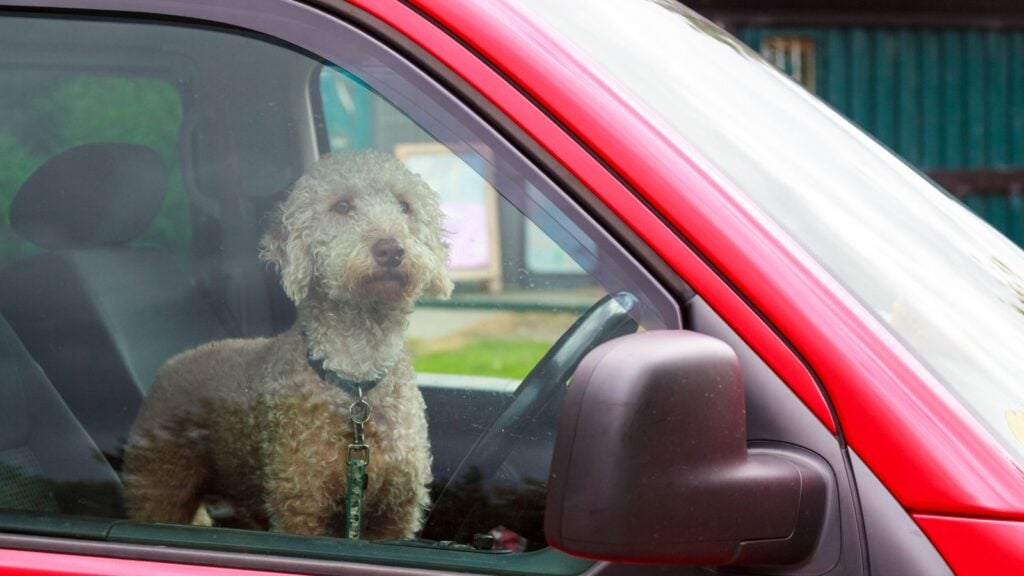
4. Don’t Leave Your Pet Unattended in the Car
Leaving your beloved pet unattended in your vehicle is a no-no. Even if you just need to run into a grocery for a few minutes. The only exception is if you have a car with a “dog mode.” For instance, Teslas have a feature where you can safely keep your pet in the vehicle. The EV maintains a comfortable interior temperature — and the front screen displays a message informing concerned passersby that your dog is okay.
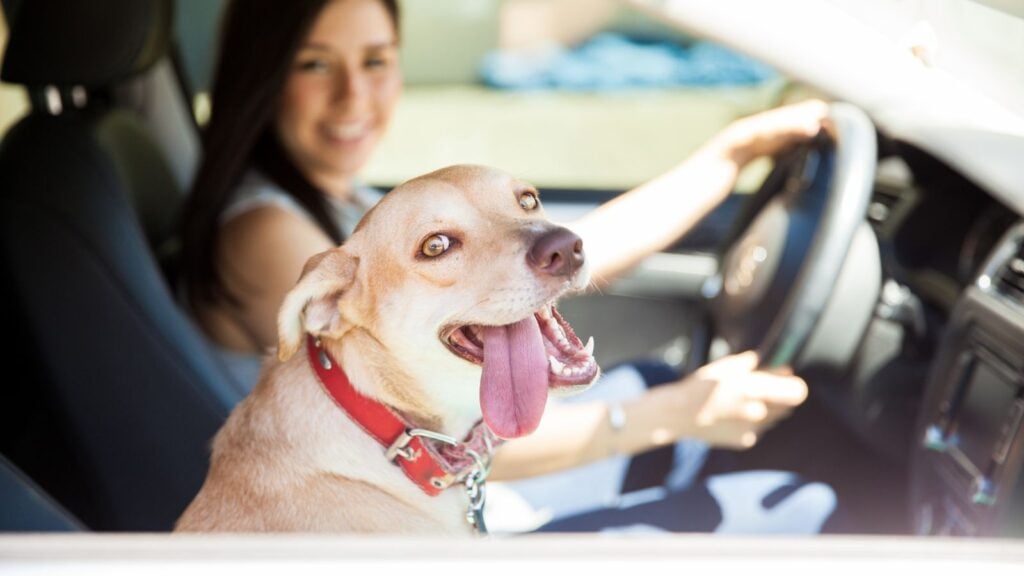
5. Stop for a Break
Some sources suggest stopping for at least 15 minutes every two hours during a road trip. That’s not just good for you but also for your dog. Take it out for a walk so it can stretch its limbs, do its doggy business (bring a doggy bag to clean up after your dog!), and get fresh air.
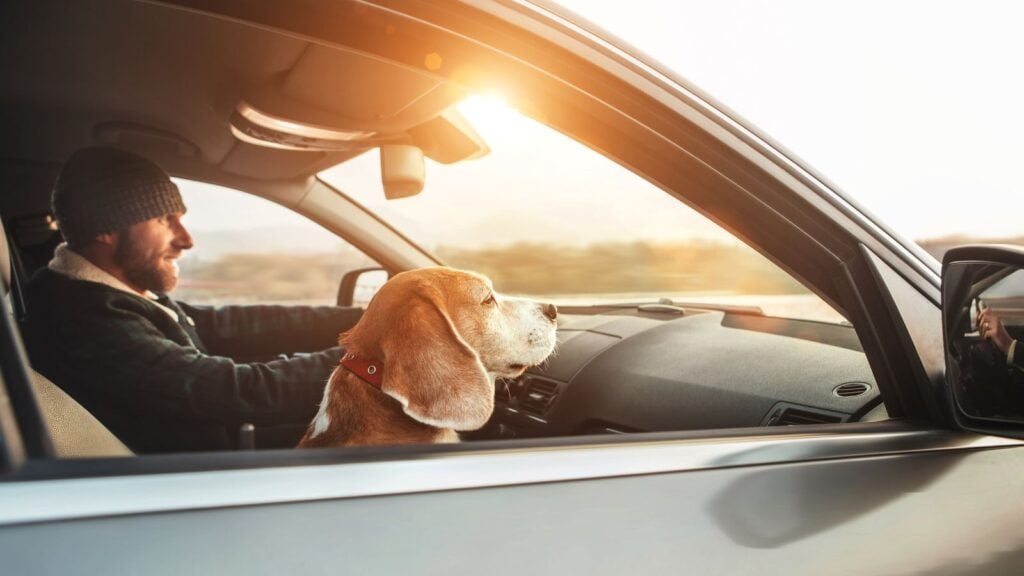
6. Don’t Allow Your Pet to Be a Distraction
Yes, your dog always wants your attention. And it might do its best to get it. But while driving, it’s in your and your pet’s best interests to concentrate on driving.
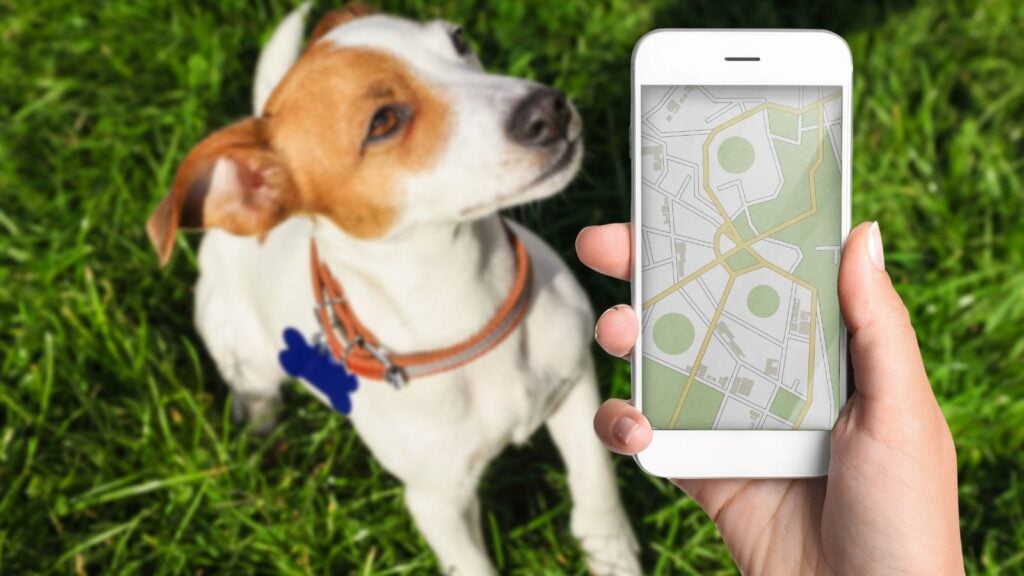
7. Use Pet Tracking Device
Another way to keep your dog safe when traveling is by equipping it with a pet tracking device. You can get a collar-mounted tracker. Pairing it with an app, you can easily find where your pet is should the two of you be separated.
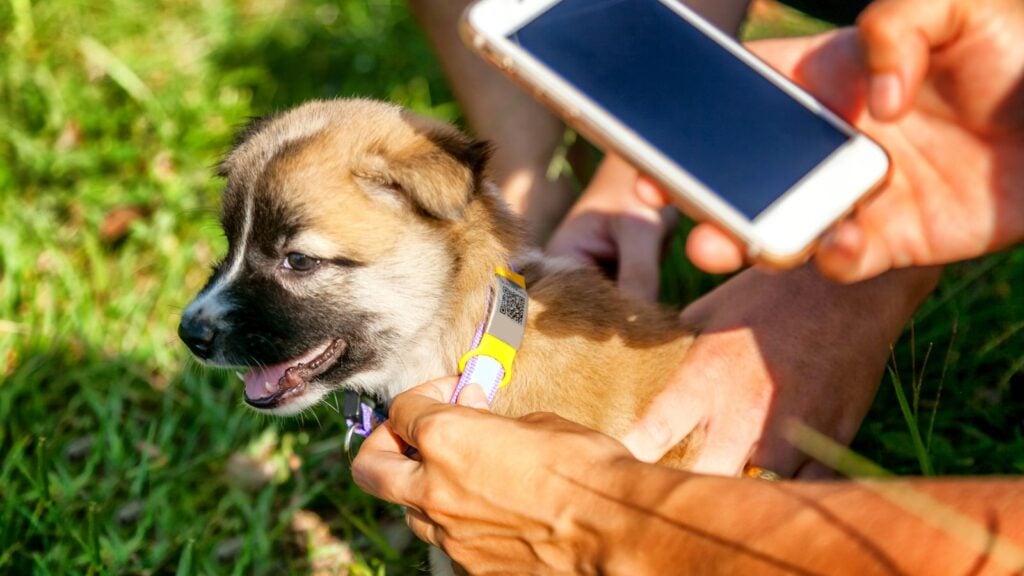
8. Bring Identification
Ensure your dog’s collar tag includes its name and your contact information so that someone can get in touch with you if your dog is lost. You can go one step better by getting your dog microchipped.
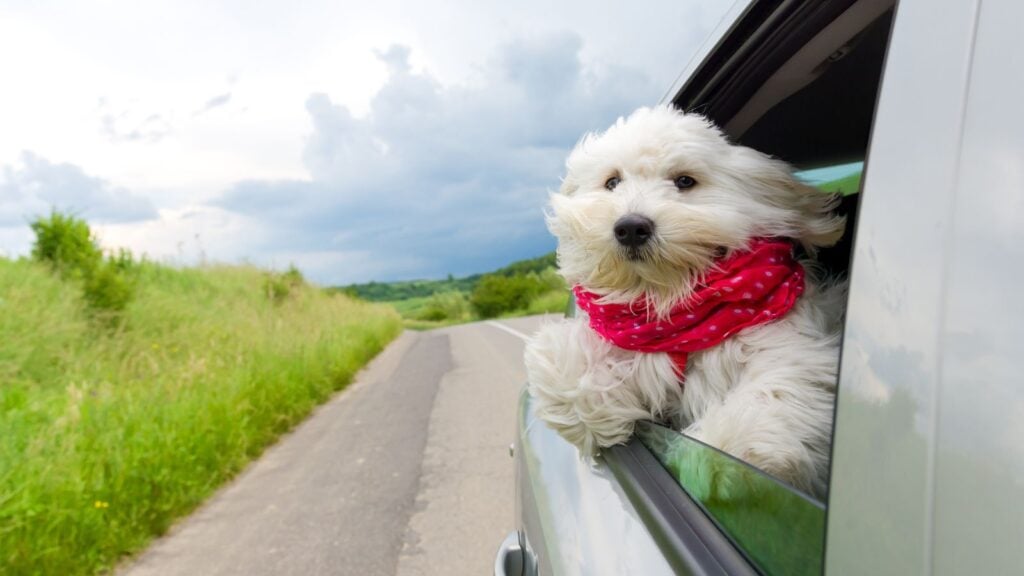
9. Be Mindful of Open Windows
Dogs that are easily distracted and that are impulsive might leap out an open window if something outside the vehicle captures their attention. So, if your dog is impulsive, ensure the windows aren’t down too low.
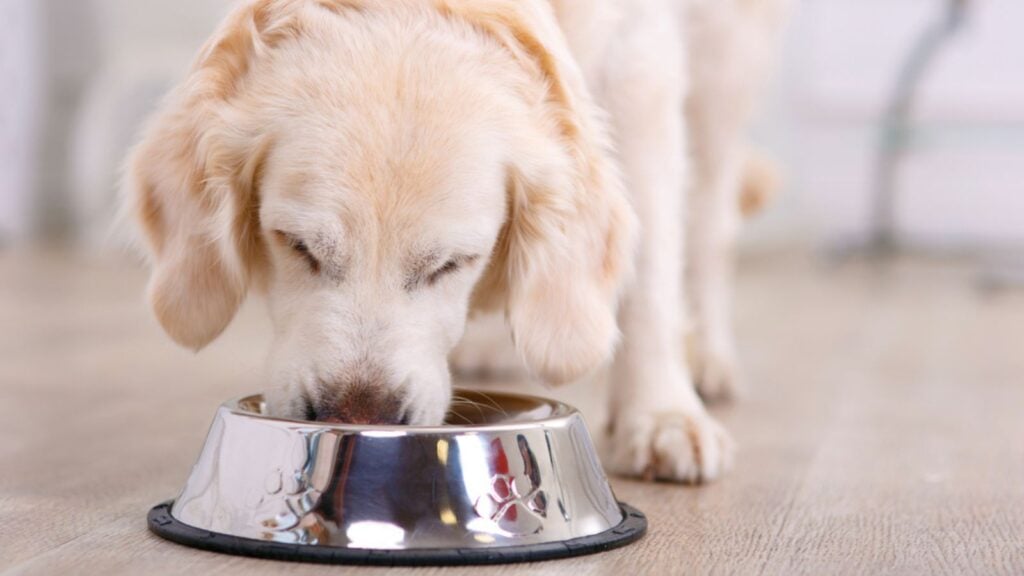
10. No Table Scraps
It’s never a good idea to feed your dog table scraps — no matter how much they beg with their puppy dog eyes. It’s equally vital that you watch what you feed your dog when traveling. You’ll want to stick to its kibble rather than feed it scraps from whatever you eat along the way.
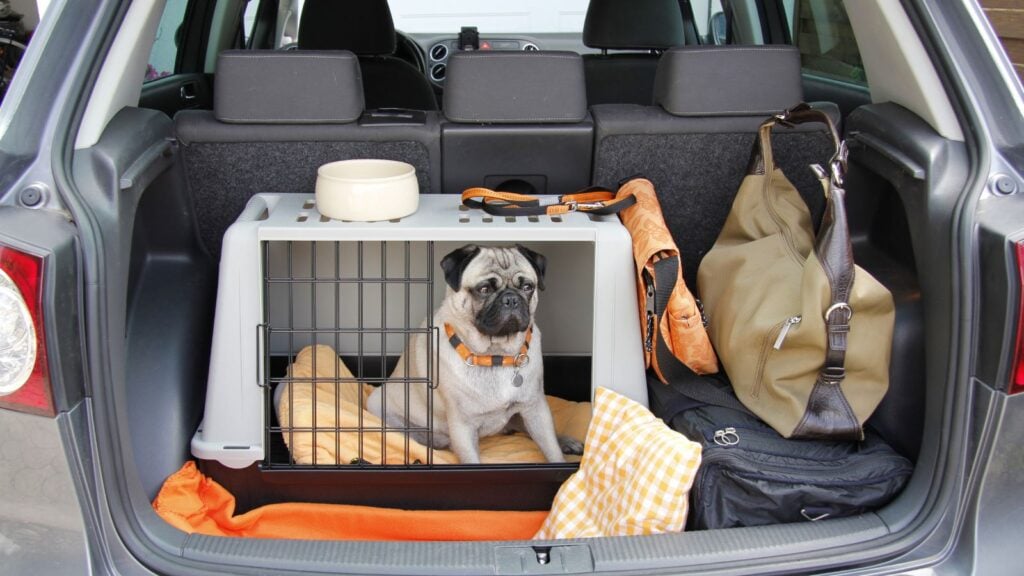
11. Give Your Dog Some Space
Ensure your dog has sufficient space while traveling in your car. Even if it’s safe and sound in a doggy crate, you don’t want it to be boxed in. And neither does your dog.
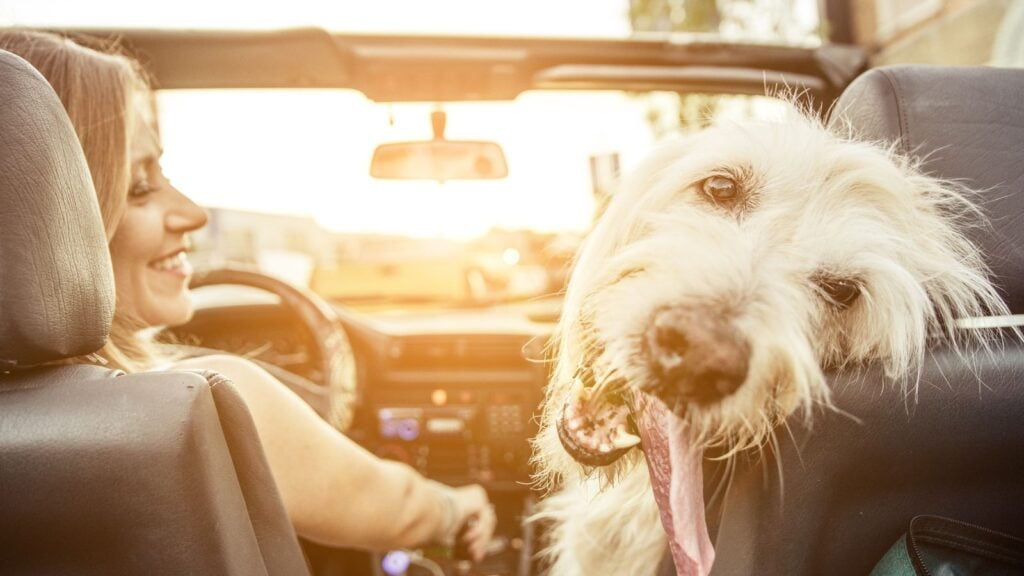
12. Lower the Volume
Dogs are sensitive to loud noises. So, if you’re traveling with the dog, that’s not the time to pump up the jam. Otherwise, your pet won’t enjoy the trip as much as you do.
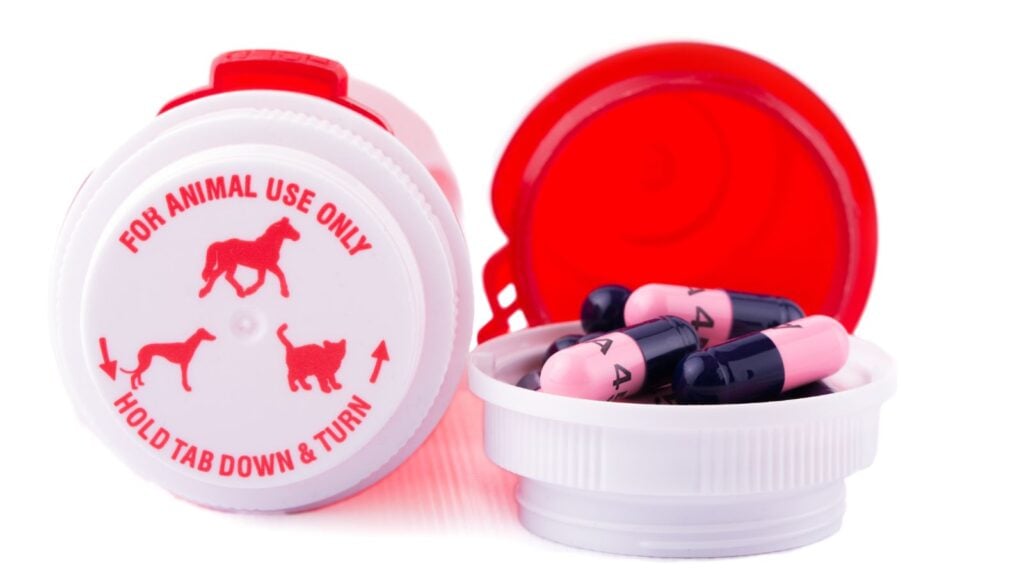
13. Bring Your Pet’s Meds
If you’re going on a road trip with your dog, don’t forget to bring their medication. Does your pet have a health condition, such as a digestive issue? Your dog will be safer and more comfortable if you have its medication on hand.
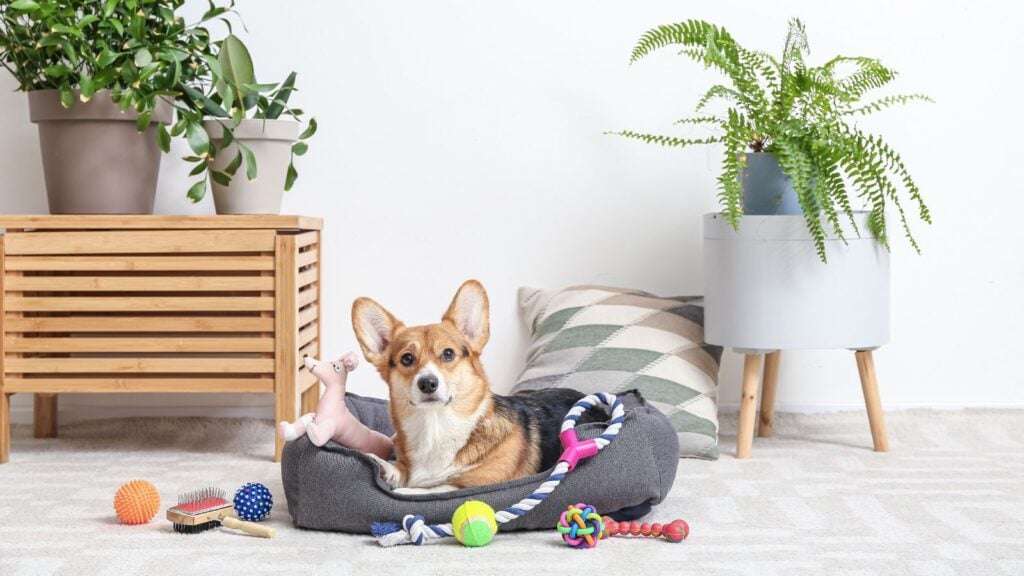
14. Choose the Right Accommodations
Not all hotels accept dogs. Find a pet-friendly hotel that welcomes guests with dogs. You’ll want to ensure it’s a good place to walk your dog so it can explore and blow off steam.
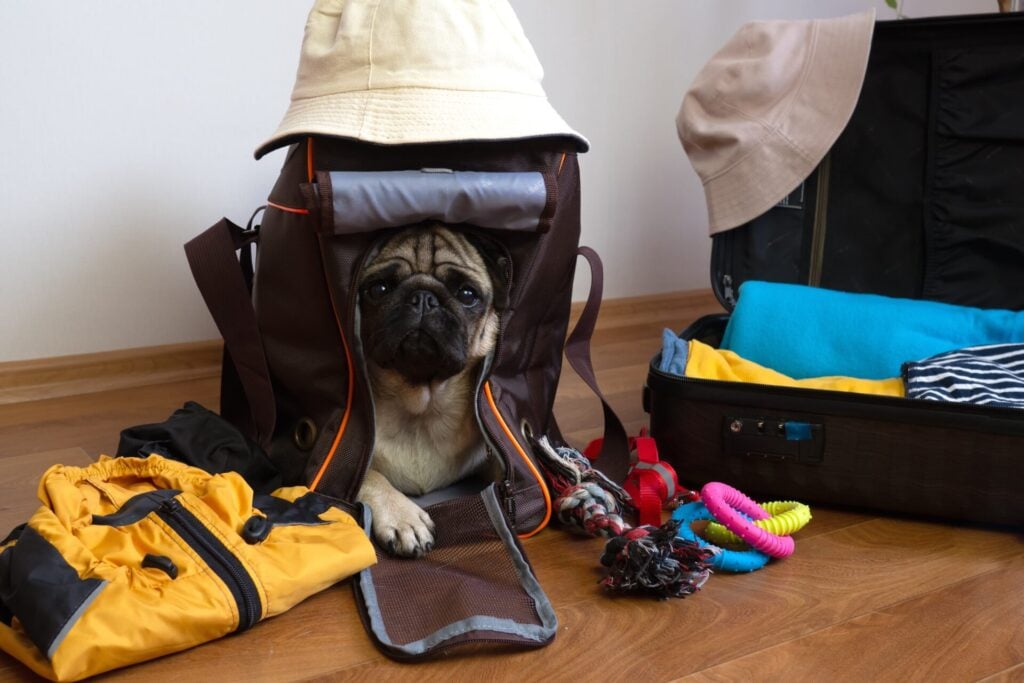
15. Pack a Travel Kit
It’s a good idea to assemble a travel kit if you’re on a road trip. Ensure the travel kit has your dog’s health records, such as immunization records. Among other things, pack cleaning products so you can clean up any mess your dog makes.

16. Bring Weather Appropriate Gear
Depending on where you’re headed and the time of year, your dog might be more comfortable with specific doggy gear. Are you road-tripping during the winter to a state where there’s snow? You might want to invest in doggy boots and outerwear to keep your dog comfortable.
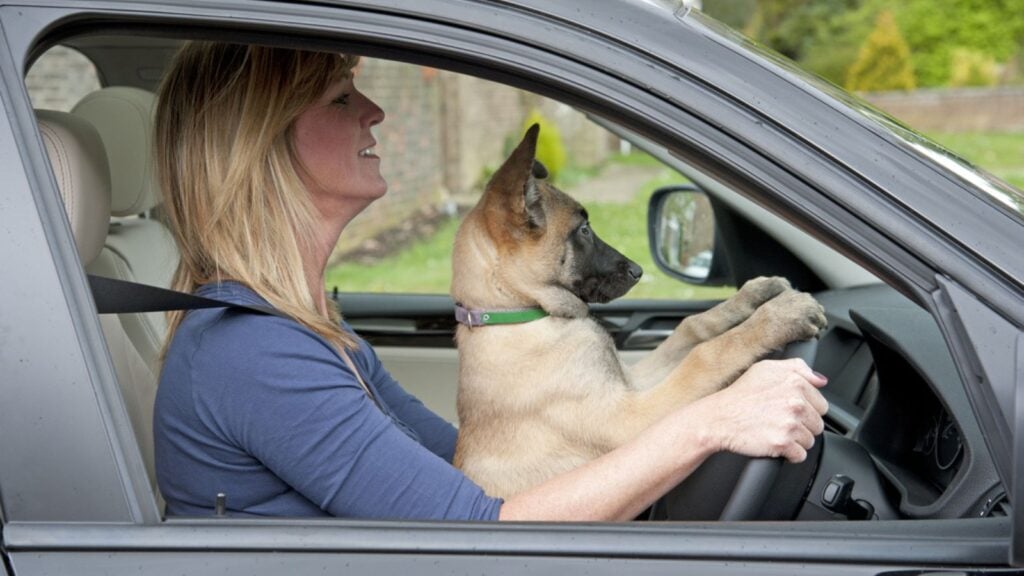
Traveling With Your Dog Can Be Fun — But Make Sure They’re Safe
A road trip with your dog can be great fun. But you need to do some things to ensure your pet is safe. That way, you’ll both enjoy the time spent on the road with you.

More From SewCanShe
- 16 Things Introverts Do That Other People Think Are Weird

- 15 Hobbies That Were Trendy in the ’80s But Now Make You Look Ancient

- 18 Classic Habits That Instantly Label You as an Old Soul

- 15 Assassinations that Altered the Course of History
More for You
Caitlin Clark gets fancy and dazzles in a red dress to collect Wooden Award
King and Queen ‘utterly shocked and horrified’ by ‘senseless attack’ in Sydney
Use this 2-word phrase when your boss asks you to do more work than you have time to do, according to a therapist
Woman with rare syndrome left allergic to ‘everything’ except just four foods
Supreme Court unanimously rules against exorbitant government fees
Your senses will shut down in a specific order when you’re about to die
7 CDs You Probably Owned, Threw Out and Now Are Worth Bank
Biden releases statement after Netanyahu phone call
‘SNL’ recap: Ryan Gosling hosts, alien abduction cold open, Emily Blunt and Caitlin Clark
The Most Terrifying Bridge in Every State
Krispy Kreme Is Only Requiring Customers to Pay Sales Tax on a Dozen Donuts as a ‘Sweet Tax Break’ on Tax Day
Florida Removes 1.4 Million People from Health Care Plan
Park Bo-ram Dies: K-pop Singer Was 30, Circumstances Under Investigation
Vladimir Putin issues chilling new WW3 warning after successful test of experimental nuclear missile
I study people with high emotional intelligence for a living—8 things they never ever do when talking to others
Michael Cooper shares wife's uncanny suggestion of making Larry Bird his HOF presenter: "When it is all over with, we're all human"
These Are 10 Smells That Cats Absolutely Hate
Emergency Symptoms of a Sinus Infection That Spreads to the Brain
78 Riddles for Adults That Will Test Your Smarts
Why ‘Civil War' Is Making Audiences So Uncomfortable
Best Cars for Dogs in 2023
On the following slides, you’ll find cars, crossovers and SUVs that have lots of pet-friendly features, such as durable cabin designs, big cargo areas suitable for travel crates and flat-folding rear seats. Some manufacturers even offer dog-friendly accessories or tech features.

IRYNA KAZLOVA | Getty Images
Best Ways to Travel With Your Four-Legged Friend
If your pooch is a frequent passenger in your vehicle, you’ll know that some makes and models are more convenient than others. And, if you’re in the market for a new vehicle, it’s a great time to think about ways to make it easier to travel with your whole crew.
Advertisement
Keep reading to learn more about the best new vehicles for dogs and their owners. As you read, keep in mind that we update our reviews throughout the year as new information becomes available, and, therefore, the scores you see here might not reflect the scores in a vehicle’s review.

Stellantis |
- 2023 Jeep Wrangler
$31,195 | U.S. News Overall Score: 7.3/10
If your dog likes to trek along on hikes and camping trips, the Jeep Wrangler is a great choice because the drive is part of the adventure. You probably won’t want to take the doors and roof off while you’re traveling with a pup (unless it’s secured in a crate, of course), but the Wrangler’s specifically designed to be easy to clean.
The base price shown above is for the two-door model, which may provide extra peace of mind since your dog can’t jump out. Four-door models offer much more cargo space, however. For 2023, the Wrangler gets standard Apple CarPlay and Android Auto .
More on the 2023 Jeep Wrangler
- See 2023 Jeep Wrangler Photos »
- Find the best price on the 2023 Jeep Wrangler »
- Read the 2023 Jeep Wrangler Full Review »
- See Compact SUV Rankings »

Jaguar Land Rover North America, LLC |
- 2023 Land Rover Discovery
$58,400 | U.S. News Overall Score: 7.9/10
The Land Rover Discovery is a little on the expensive side if your main priority is keeping your pup happy, but it’ll probably make you happy, too. The Discovery comes with standard features to appeal to the adventurous side of anyone, such as four-wheel drive and the Wade Sensing system to help you safely cross water up to nearly 3 feet deep.
As for options, this Land Rover’s got those, too. The brand’s accessories department offers an entry and exit ramp, a spill-proof water dish and a system to help keep the vehicle’s cargo area clean from fur and other doggie detritus. Humans will enjoy the upscale interior and the activity wristband that enables you to park the vehicle without losing your keys.
More on the 2023 Land Rover Discovery
- See 2023 Land Rover Discovery Photos »
- Find the best price on the 2023 Land Rover Discovery »
- Read the 2023 Land Rover Discovery Full Review »
- See Luxury Midsize SUV Rankings »

Subaru of America, Inc. |
- 2024 Subaru Outback
$28,895 | U.S. News Overall Score: 8.1/10
There’s a lot of overlap between dog people and Subaru people, to the extent that the company plans entire marketing campaigns around this slice of the Venn diagram. Subaru even partners with animal shelters at auto shows to help get puppies into loving homes. While almost all Subaru vehicles are dog-friendly (we’d skip the BRZ coupe for this purpose), we’d argue the Outback is one of the best.
That’s largely because the Outback has crossover-like capability, but its station wagon body means it’s lower to the ground than most SUVs, making it easier to load and unload. The interior is comfortable but also utilitarian, with easy-clean and water-repellent upholstery options.
More on the 2024 Subaru Outback
- See 2024 Subaru Outback Photos »
- Find the best price on the 2024 Subaru Outback »
- Read the 2024 Subaru Outback Full Review »
- See Wagon Rankings »

Toyota Motor Sales, U.S.A., Inc. |
- 2023 Toyota RAV4 Hybrid
$30,225 | U.S. News Overall Score: 8.2/10
The Toyota RAV4 Hybrid is a great choice for the whole family, not just for dogs. It’s smart, sharp, well put-together and a competitive value. For 2023, the RAV4 Hybrid gets a bigger infotainment touch screen and wireless Apple CarPlay and Android Auto.
The RAV4 Hybrid has an efficient powertrain with great fuel economy ratings. When it’s time to pack up your pooch for a drive, you’ll appreciate the wide cargo opening that easily accommodates a big crate along with all your accessories. The RAV4 Hybrid also comes standard with tons of safety features.
More on the 2023 Toyota RAV4 Hybrid
- See 2023 Toyota RAV4 Hybrid Photos »
- Find the best price on the 2023 Toyota RAV4 Hybrid »
- Read the 2023 Toyota RAV4 Hybrid Full Review »
- See Hybrid SUV Rankings »

Nissan North America, Inc. |
- 2023 Nissan Rogue
$27,360 | U.S. News Overall Score: 8.2/10
The Nissan Rogue is a value-oriented compact crossover that’s a great choice for families. It has tons of user-friendly tech features, a comfortable yet sturdy cabin and a big cargo area with fold-flat back seats that give you plenty of options to ensure your pet can safely join you on your trip.
Nissan equips every Rogue with plenty of standard safety features and lots of driver-assistance technology to reduce the chance of your pup being involved in a crash.
More on the 2023 Nissan Rogue
- See 2023 Nissan Rogue Photos »
- Find the best price on the 2023 Nissan Rogue »
- Read the 2023 Nissan Rogue Full Review »

- 2023 Subaru Forester
$26,395 | U.S. News Overall Score: 8.2/10
If you liked the sound of the Subaru Outback, but want a little more interior space along with the other dog-friendly features, the Subaru Forester has you covered. This compact crossover is as rugged as the Outback, which means it’s ready and able to stand up to even the most playful of pups, yet it’s an excellent value, too.
Every Forester comes standard with all-wheel drive, but for a little extra flair, check out the Wilderness trim, with tough upholstery and unique styling features. Subaru loves dogs, and your dog will love the Forester.
More on the 2023 Subaru Forester
- See 2023 Subaru Forester Photos »
- Find the best price on the 2023 Subaru Forester »
- Read the 2023 Subaru Forester Full Review »

Volvo Cars |
- 2023 Volvo V60
$48,800 | U.S. News Overall Score: 8.4/10
For 2023, Volvo updates the V60 with revised exterior styling and an all-new infotainment system, not that your dog will care about any of that. If your dog is cruising in this swanky-yet-practical station wagon, it’s probably going to be one of the happiest and most comfortable on the road.
Volvo is known for safety, and along with an extensive menu of high-tech driver-assistance features, you can add features such as a dog harness to ensure your pup can’t run around while you’re driving. The V60 is also available with the Recharge plug-in hybrid powertrain, which is a great option for more environmentally conscious travel.
More on the 2023 Volvo V60
- See 2023 Volvo V60 Photos »
- Find the best price on the 2023 Volvo V60 »
- Read the 2023 Volvo V60 Full Review »

American Honda Motor Co., Inc. |
- 2023 Honda CR-V
$28,410 | U.S. News Overall Score: 8.4/10
The Honda CR-V is fully redesigned for the 2023 model year, but it remains as dog-friendly as ever, as well as being a smart pick for any family shopping for a compact crossover. The CR-V handles well and rides calmly, so your pup will stay comfortable, and its interior is practical without looking or feeling cheap.
The CR-V’s huge cargo area is one of the best features it has to offer a four-legged friend. For a bit of extra assistance, opt for the power liftgate to make it a little easier to get a crate up and properly stowed and secured.
More on the 2023 Honda CR-V
- See 2023 Honda CR-V Photos »
- Find the best price on the 2023 Honda CR-V »
- Read the 2023 Honda CR-V Full Review »

Kia Motors America |
- 2023 Kia Soul
$19,790 | U.S. News Overall Score: 8.5/10
The Kia Soul is deceptively spacious, maximizing every inch that can possibly be squeezed into a subcompact crossover. Your dog, like your human passengers, will likely find the Soul cozy and welcoming. An abundance of hard plastics in the cabin reflects the Soul’s value-oriented pricing, but on the upside, they’re easy to keep clean.
The Soul’s small footprint makes it easy to maneuver and park, so it’s a particularly smart choice for city dwellers. The rear-seat alert system ensures no dog will get forgotten in the back seat, and that’s just one of a long list of safety features.
More on the 2023 Kia Soul
- See 2023 Kia Soul Photos »
- Find the best price on the 2023 Kia Soul »
- Read the 2023 Kia Soul Full Review »
- See Subcompact SUV Rankings »

Tesla Inc. |
- 2023 Tesla Model 3
$40,240 | U.S. News Overall Score: 8.6/10
The Tesla Model 3 is a well-rounded choice for a luxury EV, with some cool and unique features. For 2023, Tesla increases the range on base and Long Range Model 3 configurations, so you can go longer without stopping to charge. Keep in mind, though, that Tesla does not offer the popular human-friendly Apple CarPlay or Android Auto.
Dog Mode might make up for that if your pup often makes the rounds with you as you go about your business. If you need to pop into a store, Dog Mode will keep the vehicle climate-controlled and display a message to onlookers on the infotainment display that your dog is comfy and safe and that you’ll be back soon.
More on the 2023 Tesla Model 3
- See 2023 Tesla Model 3 Photos »
- Read the 2023 Tesla Model 3 Full Review »
- See Luxury Electric Car Rankings »

- 2023 Honda Odyssey
$37,490 | U.S. News Overall Score: 9.0/10
We didn’t promise a minivan in this roundup of the best new vehicles for dog owners, but it only makes sense that the ultimate family hauler is also perfect for four-legged friends. The Odyssey tops our rankings for the class, with plenty of pep and a smooth, comfortable ride. It’s also a great value thanks to its long list of standard features.
Here’s what makes a minivan so great for dogs: a sliding door with a wide opening, a low floor for an easy jump up and a flexible seating layout so your pup can sit where she’s most comfortable, getting all the attention from the kids (or none at all, if she prefers). Honda equips top trims with the CabinWatch camera system, so you can keep an eye on the rear row.
More on the 2023 Honda Odyssey
- See 2023 Honda Odyssey Photos »
- Find the best price on the 2023 Honda Odyssey »
- Read the 2023 Honda Odyssey Full Review »
- See Minivan Rankings »

U.S. News & World Report |
More Shopping Tools From U.S. News & World Report
We found in the course of our research that wagons and small SUVs are some of the best, most versatile cars for dogs and their families. You can see how our picks stack up against the competition in our new car rankings . You can also check out all the winners of our Best Cars for the Money and Best Cars for Families awards.
The U.S. News Best Price Program connects shoppers who want to buy or lease a new car with local dealers. It offers a significant savings with pre-negotiated prices, home delivery and online sales options.

Best Cars For Dogs
Browse Cars

Recommended Articles

10 Tips for Traveling With Your Dog
John M. Vincent Aug. 24, 2017

The 14 Roomiest Sedans in 2023
Steven Loveday April 27, 2023

Cheapest 7-Passenger SUVs
George Kennedy and Nate Parsons April 3, 2024

Largest SUVs
Blair Travers and George Kennedy Jan. 5, 2024

Safest Small SUVs
George Kennedy Jan. 5, 2024

Best Cars for Families in 2023
Kevin Linder March 14, 2023

3 tips to help you get your dog used to car travel
Ease your dog into car travel with these easy steps. .

While some dogs love being in a car from day one, others need some time to get used to the new experience. The sounds, smells, movement and confined space can be overwhelming for your pooch, especially if they suffer from motion sickness.
For this reason, it’s important to slowly introduce them to car travel and allow them the necessary time to feel comfortable and relaxed in your vehicle. Try these three steps to help make this new experience as pleasant and easy for you and your dog:

- Baby steps: Get your dog used to just being in the car without driving anywhere. Then get them used to being in the car with you with the engine running, without actually being on the road. Next, start with short rides with your dog, maybe around the block or to a nearby park. This gradual introduction to the car can help them get used to the sights, sounds, and sensations associated with being in a moving vehicle.
- Have rewards ready: Make the car a positive place for your dog. Give them a special treat or toy that they only get in the car, which will make them look forward to car rides. Remember to reward good behaviour during car rides.
- Choose fun destinations: Start by extending your drives to nearby parks, friends’ houses, or other places your dog enjoys. For longer drives, plan regular breaks for all passengers, including your dog, to stretch and refresh. This also helps reduce motion sickness.
If after these steps, your dog’s anxiety or fear of car travel persists or worsens, consider seeking guidance from a professional dog trainer or a veterinary behaviourist. They can provide specialised advice and training to address your dog’s specific needs. For more car tips, visit MotorHappy .
For more on pets and lifestyle, visit Get It Magazine .
Incorporating the 5 love languages in the classroom and at home
Grand performing roses, related articles.

Top tips for waterproofing your outdoor furniture

A stellar line-up of Bordeaux and Bordeaux-style wines on auction
Join the brunch revolution with corn and buttermilk waffles with avo.

Anxious in social scenarios? Try the 54321 method
Advertiser Disclosure
Many of the credit card offers that appear on this site are from credit card companies from which we receive financial compensation. This compensation may impact how and where products appear on this site (including, for example, the order in which they appear). However, the credit card information that we publish has been written and evaluated by experts who know these products inside out. We only recommend products we either use ourselves or endorse. This site does not include all credit card companies or all available credit card offers that are on the market. See our advertising policy here where we list advertisers that we work with, and how we make money. You can also review our credit card rating methodology .
The Ultimate Guide to Traveling with Pets on Trains within the U.S.
Amar Hussain
Senior Content Contributor
768 Published Articles
Countries Visited: 63 U.S. States Visited: 9
Keri Stooksbury
Editor-in-Chief
29 Published Articles 3095 Edited Articles
Countries Visited: 45 U.S. States Visited: 28
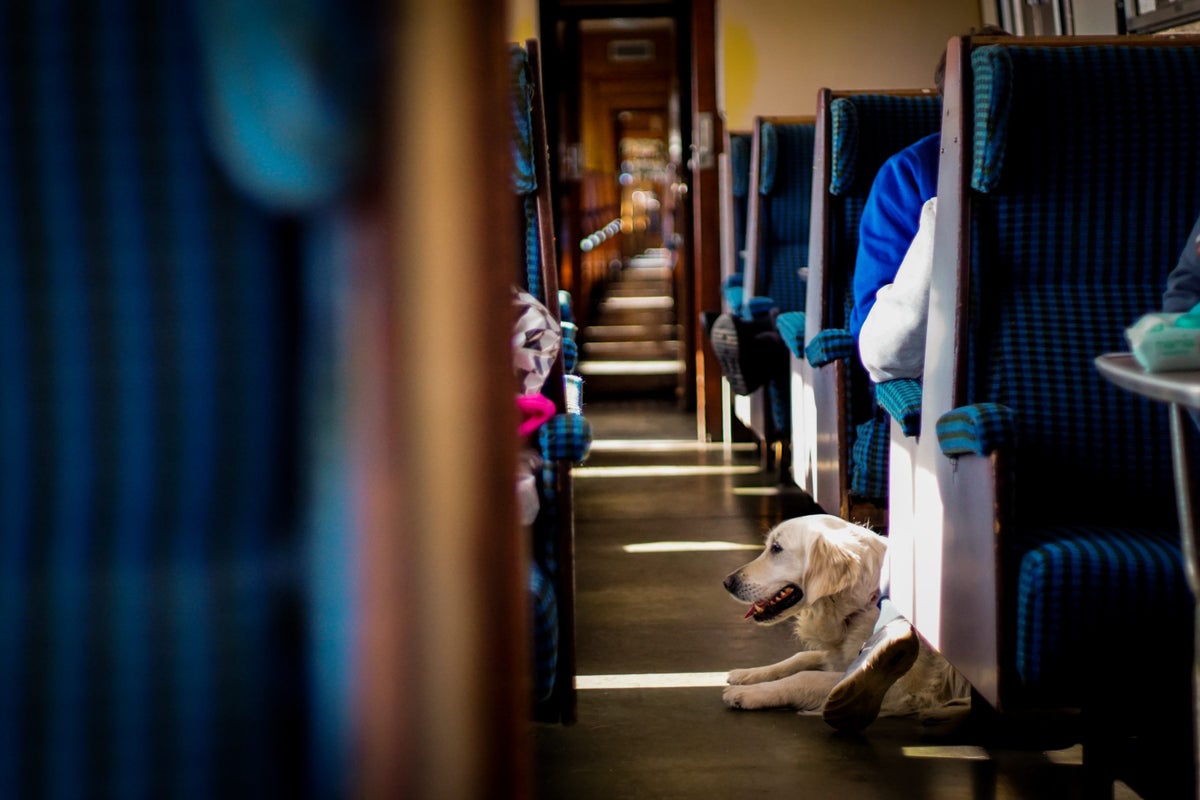
Motion Sickness
Heath and documentation requirements, pet identification, nearest vet, relief breaks, checklist for what to take on board, mainline routes where pets are not permitted, paperwork and health requirements, booking procedure, train systems that allow pets, weight of the carrier and your pet, ventilation, what about large pets, final thoughts.
We may be compensated when you click on product links, such as credit cards, from one or more of our advertising partners. Terms apply to the offers below. See our Advertising Policy for more about our partners, how we make money, and our rating methodology. Opinions and recommendations are ours alone.
When planning your next trip within the U.S., you may not want to leave your 4-legged friend at home. Thankfully, with many train services now allowing small pets to be carried on board, there are alternative options to flying or driving.
Train travel can be much less stressful than flying for both pet and owner, with shorter check-in times and the comfort of having your pet on your lap for the entire journey, rather than under your seat or in the hold compartment.
There’s also the cost to consider, with the likes of Delta Air Lines and United charging from $125 to transport your pet as carry-on, versus Amtrak, where pets can be carried for just $26.
This helpful guide will help you plan for your trip and rounds-up the pet policies for each train operator listed by individual state.
This information relates to pets-only, not officially trained service dogs that are governed under the Americans with Disabilities Act and are permitted to go “where the public is normally allowed to go”.
Things to Consider Pre-Travel
To ensure the well-being of your faithful friend, and that you’re adhering to certain rules, there are some things to consider when planning to take your pet on board a train.
Like humans, some animals can get motion sickness, so it’s advisable to test out some short journeys before embarking on a 7-hour train ride. Be sure to have plenty of water with you to avoid your pet becoming dehydrated as this will only make the motion sickness worse.
As many train operators only permit small pets to be transported within a pet carrier, you’ll need to test out how your pet responds to being inside a cage for long periods.
Many train operators such as Amtrak state that the pet must not be disruptive, so train travel may not be suitable if you have a dog that barks continuously when in their pet carrier.
On local train services, documentation is not likely to be requested by train personnel; however, when using Amtrak services , passengers must sign to certify that their pet is up-to-date with their vaccinations.
To transport a pet between states, most states require that the pet have a recent Certificate of Veterinary Inspection (CVI), which indicates that the pet is clear of rabies and other infectious diseases. Each state has different rules as to when the certificate should be obtained before entering a state, but the most common time period is within 30 days before entry.
Although not mandatory in the U.S., you may want to consider getting your pet micro-chipped for their safety. If your pet became lost in an unknown destination, the likelihood of tracking them down would be far greater with a microchip. You should also make sure that they have a collar with your contact number.
Even if you’re only taking a short trip, it’s still wise to familiarize yourself with your nearest vet just in case they require urgent care while traveling.
If you’re traveling on a long train ride, then you’ll need to ensure there are sufficient relief breaks along your route. Check with the train operator to see if they have any scheduled stops that are more than just a couple of minutes so that you have time to relieve your pet in a suitable location.
- Vet contact details.
- Well-ventilated pet carrier.
- Collar and leash.
- Blankets/jacket if the journey is cold.
- Chew toys for inside their carrier.
- Snacks, food, and plenty of water.
- Food and drink bowls.
- Certificate of Veterinary Inspection (CVI).
Hot Tip: Keep all of your pet’s important items organized with a great dog travel bag .
Amtrak Pet Policy
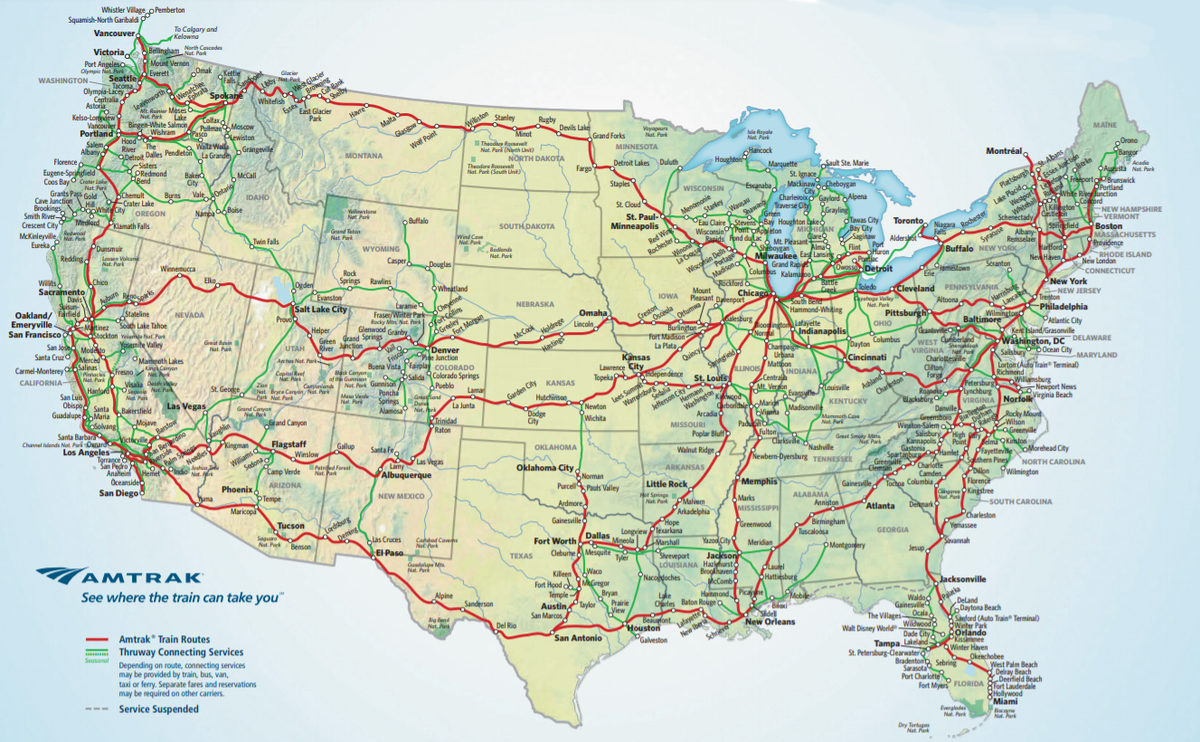
Amtrak permits passengers to bring dogs or cats (up to 20 pounds) onboard many of its train journeys that are 7 hours or less. Pets are not permitted on specific mainline routes or Thruway connecting services (green routes on the above map and detailed by state in the table below).

- Auto Train : Lorton, VA (Washington, DC) – Sanford, FL (Orlando)
- Capital Corridor : Auburn – Sacramento – Emeryville (San Francisco) – Oakland – San Jose
- Keystone Service : NYC – Philadelphia – Paoli – Downingtown – Lancaster – Harrisburg
- Pacific Surfliner : San Luis Obispo – Santa Barbara – Los Angeles – Anaheim – San Diego
- Pennsylvanian : New York – Philadelphia – Lancaster – Harrisburg – Altoona – Pittsburgh
- San Joaquins : San Francisco Bay Area / Sacramento – Bakersfield / Southern California
Amtrak provides the following guidelines and rules for bringing your pet on board:
- Pets must be booked on a reservation with a maximum of 5 pets permitted on each train service, available on a first-come, first-serve basis.
- Only 1 pet is permitted per passenger, and they may only ride in coach class, rather than business class or any sleeper services.
- Pets must be transported in a pet carrier measuring no more than 19 x 14 x 10.5 inches and must be well ventilated and leak proof. The total weight of the pet inside the carrier cannot exceed 20 pounds.
- Pet carriers count towards a passenger’s carry-on allowance and must be placed under the passenger’s seat. Pets are not permitted outside of the carrier for the duration of the journey or in stations.
Hot Tip: The following routes designate pet-specific coaches; whereas, for other pet-friendly routes, pets are permitted in any coach cars: Amtrak Cascades, Blue Water, Carl Sandburg, Hiawatha, Illini, Illinois Zephyr, Lincoln Service, Missouri River Runner, Pere Marquette, Saluki, and Wolverine.
- Passengers must sign a Pet Release and Indemnification Agreement for each segment of the journey.
- Passengers must check-in at the ticket desk no later than 30 minutes before the train departs, to allow time to complete the pet release paperwork.
- Pets must be 8 weeks or older to travel on Amtrak services and be odorless and non-disruptive to other passengers.
- Passengers will certify that their pet is up-to-date with all required vaccinations before travel.
Pets can be booked onto a reservation at Amtrak.com or by calling 800-USA-RAIL. Bookings can also be made in person at an Amtrak ticket desk.
Hot Tip: Pets can travel on board Amtrak services for $26 .
Hot Tip: Need ideas on the best trips to take with your furry friend? Check out our piece on the 15 Most and Least Pet-Friendly Vacation Spots in the U.S. .
Pet Carriers
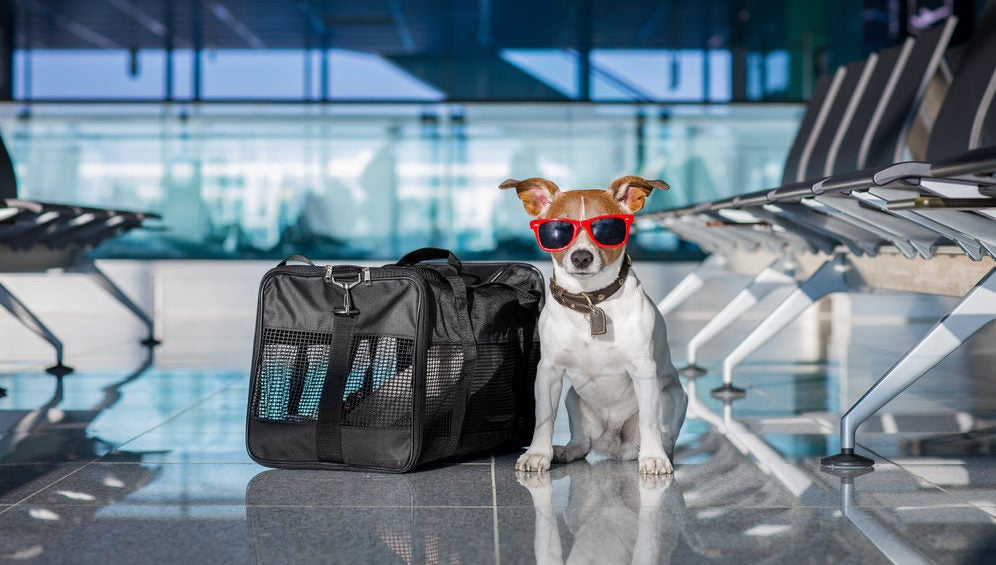
When looking for the perfect pet carrier, there a few things you should consider.
Amtrak and some other train operators have weight restrictions that are usually the weight of your pet and the carrier combined. If your pet is on the heavier side, you’ll need to find a lightweight, soft carrier that is also robust enough to accommodate the weight of your pet.
Choosing the correct size of carrier for your pet is an important decision. Too big and your pet could move around, making it difficult to balance and carry. Too small and it would be uncomfortable for your pet, restricting space to stand up or stretch. As a rule of thumb, your pet carrier should be around 1.5 times the size of your pet.
Traveling on a train can be hot at times, so it’s advisable to choose a pet carrier that has mesh sides to allow airflow to keep your faithful friend cool.
Owners have the choice between hard and soft shell pet carriers, and the decision will depend entirely on your circumstances and preference. Hardshell carriers are more robust, provide more protection, and are easier to keep clean; whereas, soft carriers can offer more comfort, are lighter, and easier to store.
Hot Tip: Make sure you’re earning points for your pet purchases. Check out our guide to the best credit cards to use for pet expenses.
As you can see from the table above, most train operators stipulate that only “small pets” may be carried on board, so train travel is unfortunately not yet widely accessible to larger animals.
However, some passengers do try to bend the rules of certain operators such as the New York Subway that states “No person may bring any animal on or into any conveyance or facility unless enclosed in a container and carried in a manner which would not annoy other passengers.”
Over the years, there’s been controversy over the number of pet-related deaths during transit in both the cabin and cargo hold of an airplane; in fact, we did a whole study on the best airlines for pets for that exact reason. Traveling on a train with your pet can be a more relaxed and safer mode of transport for your pet.
Some pets can struggle with the pressure from an airplane’s increased altitude, causing issues with breathing. In fact, this has caused some airlines to prohibit the hold transportation of snub-nosed breeds, such as pugs and bulldogs.
If you’ve got a small pet that you would like to travel with you, train travel is the ideal mode of transport, being relatively cheap and safe. Looking for more information on traveling with your 4-legged friend? Explore our ultimate guide on traveling with your pet .
Frequently Asked Questions
Are pets allowed on trains.
In the United States, pets are allowed on some trains and it is becoming increasingly common that pets are permitted. Amtrak allows pets up to 20 pounds on many routes (with restrictions on certain routes). The table above lists details of pet policies for train operators within each state.
How do you travel with a cat on a train?
To take your cat on a train, they should be inside a suitable pet carrier that is well ventilated and leak-free. This should be placed under your seat or kept on your lap. Ensure you have plenty of water and are able to stop for relief breaks if the journey is long.
How do you travel with a dog on a train?
When traveling with a dog on a train, they should be inside a suitable pet carrier that is well ventilated and leak-free. This should be placed under your seat or kept on your lap. Ensure you have plenty of water and are able to stop for relief breaks if the journey is long. Your dog should not cause any disruption to other passengers, otherwise you may be asked to disembark.
Can dogs travel on trains in the U.S.?
Some U.S. train operators, such as Amtrak, allow pets on board. Dogs up to 20 pounds are permitted to ride on many routes (some restricted routes apply) providing they remain within an enclosed pet carrier for the duration of the journey.
Was this page helpful?
About Amar Hussain
Amar is an avid traveler and tester of products. He has spent the last 13 years traveling all 7 continents and has put the products to the test on each of them. He has contributed to publications including Forbes, the Huffington Post, and more.
INSIDERS ONLY: UP PULSE ™

Get the latest travel tips, crucial news, flight & hotel deal alerts...
Plus — expert strategies to maximize your points & miles by joining our (free) newsletter.
We respect your privacy . This site is protected by reCAPTCHA. Google's privacy policy and terms of service apply.
Related Posts
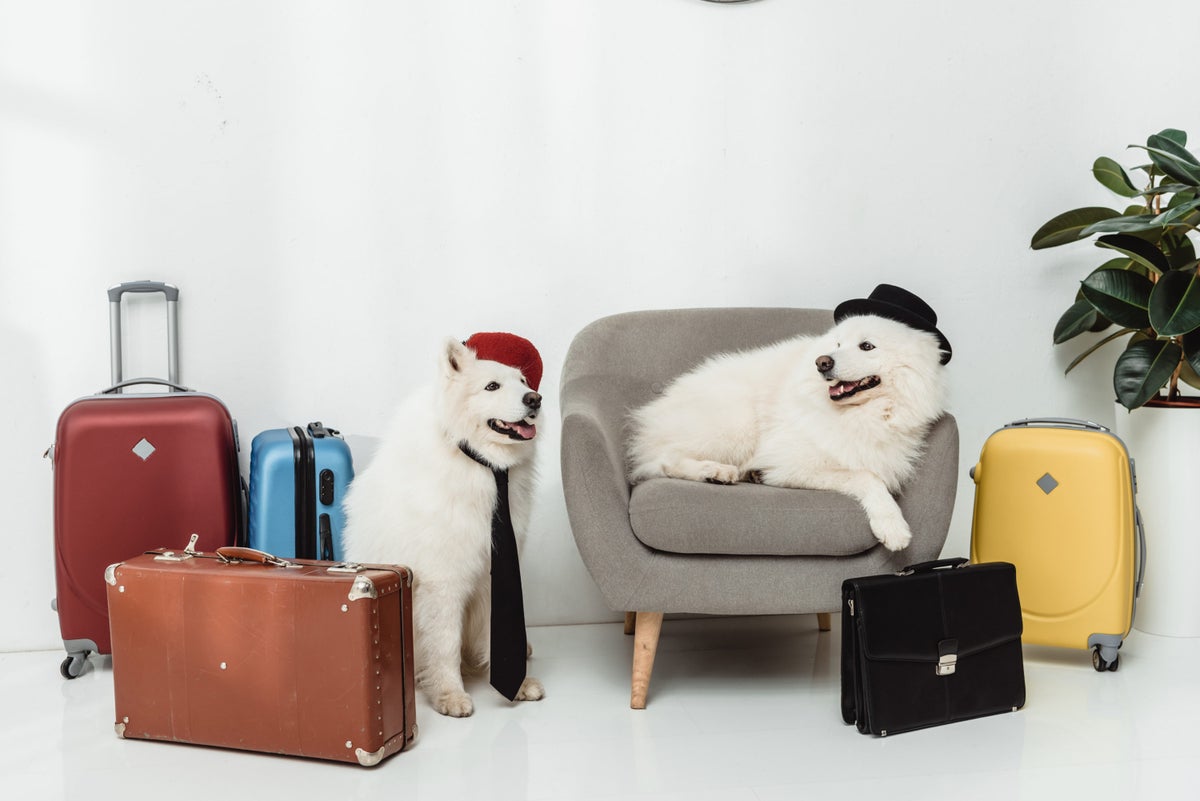
UP's Bonus Valuation
This bonus value is an estimated valuation calculated by UP after analyzing redemption options, transfer partners, award availability and how much UP would pay to buy these points.

IMAGES
COMMENTS
5. A crate, car seat, and/or seatbelt are necessary. Safety is important when you're on the road. If you stop short, slam on the brakes, or get into an accident, your dog can get seriously hurt. To protect your dog, make sure to secure them while in the vehicle. For medium to large dogs, try a crate or dog seatbelt.
A few dog carrier tips for car travel: Make sure that whatever carrier or crate you get is large enough for your dog to stand, sit, lie down and turn around in. Place the carrier in the back seat, and then thread the seat belt through the handle. (Unsecured carriers can slide around on the seat.)
Get Your Dog Used to Their Car Safety Equipment Be sure to get your dog's travel carrier or harness ahead of the trip to get them used to it and to ensure you purchased the right size.
Consult your veterinarian to create the best travel plan for your dog if he does not travel well. Strategies to de-stress dog road trips include: A Thundershirt® swaddles the dog like an infant is swaddled, and can reduce anxiety. A pheromone calming collar can help reduce anxiety. Medication prescribed by your veterinarian: trazodone (brand ...
Car travel with dogs, especially long trips, requires some forethought. You can't just assume you'll be able to get everything you need for your pet during your trip. 10 Tips for Safe Car Travel
2. Introduce your dog to the cage, if you are using one. Present the cage to your dog positively. Allow the dog to sniff the cage before it goes in the car. Once the cage is placed in the car, lock your dog in it. Continue your positive attitude about the cage and walk away from the dog in the cage for several minutes.
However, traveling with dogs in a car can pose some safety concerns. Read on to learn more about safety tips for car travel with dogs. Bring Health Records. Planning ahead when traveling with dogs in a car is important. Ensure your pup is up to date on vaccinations and has identification tags with current information on their collar.
Keep your dog safe while driving. According to the Whole Dog Journal, the safest way to travel with a dog in the car is by securing them in a dog travel crate. in the car for your dog is within a secure crate or a harness restraint in the back seat. If you have room for a crate in your car, this is definitely what we'd recommend.
Avoid carsickness by letting your dog travel on an empty stomach. However, make sure they have plenty of water at all times. Keep the car well-ventilated. If the dog is in a crate, make sure that ...
How to travel with 2 dogs in car - Start with a medium to large vehicle. Keeping one dog in the back portion behind a partition and the other in the area behind the front-seat is an option that works for many. You may need to consider using a crate for each dog, if there is any question about whether your dogs tolerate being confined in small ...
Take a look at the results of our best dog car seat belt round-up. 11. Hide his eyes or distract the nose. Some dogs simply prefer not to see where they're going. In such cases, it's best to get a ...
Any necessary medications (including monthly meds, such as heartworm or flea medicine) Dog bed. Two to three favorite toys. Dog-safe wet wipes (for messes) An old bath towel (for big messes) Any training tools (clickers, heel sticks, etc.) you plan on using during the trip. Emergency contact info and resources.
Here are a few tips for car travel with dogs. Make sure your dog wears his tags. The tag should include your name, address, and phone number. Don't forget to include your cell phone number in ...
Pack a few water bottles and a travel-sized water bowl for your dog, and offer them water every time you stop at gas stations or rest stops. This is especially important if your dog doesn't like to drink while the car is in motion. 5. Regular Potty Breaks.
How to travel with a dog cross country. Exercise your dogs before you load them into the car to leave. A tired dog is a better traveler than an energetic one. Don't feed your dog immediately before traveling. Try to feed them 3-4 hours prior to departure to avoid an upset stomach from motion sickness.
A crash-tested harness to travel safely with your dog outside of a crate. Sleepypod. Sleepypod Clickit Sport Dog Safety Harness, available at Sleepypod, $94.99. Sleepypod Clickit Terrain Dog ...
Buckle up your pup. Seatbelts are lifesaving — for people as well as pets. Any time you take your dog in the car it's crucial they are secured. Kennels are the best way to keep your pooch safe and ensure they aren't distracting you while you navigate and drive. However, if you'd prefer to keep an eye on your buddy during your trip, you ...
If you must travel together by car, talk to your veterinarian about possible solutions for car sickness or anxiety. 3. Prepare a Pet Travel Kit. Just like your own travel bag, a kit for driving with dogs should have snacks (dog food and a bowl), drinks (water and a bowl) and entertainment (nylon bones or a favorite toy are a good start).
The owner of Dogletics, a dog training and walking company based in Chicago, is serious about her love of going on road trips with her dogs in tow.So much so, she named one of her two Australian shepherds Haven after her favorite road trip destination of South Haven, Mich., about a two-hour drive from home. On several occasions every year, Lehew loads up her car with 2-year-old Haven and 4 ...
Anti-nausea medicine. You can get this from your vet if it is required by your dog. A current photo of your pet. In case your dog goes missing at a rest stop. Poop bags. Essential for rest stops - make sure you have plenty of them. Extra dog toys. To keep your pooch amused in the crate and on rest stops. Cleaning wipes and paper towels.
5 Top Tips For Car Travel with Dogs. If you've determined your dog can handle the trip, ok! Time to think about how to make the journey easiest. Hit the road with your furry family member in tow with these 5 simple tips to ensure they enjoy the journey too. 1. Store Pet Food With Care.
The best cars for dogs are fitted with ample storage space, foldable seats, rear air vents, and childproof locks. You'll also want upholstery material that's easy to clean and doesn't retain doggy odors. 2. Decide Where Your Dog Will Ride. The rear seats and cargo area are the best places for a big dog to ride.
A dog car harness that buckles into a seat belt or clips to cargo tie-down is an option that works for most dogs and vehicles. A car harness for dogs can create a safer, more comfortable ride for your pup. When it comes to picking a dog harness, we recommend the PetSafe Deluxe Harness. This harness works with any seatbelt and can also be used ...
Tips for Leaving Your Dog in the Car (Travel Hack #3) At some point, you will need to leave your dog unattended in the vehicle. It is almost unavoidable, especially if you are traveling solo. There are a few things people do that can really help when you need to leave your dog in the car to use the bathroom, grab something to eat, etc. ...
Max pet weight is 75 lb. The tightening/loosening mechanism takes some getting used to. If you're looking for a walking harness and a safety-certified car restraint, the Sleepypod Clickit Sport is ...
If your dog travels with you on family road trips or when you're running errands, you'll want to ensure it's safe from point A to point B. Just because your dog likes to poke its head out ...
2023 Volvo V60. 2023 Honda CR-V. 2023 Kia Soul. 2023 Tesla Model 3. 2023 Honda Odyssey. 1 of 14. On the following slides, you'll find cars, crossovers and SUVs that have lots of pet-friendly features, such as durable cabin designs, big cargo areas suitable for travel crates and flat-folding rear seats. Some manufacturers even offer dog ...
Next, start with short rides with your dog, maybe around the block or to a nearby park. This gradual introduction to the car can help them get used to the sights, sounds, and sensations associated ...
Only 1 pet per passenger is permitted, and if transporting on the passenger's lap or the floor, then the carrier must not exceed 17 x 10 x 10 inches. If transported in the coach luggage tower then the carrier must not exceed 28 x 20.5 x 21.5 inches. Miami Metromover. Pets are permitted in a secure, enclosed carrier.